
- Post author: Kylie Hubbard
- Post published: May 18, 2021
When you think of tiger tourism, you might remember the release of Tiger King last March. If you remember anything from the show, it might be Joe Exotic and his countless attempts to obtain and profit from big cats, including tigers. The conservation and animal welfare issues with Joe Exotic’s Greater Wynnewood Exotic Animal Park weren’t really shown in the Netflix original series.
That’s right, petting tigers and taking selfies with them might make you happy and possibly up your Tinder profile, but the damage to these big cats and the conservation of this endangered species could be irreversible. If you’re wondering how you can help and still observe tigers ethically, I’ve broken it all down here.

About tigers
First, it’s important to remember that tigers aren’t actually snuggly animals in the wild like they appear to be in captivity. They are solitary animals, which unfortunately makes them a big gain for hunters looking for a trophy or to sell on the black market as body parts for traditional Chinese medicine. They’re elusive and scarce, making a sighting a lot more prized.
Tigers are also massive and the largest of all Asian big cats. There are around 3,900 tigers left in the world, according to the latest census. Female tigers give birth to two to four cubs every two years.
This post may contain affiliate links. Please see our disclosure .
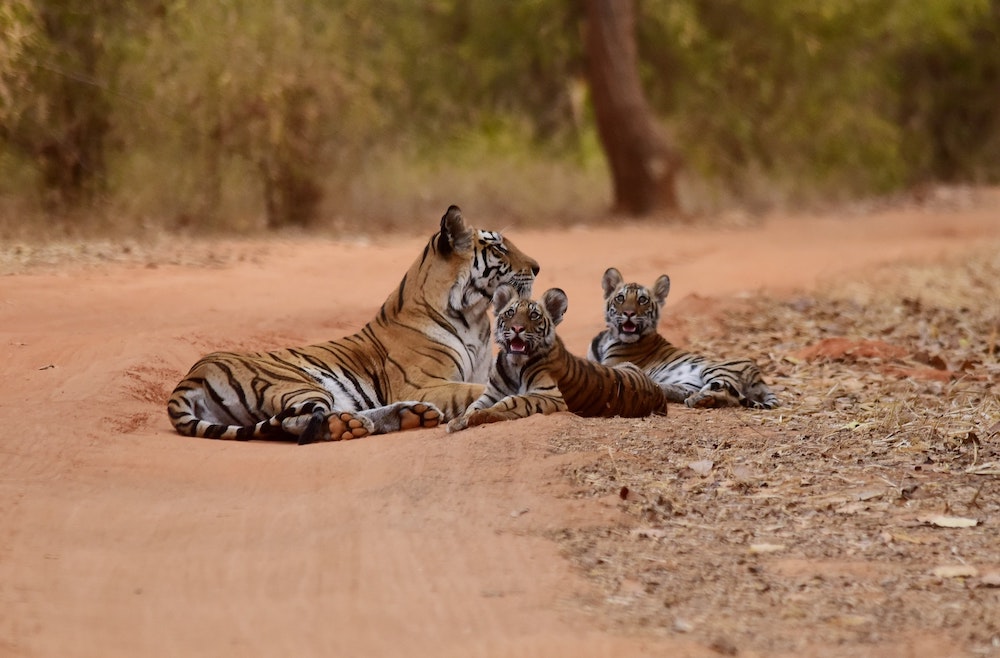
Tiger subspecies
Before the 20th century, there were 8 subspecies of tiger. Three became extinct during the 20th century, and the five remaining subspecies are at risk.
- Bengal : Sometimes called Indian tigers, Bengal tigers are the most common tiger and make up about half of all the wild tiger population. Over the centuries, Bengal tigers have become an important part of Indian tradition and lore. On average, a Bengal tiger lives to be 8 to 10 years old and can weigh on average up to 500 pounds.
- Indochinese : This subspecies of tigers are also known as “Corbett Tiger” and inhabit a small region of Southeast Asia. In 2004, the Indochinese tiger was split from the Malayan tiger and considered a different subspecies. It’s a relatively small species and has a darker orange coat with narrower dark stripes.
- Sumatran : It’s estimated that less than 400 Sumatran tigers are left in the wild today. Distinguished by their heavy black stripes, their rapid population decline is caused by accelerated deforestation and rampant poaching. While all tiger subspecies are at risk, Sumatran tigers are critically endangered.
- Siberian : These giant tigers are the world’s largest cats. Siberian tigers live primarily in Eastern Russia in the birch forests, but some can be found in China and North Korea. Siberian tigers can weigh up to 700 pounds.
- Malayan : These tigers are the most recently recognized subspecies of tigers and are the national animal of Malaysia. Malayan tigers were split from the Indochinese tiger subspecies in 2004. There is limited information about Malayan tigers, but they are thought to be smaller than the tigers living in India.
Quick look at tigers
- Lifespan — In the wild, tigers live on average to be between 8 and 10 years old. Historically, tigers live longer in captivity, with lifespans of 14 to 16 years. The oldest tiger in history was named Flavio. Flavio was rescued from 13 years of doing circus shows, and he lived to the age of 25 years old in captivity. But, do not equate longer life to mean better quality of life. Captivity eliminates natural causes of death for the most part.
- Weight — As you might expect, males tend to be larger and females smaller when it comes to tiger weight. On average, tigers weigh between 150 and 700 pounds. The largest tiger on record is an 845-pound Siberian.
- Diet — Tigers are carnivores and eat mostly large prey like deer, wild boar, and even elephant calves. They take down their prey by lunging at the animal’s neck and holding on tight with their powerful jaws.
- Conservation status — Each subspecies of tiger is at risk, classified as endangered on the Red List of Threatened Species published by the International Union for Conservation of Nature.
About tiger habitats
Tigers can be found in a diverse array of habitats, including rainforests, grasslands, savannas, and mangrove swamps. But, the habitats available to tigers are diminishing, with about 93% of historical tiger lands having disappeared . Land once inhabited by tigers has been diminished due to the expansion of human activity.
Fun facts about tigers
- Tigers are the largest felines in the world amongst wild cats. They’re also the third largest carnivore on land behind polar bears and black bears.
- Tigers are nocturnal creatures and are often solitary.
- Tiger cubs are born blind, relying on their mother for at least a few weeks as a newborn. Female cubs are the sole provider for cubs until up to two years after birth.
- While tigers are solitary, they are also playful. You can see them scum and play in the water.
- Tigers can sprint up to 60 kilometers per hour and can climb trees, although they seldom do.
- Tigers can roar, but they do not purr.
- No two tigers have the same stripes. Just like our fingerprints or a snowflake’s design, each is unique.
- A tiger’s tail is about 3 feet long and helps them maintain balance.
- The big padded paws of tigers make it easier for them to silently sneak up on prey.
Why are tigers endangered?
The four biggest threats that endanger the tiger species include poaching, hunting, tourism and palm oil.
- Poaching — While the tiger has long been hailed in Indian and Chinese lore, Traditional Chinese Medicine has kept the illegal trade of tiger bones and body parts vibrant. In addition to illegally trading body parts, the skin of tigers is highly profitable for poachers, making the thrill of catching a tiger more enticing with a high price tag.
- Hunting — While poaching is hunting, there is another level to hunting tigers. Many big game hunting enthusiasts see big carnivores like tigers as a “bucket list kill.”
- Tourism — By visiting places that have tigers available for petting and selfies, you are directly supporting these tourist traps indirectly supporting the speed breed of tigers. Female tigers in these situations are forced to breed more frequently than in the wild, by having their cubs removed from their care right after birth. This speeds up the gestation period in females.
- Palm oil — 90% of Sumatran tiger habitat has been lost thanks to palm oil plantations. You can stop this spread by not purchasing palm oil and speaking out about the damage the rapidly growing industry is causing to tiger habitat and the rainforest as a whole.
Common tiger tourism activities
There are two main tiger tourism activities: petting tigers and tiger selfies. Both of these are extremely damaging to tiger conservation.
Petting tigers
In most cases, the tigers used for petting experiences are cubs that have been speed bred and removed from their mothers too soon. The constant flashing of camera lights can cause early cataracts in early developing eyes, and human interaction can also expose cubs to diseases. Young tigers often sleep during the day in the wild but often miss that chance in captivity. Usually nocturnal in the wild, they are forced to sleep in the evening. Once they grow past the age of petting, they are often sold on the black market for parts.
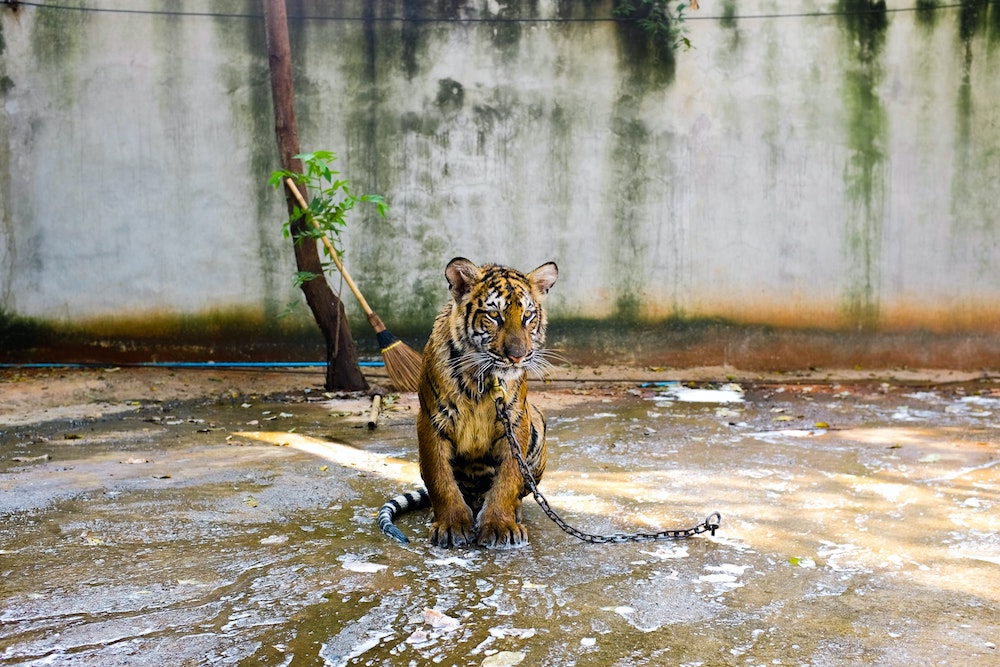
Tiger selfies
Remember when a bunch of men started using photos of them with tigers in their Tinder profiles? Yeah, that’s not cool. Most, if not all, of the photos taken like this are taken with a tiger that has been drugged to sit still. And when the tiger isn’t putting on a show for the selfie, it is caged alone.
Not only is a tiger selfie intentionally supporting this behavior from handlers, but also encourages the mistreatment of animals and implies that they only exist to serve humans’ entertainment.
Tiger tourism – where to see tigers in the wild
Tigers can be found in swamps, grasslands, and rainforests, meaning you can see a tiger in the wild in a variety of countries. From the Russian Far East to parts of North Korea, China, India, and Southwest Asia to the Indonesian island of Sumatra, there’s a chance you could see a tiger or two.
Madhya Pradesh, India
Madhya Pradesh is known as India’s “Tiger State” and is one of the 50 reserves in the country. There is one walking safari, the Satpura reserve, and all other safaris are conducted in Maruti Suzuki Gypsies (or Jeeps). You can book a safari ride for morning, afternoon and sometimes evening with the right local guide.
It’s suggested that you take at least four rides for the best chance to see a tiger. But, even if you don’t catch a tiger, there’s a good chance you’ll see other wildlife like deer, owls, eagles, gaur, langurs, macaques and if you’re lucky, a sloth or jungle cat.
For the most luck spotting a tiger, visit during the pre-monsoon months of April and May.
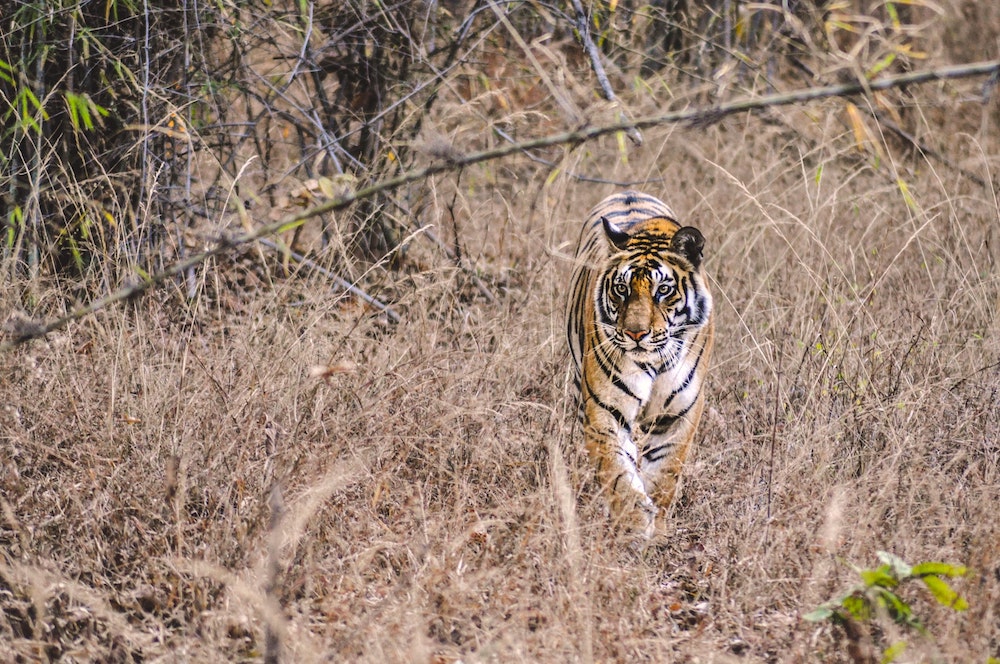
Barcadia National Park, Nepal
The Barcadia National Park is located in the remote northwest of Nepal, and it’s the best spot to see one of the 80-odd tigers that call it home. Each lodge in the national park offers walking and 4WD safaris and while you can cover more ground riding around, you experience intimate wildlife viewings by walking.
In addition to the chance of seeing a tiger, you can also see rhinos, otters, crocodiles, wild elephants and five species of deer.
Although the Barcadia National Park is open year-round, the best times to see them would be the hot season by the river.
The Sundarbans, Bangladesh
The Sundarbans straddle India and Bangladesh and is the world’s largest mangrove forest. Although both sides are an adventure, The Sundarbans is better accessed from the Bangladesh side, where you’ll find deeper access and maximize your chance of seeing a tiger.
To get to The Sundarbans, you hop aboard a multi-day boat tour from Khulna. Eating and sleeping occurs on the main tour boat, but you break into smaller groups and track tigers on foot or by smaller boats.
You’re most likely to spot a tiger in April and May, even though visiting in October through March may be more comfortable. In addition to tigers, you can also spot saltwater crocodiles, wild boar, langurs and many of the 260 bird species in the region.
Durminskoye Reserve, Russia
The Siberian tiger is found primarily in eastern Russia and northern China. Russia became the first country to grant full protection of tigers in 1965, and that act saved them from extinction.
The chance of spotting a tiger is pretty rare, though, and most tours are run like citizen science projects where guests spend their days tracking pug marks and snowmobiles and on foot. While tracking pug marks, you’ll set camera traps and review footage, all in contribution to the protection of the species.
In addition to the slim chance of seeing tigers, you can also see wolves, lynx, badgers, foxes and raptors, and in the summer you may even see an Asian black bear.
For the best conditions to track tigers, visit during the month of November through February.
Ranthambore National Park, Rajasthan, India
Ranthambore National Park is 154 square miles of space where tigers can be found roaming freely through the park. The park is composed of dry deciduous forest, brushland, rocky hills and some of the most beautiful ancient structures.
A fixed number of vehicles are permitted in the park for tracking both morning and afternoon. 40 gypsies and open-sided canters embark on tracking sessions each day. In addition to seeing tigers on the drives, you can also see deer, wild pigs, peacocks, leopards and sloth bears.
The peak months to visit are between October and December.
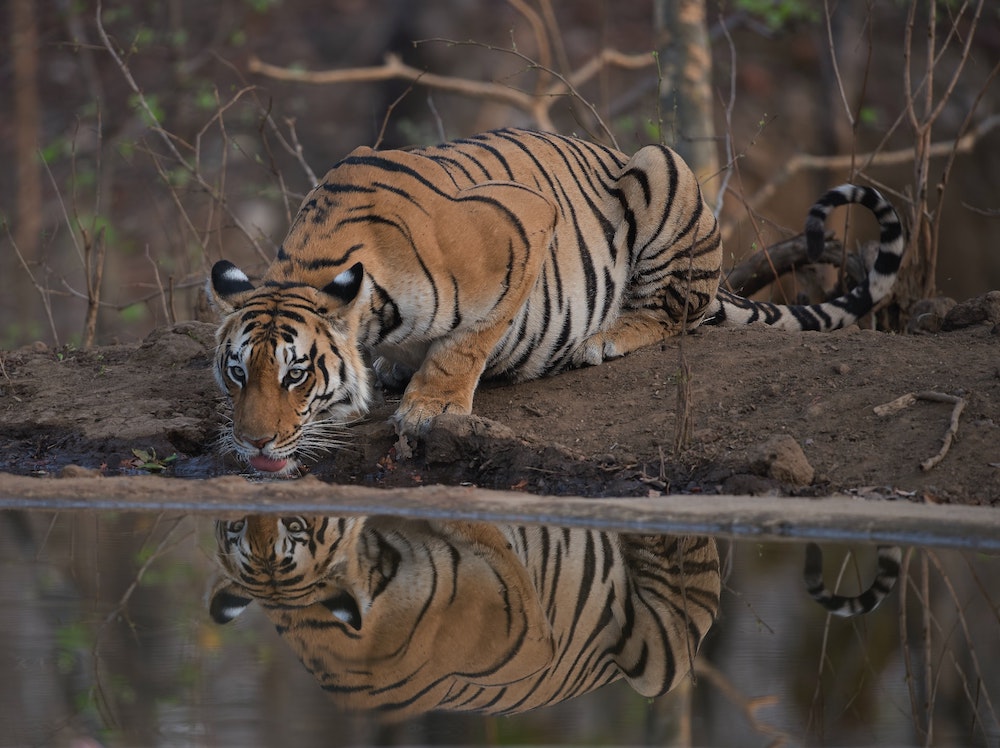
Kerinci Seblat National Park, Sumatra, Indonesia
Kerinci Seblat National Park is the largest national park in Sumatra and has some of the healthiest populations of Indonesian wildlife like elephants, bears, tapirs, clouded leopards, gibbons and more tigers than can be found in all of Indonesia.
But, it won’t be easy to spot a tiger. Many visitors to the national park embark on the climb to Gunung Kerinci, which is the highest active volcano in Southeast Asia. You might see a tiger on your climb if you’re lucky, but do know it’s rare.
Chitwan National Park, Chitwan, Nepal
Chitwan National Park was the first national park in Nepal when it was founded in 1973. Before it was a national park, Chitwan was prime hunting grounds. Talk about a glow up.
In 1984 it became a UNESCO World Heritage Site and is currently protected by the Nepali Army.
You can hop on a jungle safari or join a jungle walk for a chance to see a tiger in the wild. In addition, you could see wildlife like birds, deer, rhinos, crocodiles and monkeys.
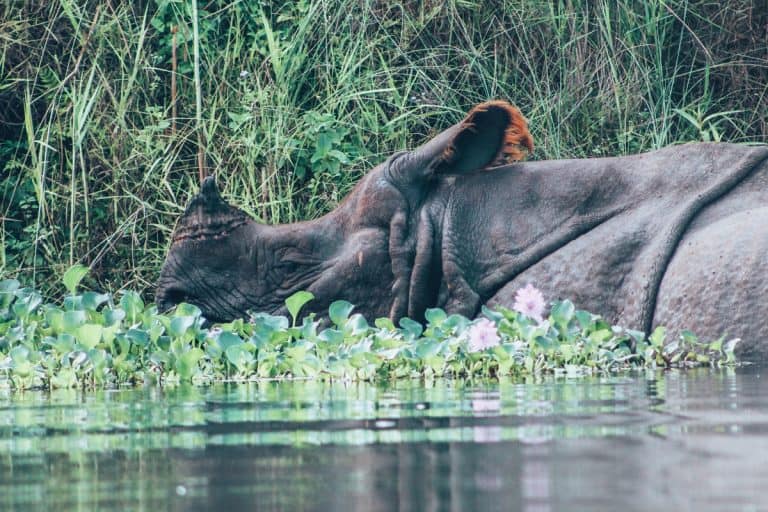
How to help tigers
- The Deer And The Tiger by George Schaller
- Just Tigers by Jim Corbett
- Tigers Forever: Saving the World’s Most Endangered Cat by Steve Winter
- Living With Tigers by Valmik Thapar
- A Decade With Tigers: Supremacy. Solitude. Stripes by Shivang Mehta
- Tiger Matters
- The Tiger Who Crossed the Line
- Download a Palm Oil app to make sure the items you’re purchasing use only sustainable palm oil.
- Spread the word to others!
- Support ethical wildlife sanctuaries , true conservation organizations, and the national parks that these wonderful big cats call home.
- Recent Posts
- 8 of the Best Hikes near Gatlinburg for All Skill Levels and Seasons - November 5, 2023
- 16 Sustainable Swimwear Brands to Check Out This Summer - June 14, 2023
- The Best Shark Gifts for the Shark Enthusiasts - September 7, 2022
You Might Also Like

Cooking Our Way Around the World | Canada

9 Ways OKC Surprised Me + Why it Should be on Your List

Tips For Solo Travel Across The US
Leave a reply cancel reply.

- Privacy Overview
- Strictly Necessary Cookies
This website uses cookies so that we can provide you with the best user experience possible. Cookie information is stored in your browser and performs functions such as recognising you when you return to our website and helping our team to understand which sections of the website you find most interesting and useful.
Strictly Necessary Cookie should be enabled at all times so that we can save your preferences for cookie settings.
If you disable this cookie, we will not be able to save your preferences. This means that every time you visit this website you will need to enable or disable cookies again.

- Call +91 9212777223
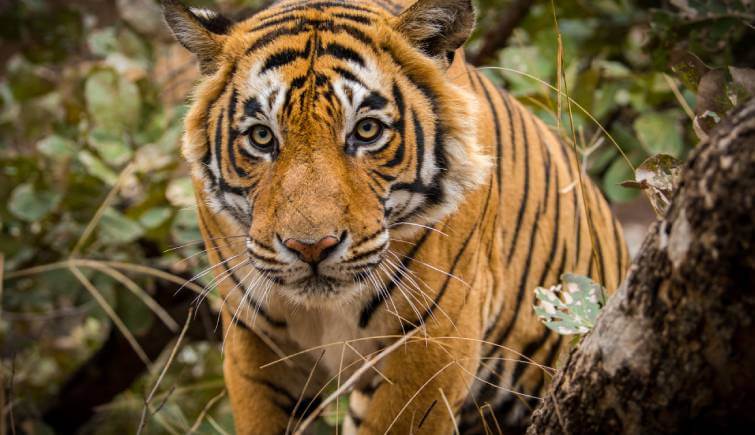
16 Feb, 2023
From benefit to threat: the effects of tourism on tiger conservation.
Tigers are one of the most magnificent and iconic animals on the planet. They are an apex predator, symbolising power, strength, and grace. However, tigers are also one of the most endangered species in the world, with only around 3,900 individuals left in the wild. Despite significant conservation efforts, the primary threat to tigers remains habitat loss, poaching, and the illegal wildlife trade. Tourism has emerged as a potentially powerful tool for tiger conservation, which is now particularly referred to as ‘Tiger Tourism.’ But it also has the potential to create new challenges and risks. In this blog, we will examine the positive and negative impacts of tourism on tiger conservation.
Before that, let’s discuss a little bit about tiger tourism and tiger conservation in the world, as well as in India.
Everything You Need to Know About Tiger Tourism
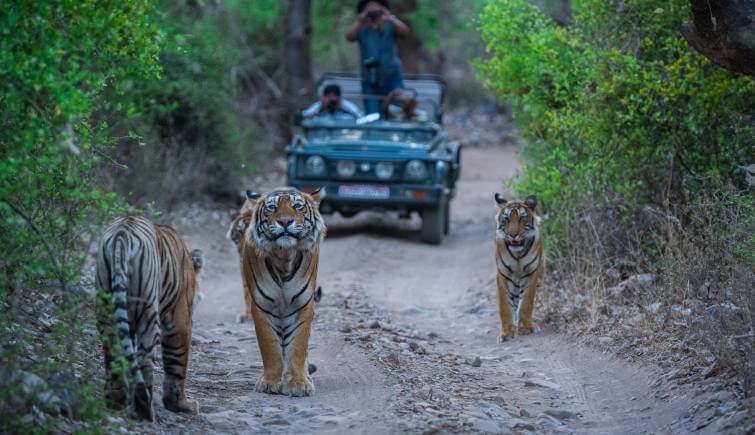
Tiger tourism refers to the practice of visiting national parks and wildlife sanctuaries that are home to wild tigers, with the primary goal of observing and experiencing the majestic animal in its natural habitat. The main purpose of tiger tourism is to promote conservation efforts and raise awareness about the endangered status of tigers.
Tiger tourism activities can take many forms, ranging from guided jeep safaris and walking tours to elephant-back rides and boat trips. Visitors may also stay in accommodations located within or near the protected areas, such as lodges and campsites. During these activities, tourists can encounter tigers in the wild and observe their behaviour, movements, and interactions with other animals in their natural habitat.
Tiger tourism can provide a source of income for local communities, which can help incentivize them to support conservation efforts for protecting tigers and their natural habitat. However, it is important to ensure that effects of tiger tourism activities are conducted in a responsible and sustainable manner, to minimise any negative impacts on the environment and the tigers themselves.
Now, What is Tiger Conservation?
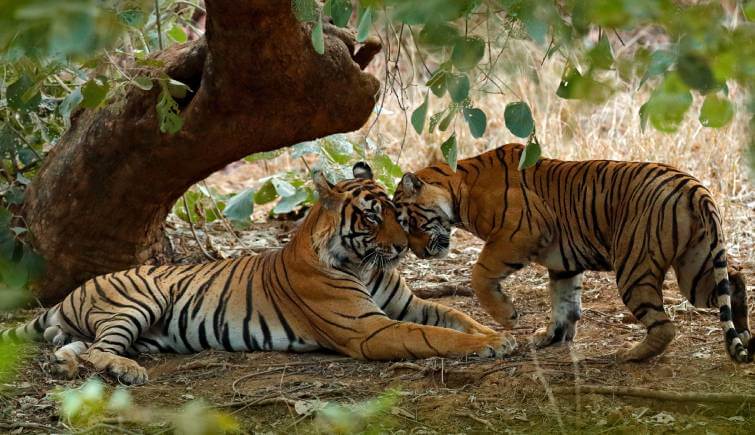
Tiger conservation is the set of efforts and strategies aimed at protecting wild tiger populations from the threats that endanger their survival. Tigers are considered to be one of the most iconic and charismatic species on the planet, but they are also one of the most endangered.
There are a number of threats to tiger populations, including habitat loss, poaching, and human-wildlife conflict. Tiger conservation efforts aim to address these threats and ensure that tiger populations can recover and thrive.
Some of the Key Components of Tiger Conservation Include:

Tigers need large areas of forest to live and hunt, so protecting and restoring their habitat is crucial to their survival.
Poaching is a major threat to tiger populations, as their bones, skin, and other body parts are highly valued in some traditional medicines and as luxury goods. Anti-poaching efforts involve monitoring tiger populations and cracking down on illegal wildlife trade.
As human populations grow and encroach on tiger habitat, conflicts between people and tigers can arise. Efforts to mitigate these conflicts can include measures such as relocating problem tigers or providing compensation to people who have lost livestock or crops to tigers.
Raising awareness about the importance of tiger conservation and the threats facing tiger populations is key to building support for conservation efforts.
Overall, tiger conservation is a complex and multi-faceted field that requires a range of strategies and approaches to be successful.
Let’s discuss about the importance of tourism for tiger conservation:
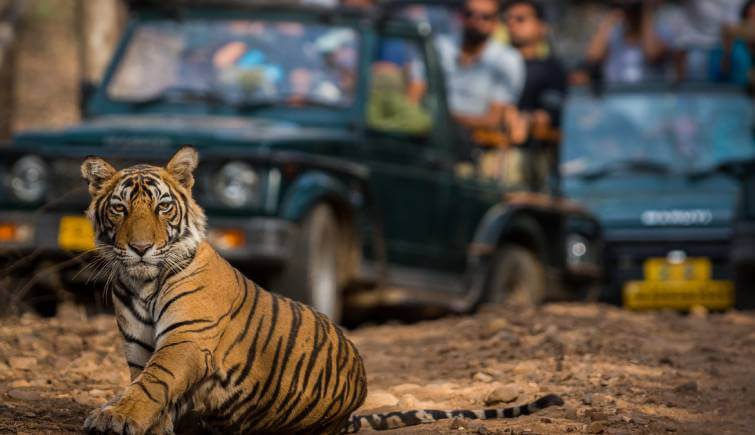
Tourism provides a source of revenue that can be used to fund conservation efforts such as anti-poaching patrols, habitat restoration or protecting forests and community-based conservation initiatives. Revenue generated from tourism can also help support the local economy and reduce reliance on unsustainable practices such as hunting and deforestation.
Tourism provides an opportunity for people to learn about tigers and their conservation. It can also foster a sense of connection and empathy, which may inspire people to take action for protecting tigers and protecting jungles.
Responsible ecotourism can create incentives for the conservation of tiger habitats by encouraging sustainable land use practices, such as community-based conservation and wildlife-friendly agriculture. Ecotourism can also provide an alternative livelihood for local communities that would otherwise rely on destructive practices like logging, poaching, or mining.
Tourism can generate political pressure for better policies and laws that protect tigers and their habitats. The international community can also apply pressure through boycotts or public pressure campaigns, as was the case with the boycott of tourism to Burma in the 1990s and early 2000s.
So, these are the positive impacts on tiger conservation. Now, the question comes, are there any negative impacts of tourism on tigers and other wildlife? The answer is yes. There are lots. Some of the important reasons are discussed below.
Negative Impacts of Tiger Tourism on Tiger Conservation:
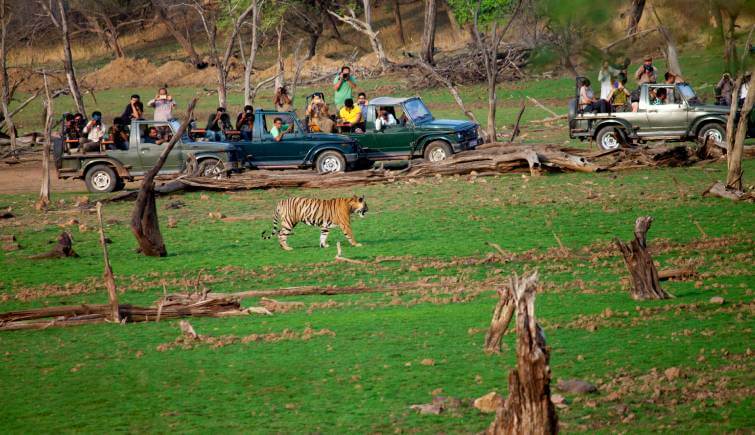
The presence of tourists can disrupt the natural behaviour of tigers, which may have negative consequences for their well-being. For example, tigers may spend more time hiding or avoiding tourist areas, which can affect their ability to hunt and mate. In some cases, the presence of tourists can also lead to aggressive behaviour towards humans or other animals.
The development of tourism infrastructure, such as roads, hotels, and trails, can lead to the fragmentation and degradation of tiger habitats. Habitat loss and fragmentation can increase the risk of inbreeding, reduce genetic diversity, and limit the availability of prey.
Tourism can also create opportunities for poachers and wildlife traffickers to operate. Tourists may unknowingly buy illegal wildlife products or participate in activities that are harmful to tigers, such as posing for photos with captive tigers or attending tiger shows. The demand for these activities and products can fuel poaching and the illegal wildlife trade.
Tourism can create conflicts between tourists and local communities, particularly if the benefits of tourism are not equitably distributed. Local communities may also face environmental impacts such as pollution and habitat degradation, which can affect their livelihoods and well-being.
Tourism can be a powerful tool for tiger conservation, but it must be managed responsibly to ensure that it does not have negative impacts on tigers, their habitats, or local communities. The tiger and tourism debate can go on for centuries like that, but it is also important to remember that responsible ecotourism can provide a sustainable source of income for local communities while also promoting the conservation of tigers and their habitats. To maximise the positive impact of tourism on tiger conservation, it is important to work with local communities and stakeholders to develop and implement sustainable tourism practices that prioritise the long-term health of tigers and their habitats.
- Writer- Nandini
- Photo Credits: Shutter Stock
Frequently Asked Questions
What is the impact of tourism on tiger conservation.
There are positive as well as negative impacts of tourism on tiger conservation. Some of the positive impacts are financial benefits for conservation efforts, sustainable ecotourism, awareness of tiger conservation, whereas some of the negative impacts are disturbance of wildlife behaviour, habitat destruction, etc.
How does responsible tourism benefit tiger conservation?
Responsible tourism can create incentives for the conservation of tiger habitats by encouraging sustainable land use practices, such as community-based conservation and wildlife-friendly agriculture.
Can tourism generate funding for tiger conservation?
How does tourism affect the habitat of tigers, does increased tourism result in the displacement of tigers.
Yes, increased tourism means more development which results in the development of roads, hotels and other related things. It degrades the natural habitat for tigers and other wildlife and displacement of tigers.
Can tourism lead to the destruction of tiger habitats?
Limited tourism does not affect the tiger habitats but increased limit of tiger tourism leads to the destruction of tiger habitats.
Does increased tourism lead to an increase in tiger poaching?
Tourism can also create opportunities for poachers and wildlife traffickers to operate. Tourists may unknowingly buy illegal wildlife products or participate in activities that are harmful to tigers, such as posing for photos with captive tigers or attending tiger shows.
Does increased tourism lead to an increase in human-tiger conflicts?
The presence of tourists can also lead to aggressive behaviour towards humans or other animals. Increased tourism can disrupt their lifestyle which leads to an increase in human-tiger conflicts.
How can responsible tourism practices be promoted to ensure the positive impact of tourism on tiger conservation?
Responsible tourism practices can play an important role in promoting the positive impact of tourism on tiger conservation. Encouraging tourists to participate in ecotourism activities can help promote responsible tourism practices that benefit tiger conservation. Tourism operators should follow tiger-friendly tourism practices that minimise disturbance to tigers, protect their habitat, and avoid direct contact with them. Tourists should be educated on tiger conservation and how their tourism activities can help or harm tiger populations. Tourists should be informed about responsible tourism practices and how they can contribute to tiger conservation. Overall, promoting responsible tourism practices that benefit tiger conservation requires a multi-stakeholder approach that involves tourists, tourism operators, local communities, and conservation organisations. By working together, we can ensure that tourism has a positive impact on tiger conservation and helps protect this iconic species for future generations.
Should the number of tourists be controlled to ensure the positive impact of tourism on tiger conservation?
Controlling the number of tourists can be one approach to ensure the positive impact of tourism on tiger conservation, but it may not be the only solution or the most effective one. Tourism can be an important source of income and employment for local communities, and it can help raise awareness and support for tiger conservation efforts. However, uncontrolled tourism can also have negative impacts on tiger habitats and populations, such as disturbing their natural behaviour, causing stress and disease, and damaging their habitat. Controlling the number of tourists can be one part of a larger strategy to ensure the positive impact of tourism on tiger conservation, but it should be considered in the context of broader efforts to promote responsible and sustainable tourism practices and address the underlying drivers of tiger habitat loss and poaching.
Explore Popular Ranthambore Wildlife Tour Packages
- Information Trinetra Ganesh Temple Ranthambore
- Ranthambore National Parks Latest News Updates
- Best Luxury Resorts in Ranthambore National Park
- Peacock Flying in Ranthambore National Park
- Take a Jungle Safari at These 10 Best Wildlife Destinations in Summer Season & Get the Best of Wildlife Adventure
- The Inspiring Story of How Aditya & Poonam Singh Made a Lush Forest Out of a Barren Land in Ranthambore
- Why Should We be Teaching Wildlife Conservation in Schools?
- Do’s and Don’ts of Staying Safe Around Wildlife
- Human – Wildlife Conflict in Concrete Jungle
- 20 Facts You Probably Didn’t Knew About Tigers
- Wildlife Conservation Initiatives by Indian Government
- Experience Golden Triangle India with Ranthambore Tiger Safari
- 10 Reasons to Visit Ranthambore Tiger Reserve in Rajasthan
- In Pictures: Showcasing India’s Endangered Species
- My Experience at Ranthambore National Park- Sundeep Kheria
- Top 5 Star Hotels in Ranthambore Tiger Reserve
- Photography Tour in Ranthambore National Park
- Rajiv Gandhi Regional Museum of Natural History
Popular Posts

20 Facts You Probably Didn’t Knew About Tige...
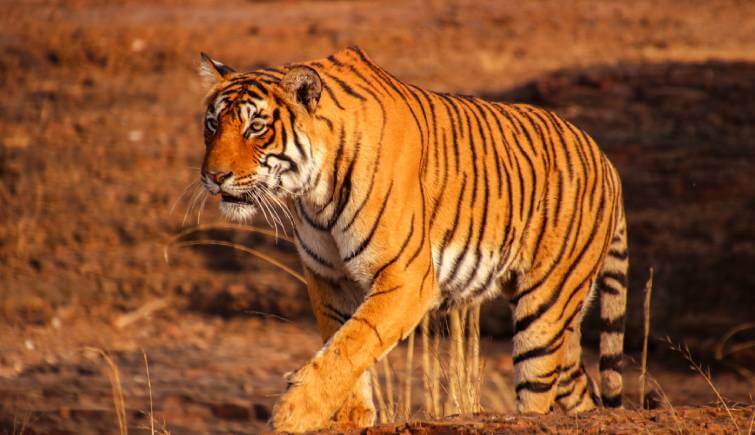
Top 5 National Parks for Guaranteed Tiger Sighting...

The Trinetra Ganesha Temple – Best Places to Vis...
Recent Posts
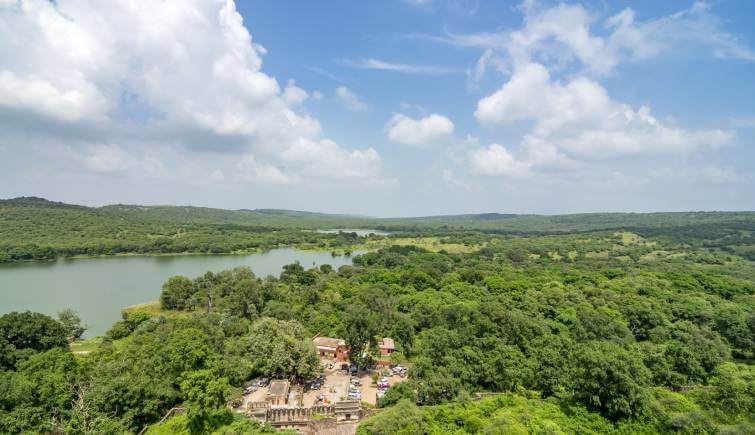
6 Best Wildlife & Nature Weekend Destinations...

Gujarat Titans Visit at Ranthambore National Park...

Bollywood Actress Shilpa Shetty on an Adventure Sa...
Select Country Afghanistan Albania Algeria American Samoa Andorra Angola Anguilla Antigua and Barbuda Argentina Armenia Armenia Aruba Australia Austria Azerbaijan Azerbaijan Bahamas Bahrain Bangladesh Barbados Belarus Belgium Belize Benin Bermuda Bhutan Bolivia Bonaire Bosnia and Herzegovina Botswana Bouvet Island (Bouvetoya) Brazil British Indian Ocean Territory (Chagos Archipelago) British Virgin Islands Brunei Darussalam Bulgaria Burkina Faso Burundi Canada Cambodia Cameroon Cape Verde Cayman Islands Central African Republic Chad Chile China Christmas Island Cocos (Keeling) Islands Colombia Comoros Congo Congo Cook Islands Costa Rica Cote d'Ivoire Croatia Cuba Curaçao Cyprus Cyprus Czech Republic Denmark Djibouti Dominica Dominican Republic Ecuador Egypt El Salvador Equatorial Guinea Eritrea Estonia Ethiopia Falkland Islands (Malvinas) Faroe Islands Fiji Finland France French Guiana French Polynesia French Southern Territories Gabon Gambia Georgia Georgia Germany Ghana Gibraltar Greece Greenland Grenada Guadeloupe Guam Guatemala Guernsey Guinea Guinea-Bissau Guyana Haiti Heard Island and McDonald Islands Holy See (Vatican City State) Honduras Hong Kong Hungary Iceland India Indonesia Iran Iraq Ireland Isle of Man Israel Italy Jamaica Japan Jersey Jordan Kazakhstan Kazakhstan Kenya Kiribati Korea Korea Kuwait Kyrgyz Republic Lao People's Democratic Republic Latvia Lebanon Lesotho Liberia Libyan Arab Jamahiriya Liechtenstein Lithuania Luxembourg Macao Macedonia Madagascar Malawi Malaysia Maldives Mali Malta Marshall Islands Martinique Mauritania Mauritius Mayotte Mexico Micronesia Moldova Monaco Mongolia Montenegro Montserrat Morocco Mozambique Myanmar Namibia Nauru Nepal Netherlands Netherlands Antilles New Caledonia New Zealand Nicaragua Niger Nigeria Niue Norfolk Island Northern Mariana Islands Norway Oman Pakistan Palau Palestinian Territory Panama Papua New Guinea Paraguay Peru Philippines Pitcairn Islands Poland Portugal Puerto Rico Qatar Reunion Romania Russian Federation Rwanda Saint Barthelemy Saint Helena Saint Kitts and Nevis Saint Lucia Saint Martin Saint Pierre and Miquelon Saint Vincent and the Grenadines Samoa San Marino Sao Tome and Principe Saudi Arabia Senegal Serbia Seychelles Sierra Leone Singapore Sint Maarten (Netherlands) Slovakia (Slovak Republic) Slovenia Solomon Islands Somalia South Africa South Georgia & S. Sandwich Islands Spain Sri Lanka Sudan Suriname Svalbard & Jan Mayen Islands Swaziland Sweden Switzerland Syrian Arab Republic Taiwan Tajikistan Tanzania Thailand Timor-Leste Togo Tokelau Tonga Trinidad and Tobago Tunisia Turkey Turkey Turkmenistan Turks and Caicos Islands Tuvalu U.S. Virgin Islands U.S. Minor Outlying Islands Uganda Ukraine United Arab Emirates United Kingdom United States Uruguay Uzbekistan Vanuatu Venezuela Vietnam Wallis and Futuna Western Sahara Yemen Zambia Zimbabwe
Useful Links
- Safari Timing
- Safari Booking
- Holiday Packages
- Famous Tiger Story
- Tiger Special Tours
- Tiger Trails India
- Bird Watching Tours
- Golden Triangle with Tigers
- Golden Triangle with Ranthambore
- Ranthambore Weekend Package
- Taj Mahal and Ranthambore Tour
- Ranthambore Corbett Tour with Agra
- Ranthambore Park Special Package
Our Sales Office
C-81C, Sector-8, Noida
+91-120-4052615-99(85 hunting lines are available)
Connect with Us

Ranthambore National Park. All rights reserved. © 2024
- We Accept :

Arrival Date
Departure Date
Country —Please choose an option— Afghanistan Albania Algeria American Samoa Andorra Angola Anguilla Antigua and Barbuda Argentina Armenia Armenia Aruba Australia Austria Azerbaijan Azerbaijan Bahamas Bahrain Bangladesh Barbados Belarus Belgium Belize Benin Bermuda Bhutan Bolivia Bonaire Bosnia and Herzegovina Botswana Bouvet Island (Bouvetoya) Brazil British Indian Ocean Territory (Chagos Archipelago) British Virgin Islands Brunei Darussalam Bulgaria Burkina Faso Burundi Canada Cambodia Cameroon Cape Verde Cayman Islands Central African Republic Chad Chile China Christmas Island Cocos (Keeling) Islands Colombia Comoros Congo Congo Cook Islands Costa Rica Cote d'Ivoire Croatia Cuba Curaçao Cyprus Cyprus Czech Republic Denmark Djibouti Dominica Dominican Republic Ecuador Egypt El Salvador Equatorial Guinea Eritrea Estonia Ethiopia Falkland Islands (Malvinas) Faroe Islands Fiji Finland France French Guiana French Polynesia French Southern Territories Gabon Gambia Georgia Georgia Germany Ghana Gibraltar Greece Greenland Grenada Guadeloupe Guam Guatemala Guernsey Guinea Guinea-Bissau Guyana Haiti Heard Island and McDonald Islands Holy See (Vatican City State) Honduras Hong Kong Hungary Iceland India Indonesia Iran Iraq Ireland Isle of Man Israel Italy Jamaica Japan Jersey Jordan Kazakhstan Kazakhstan Kenya Kiribati Korea Korea Kuwait Kyrgyz Republic Lao People's Democratic Republic Latvia Lebanon Lesotho Liberia Libyan Arab Jamahiriya Liechtenstein Lithuania Luxembourg Macao Macedonia Madagascar Malawi Malaysia Maldives Mali Malta Marshall Islands Martinique Mauritania Mauritius Mayotte Mexico Micronesia Moldova Monaco Mongolia Montenegro Montserrat Morocco Mozambique Myanmar Namibia Nauru Nepal Netherlands Netherlands Antilles New Caledonia New Zealand Nicaragua Niger Nigeria Niue Norfolk Island Northern Mariana Islands Norway Oman Pakistan Palau Palestinian Territory Panama Papua New Guinea Paraguay Peru Philippines Pitcairn Islands Poland Portugal Puerto Rico Qatar Reunion Romania Russian Federation Rwanda Saint Barthelemy Saint Helena Saint Kitts and Nevis Saint Lucia Saint Martin Saint Pierre and Miquelon Saint Vincent and the Grenadines Samoa San Marino Sao Tome and Principe Saudi Arabia Senegal Serbia Seychelles Sierra Leone Singapore Sint Maarten (Netherlands) Slovakia (Slovak Republic) Slovenia Solomon Islands Somalia South Africa South Georgia & S. Sandwich Islands Spain Sri Lanka Sudan Suriname Svalbard & Jan Mayen Islands Swaziland Sweden Switzerland Syrian Arab Republic Taiwan Tajikistan Tanzania Thailand Timor-Leste Togo Tokelau Tonga Trinidad and Tobago Tunisia Turkey Turkey Turkmenistan Turks and Caicos Islands Tuvalu U.S. Virgin Islands U.S. Minor Outlying Islands Uganda Ukraine United Arab Emirates United Kingdom United States Uruguay Uzbekistan Vanuatu Venezuela Vietnam Wallis and Futuna Western Sahara Yemen Zambia Zimbabwe
No of Person

Premium Content

- WILDLIFE WATCH
Suffering unseen: The dark truth behind wildlife tourism
Captive wild animal encounters are hugely popular, thanks partly to social media. But our investigation shows many creatures lead dismal lives.
I’ve come back to check on a baby. Just after dusk I’m in a car lumbering down a muddy road in the rain, past rows of shackled elephants, their trunks swaying. I was here five hours before, when the sun was high and hot and tourists were on elephants’ backs.
Walking now, I can barely see the path in the glow of my phone’s flashlight. When the wooden fence post of the stall stops me short, I point my light down and follow a current of rainwater across the concrete floor until it washes up against three large, gray feet. A fourth foot hovers above the surface, tethered tightly by a short chain and choked by a ring of metal spikes. When the elephant tires and puts her foot down, the spikes press deeper into her ankle.
Meena is four years and two months old, still a toddler as elephants go. Khammon Kongkhaw, her mahout, or caretaker, told me earlier that Meena wears the spiked chain because she tends to kick. Kongkhaw has been responsible for Meena here at Maetaman Elephant Adventure, near Chiang Mai, in northern Thailand, since she was 11 months old. He said he keeps her on the spiked shackle only during the day and takes it off at night. But it’s night now.
I ask Jin Laoshen, the Maetaman staffer accompanying me on this nighttime visit, why her chain is still on. He says he doesn’t know.

Maetaman is one of many animal attractions in and around tourist-swarmed Chiang Mai. People spill out of tour buses and clamber onto the trunks of elephants that, at the prodding of their mahouts’ bullhooks (long poles with a sharp metal hook), hoist them in the air while cameras snap. Visitors thrust bananas toward elephants’ trunks. They watch as mahouts goad their elephants—some of the most intelligent animals on the planet—to throw darts or kick oversize soccer balls while music blares.
Meena is one of Maetaman’s 10 show elephants. To be precise, she’s a painter. Twice a day, in front of throngs of chattering tourists, Kongkhaw puts a paintbrush in the tip of her trunk and presses a steel nail to her face to direct her brushstrokes as she drags primary colors across paper. Often he guides her to paint a wild elephant in the savanna. Her paintings are then sold to tourists.
For Hungry Minds
Meena’s life is set to follow the same trajectory as many of the roughly 3,800 captive elephants in Thailand and thousands more throughout Southeast Asia. She’ll perform in shows until she’s about 10. After that, she’ll become a riding elephant. Tourists will sit on a bench strapped to her back, and she’ll give several rides a day. When Meena is too old or sick to give rides—maybe at 55, maybe at 75—she’ll die. If she’s lucky, she’ll get a few years of retirement. She’ll spend most of her life on a chain in a stall.

Wildlife attractions such as Maetaman lure people from around the world to be with animals like Meena, and they make up a lucrative segment of the booming global travel industry. Twice as many trips are being taken abroad as 15 years ago, a jump driven partly by Chinese tourists, who spend far more on international travel than any other nationality.
Wildlife tourism isn’t new, but social media is setting the industry ablaze, turning encounters with exotic animals into photo-driven bucket-list toppers. Activities once publicized mostly in guidebooks now are shared instantly with multitudes of people by selfie-taking backpackers, tour-bus travelers, and social media “influencers” through a tap on their phone screens. Nearly all millennials (23- to 38-year-olds) use social media while traveling. Their selfies—of swims with dolphins, encounters with tigers, rides on elephants, and more—are viral advertising for attractions that tout up-close experiences with animals.
For all the visibility social media provides, it doesn’t show what happens beyond the view of the camera lens. People who feel joy and exhilaration from getting close to wild animals usually are unaware that many of the animals at such attractions live a lot like Meena, or worse.
Photographer Kirsten Luce and I set out to look behind the curtain of the thriving wildlife tourism industry, to see how animals at various attractions—including some that emphasize their humane care of animals—are treated once the selfie-taking crowds have gone.
After leaving Maetaman, we take a five-minute car ride up a winding hill to a property announced by a wooden plaque as “Elephant EcoValley: where elephants are in good hands.” There are no elephant rides here. No paint shows or other performances. Visitors can stroll through an open-air museum and learn about Thailand’s national animal. They can make herbal treats for the elephants and paper from elephant dung. They can watch elephants in a grassy, tree-ringed field.
EcoValley’s guest book is filled with praise from Australians, Danes, Americans—tourists who often shun elephant camps such as Maetaman because the rides and shows make them uneasy. Here, they can see unchained elephants and leave feeling good about supporting what they believe is an ethical establishment. What many don’t know is that EcoValley’s seemingly carefree elephants are brought here for the day from nearby Maetaman—and that the two attractions are actually a single business.
Meena was brought here once, but she tried to run into the forest. Another young elephant, Mei, comes sometimes, but today she’s at Maetaman, playing the harmonica in the shows. When she’s not doing that, or spending the day at EcoValley, she’s chained near Meena in one of Maetaman’s elephant stalls.

Meena Kalamapijit owns Maetaman as well as EcoValley, which she opened in November 2017 to cater to Westerners. She says her 56 elephants are well cared for and that giving rides and performing allow them to have necessary exercise. And, she says, Meena the elephant’s behavior has gotten better since her mahout started using the spiked chain.
We sit with Kalamapijit on a balcony outside her office, and she explains that when Westerners, especially Americans, stopped coming to Maetaman, she eliminated one of the daily shows to allot time for visitors to watch elephants bathe in the river that runs through the camp.
“Westerners enjoy bathing because it looks happy and natural,” she says. “But a Chinese tour agency called me and said, ‘Why are you cutting the show? Our customers love to see it, and they don’t care about bathing at all.’ ” Providing separate options is good for business, Kalamapijit says.
Around the world Kirsten and I watched tourists watching captive animals. In Thailand we also saw American men bear-hug tigers in Chiang Mai and Chinese brides in wedding gowns ride young elephants in the aqua surf on the island of Phuket. We watched polar bears in wire muzzles ballroom dancing across the ice under a big top in Russia and teenage boys on the Amazon River snapping selfies with baby sloths.
Most tourists who enjoy these encounters don’t know that the adult tigers may be declawed, drugged, or both. Or that there are always cubs for tourists to snuggle with because the cats are speed bred and the cubs are taken from their mothers just days after birth. Or that the elephants give rides and perform tricks without harming people only because they’ve been “broken” as babies and taught to fear the bullhook. Or that the Amazonian sloths taken illegally from the jungle often die within weeks of being put in captivity.

A young elephant performs for an audience at Sriracha Tiger Zoo, in Chon Buri, Thailand. Elephants, highly intelligent mammals, are trained through fear with metal bullhooks to catch hoops, hold balloons, and balance on stools.
As we traveled to performance pits and holding pens on three continents and in the Hawaiian Islands, asking questions about how animals are treated and getting answers that didn’t always add up, it became clear how methodically and systematically animal suffering is concealed.
The wildlife tourism industry caters to people’s love of animals but often seeks to maximize profits by exploiting animals from birth to death. The industry’s economy depends largely on people believing that the animals they’re paying to watch or ride or feed are having fun too.
It succeeds partly because tourists—in unfamiliar settings and eager to have a positive experience—typically don’t consider the possibility that they’re helping to hurt animals. Social media adds to the confusion: Oblivious endorsements from friends and trendsetters legitimize attractions before a traveler ever gets near an animal.
There has been some recognition of social media’s role in the problem. In December 2017, after a National Geographic investigative report on harmful wildlife tourism in Amazonian Brazil and Peru, Instagram introduced a feature : Users who click or search one of dozens of hashtags, such as #slothselfie and #tigercubselfie, now get a pop-up warning that the content they’re viewing may be harmful to animals.

Everyone finds Olga Barantseva on Instagram. “Photographer from Russia. Photographing dreams,” her bio reads. She meets clients for woodland photo shoots with captive wild animals just outside Moscow.
For her 18th birthday, Sasha Belova treated herself to a session with Barantseva—and a pack of wolves. “It was my dream,” she says as she fidgets with her hair, which had been styled that morning. “Wolves are wild and dangerous.” The wolves are kept in small cages at a petting zoo when not participating in photo shoots.
The Kravtsov family hired Barantseva to take their first professional family photos—all five family members, shivering and smiling in the birch forest, joined by a bear named Stepan.
Barantseva has been photographing people and wild animals together for six years. She “woke up as a star,” she says, in 2015, when a couple of international media outlets found her online. Her audience has exploded to more than 80,000 followers worldwide. “I want to show harmony between people and animals,” she says.
On a raw fall day, under a crown of golden birch leaves on a hill that overlooks a frigid lake, two-and-a-half-year-old Alexander Levin, dressed in a hooded bumblebee sweater, timidly holds Stepan’s paw.
The bear’s owners, Yury and Svetlana Panteleenko, ply their star with food—tuna fish mixed with oatmeal—to get him to approach the boy. Snap: It looks like a tender friendship. The owners toss grapes to Stepan to get him to open his mouth wide. Snap: The bear looks as if he’s smiling.
The Panteleenkos constantly move Stepan, adjusting his paws, feeding him, and positioning Alexander as Barantseva, pink-haired, bundled in jeans and a parka, captures each moment. Snap: A photo goes to her Instagram feed. A boy and a bear in golden Russian woods—a picture straight out of a fairy tale. It’s a contemporary twist on a long-standing Russian tradition of exploiting bears for entertainment.
Another day in the same forest, Kirsten and I join 12 young women who have nearly identical Instagram accounts replete with dreamy photos of models caressing owls and wolves and foxes. Armed with fancy cameras but as yet modest numbers of followers, they all want the audience Barantseva has. Each has paid the Panteleenkos $760 to take identical shots of models with the ultimate prize: a bear in the woods.
Stepan is 26 years old, elderly for a brown bear, and can hardly walk. The Panteleenkos say they bought him from a small zoo when he was three months old. They say the bear’s work—a constant stream of photo shoots and movies—provides money to keep him fed.
A video on Svetlana Panteleenko’s Instagram account proclaims: “Love along with some great food can make anyone a teddy :-)”
And just like that, social media takes a single instance of local animal tourism and broadcasts it to the world.

When the documentary film Blackfish was released in 2013, it drew a swift and decisive reaction from the American public. Through the story of Tilikum, a distressed killer whale at SeaWorld in Orlando, Florida, the film detailed the miserable life orcas can face in captivity. Hundreds of thousands of outraged viewers signed petitions. Companies with partnership deals, such as Southwest Airlines, severed ties with SeaWorld. Attendance at SeaWorld’s water parks slipped; its stock nose-dived.
James Regan says what he saw in Blackfish upset him. Regan, honeymooning in Hawaii with his wife, Katie, is from England, where the country’s last marine mammal park closed permanently in 1993. I meet him at Dolphin Quest Oahu, an upscale swim-with-dolphins business on the grounds of the beachfront Kahala Hotel & Resort, just east of Honolulu. The Regans paid $225 each to swim for 30 minutes in a small group with a bottlenose dolphin. One of two Dolphin Quest locations in Hawaii, the facility houses six dolphins.
Bottlenose dolphins are the backbone of an industry that spans the globe. Swim-with-dolphins operations rely on captive-bred and wild-caught dolphins that live—and interact with tourists—in pools. The popularity of these photo-friendly attractions reflects the disconnect around dolphin experiences: People in the West increasingly shun shows that feature animals performing tricks, but many see swimming with captive dolphins as a vacation rite of passage.
Katie Regan has wanted to swim with dolphins since she was a child. Her husband laughs and says of Dolphin Quest, “They paint a lovely picture. When you’re in America, everyone is smiling.” But he appreciates that the facility is at their hotel, so they can watch the dolphins being fed and cared for. He brings up Blackfish again.
Katie protests: “Stop making my dream a horrible thing!”
Rae Stone, president of Dolphin Quest and a marine mammal veterinarian, says the company donates money to conservation projects and educates visitors about perils that marine mammals face in the wild. By paying for this entertainment, she says, visitors are helping captive dolphins’ wild cousins.
Stone notes that Dolphin Quest is certified “humane” by American Humane, an animal welfare nonprofit. (The Walt Disney Company, National Geographic’ s majority owner, offers dolphin encounters on some vacation excursions and at an attraction in Epcot, one of its Orlando parks. Disney says it follows the animal welfare standards of the Association of Zoos & Aquariums, a nonprofit that accredits more than 230 facilities worldwide.)
It’s a vigorous debate: whether even places with high standards, veterinarians on staff, and features such as pools filled with filtered ocean water can be truly humane for marine mammals.
Dolphin Quest’s Stone says yes.
Critics, including the Humane Society of the United States, which does not endorse keeping dolphins in captivity, say no. They argue that these animals have evolved to swim great distances and live in complex social groups—conditions that can’t be replicated in the confines of a pool. This helps explain why the National Aquarium, in Baltimore, announced in 2016 that its dolphins will be retired to a seaside sanctuary by 2020.
Some U.S. attractions breed their own dolphins because the nation has restricted dolphin catching in the wild since 1972. But elsewhere, dolphins are still being taken from the wild and turned into performers.
In China, which has no national laws on captive-animal welfare, dolphinariums with wild-caught animals are a booming business: There are now 78 marine mammal parks, and 26 more are under construction.

To have the once-in-a-lifetime chance to see rare Black Sea dolphins, people in the landlocked town of Kaluga, a hundred miles from Moscow, don’t have to leave their city. In the parking lot of the Torgoviy Kvartal shopping mall, next to a hardware store, is a white inflatable pop-up aquarium: the Moscow Traveling Dolphinarium. It looks like a children’s bouncy castle that’s been drained of its color.
Inside the puffy dome, parents buy their kids dolphin-shaped trinkets: fuzzy dolls and Mylar balloons, paper dolphin hats, and drinks in plastic dolphin tumblers. Families take their seats around a small pool. The venue is so intimate that even the cheapest seats, at nine dollars apiece, are within splashing distance.
“My kids are jumping for joy,” says a woman named Anya, motioning toward her two giddy boys, bouncing in their seats.
In the middle of the jubilant atmosphere, in water that seems much too shallow and much too murky, two dolphins swim listlessly in circles.
Russia is one of only a few countries (Indonesia is another) where traveling oceanariums exist. Dolphins and beluga whales, which need to be immersed in water to stay alive, are put in tubs on trucks and carted from city to city in a loop that usually ends when they die. These traveling shows are aboveboard: Russia has no laws that regulate how marine mammals should be treated in captivity.
The shows are the domestic arm of a brisk Russian global trade in dolphins and small whales. Black Sea bottlenose dolphins can’t be caught legally without a permit, but Russian fishermen can catch belugas and orcas under legal quotas in the name of science and education. Some belugas are sold legally to aquariums around the country. Russia now allows only a dozen or so orcas to be caught each year for scientific and educational purposes, and since April 2018, the government has cracked down on exporting them. But government investigators believe that Russian orcas—which can sell for millions—are being caught illegally for export to China.
Captive orcas, which can grow to 20 feet long and more than 10,000 pounds, are too big for the traveling shows that typically feature dolphins and belugas. When I contacted the owners of the Moscow Traveling Dolphinarium and another operation, the White Whale Show, in separate telephone calls to ask where their dolphins and belugas come from, both men, Sergey Kuznetsov and Oleg Belesikov, hung up on me.

Russia’s dozen or so traveling oceanariums are touted as a way to bring native wild animals to people who might never see the ocean.
You May Also Like

Why we’re shining a light on wildlife tourism

‘Selfie’ flamingos in Caribbean resorts are being returned to the wild

6 important new laws helping animals in 2024
“Who else if not us?” says Mikhail Olyoshin, a staffer at one traveling oceanarium. And on this day in Kaluga, as the dolphins perform tricks to American pop songs and lie on platforms for several minutes for photo ops, parents and children express the same sentiment: Imagine, dolphins, up close, in my hometown. The ocean on delivery.
Owners and operators of wildlife tourism attractions, from high-end facilities such as Dolphin Quest in Hawaii to low-end monkey shows in Thailand, say their animals live longer in captivity than wild counterparts because they’re safe from predators and environmental hazards. Show operators proudly emphasize that the animals under their care are with them for life. They’re family.
Alla Azovtseva, a longtime dolphin trainer in Russia, shakes her head.
“I don’t see any sense in this work. My conscience bites me. I look at my animals and want to cry,” says Azovtseva, who drives a red van with dolphins airbrushed on the side. At the moment, she’s training pilot whales to perform tricks at Moscow’s Moskvarium, one of Europe’s largest aquariums (not connected to the traveling dolphin shows). On her day off, we meet at a café near Red Square.
She says she fell in love with dolphins in the late 1980s when she read a book by John Lilly, the American neuroscientist who broke open our understanding of the animals’ intelligence. She has spent 30 years training marine mammals to do tricks. But along the way she’s grown heartsick from forcing highly intelligent, social creatures to live isolated, barren lives in small tanks.
“I would compare the dolphin situation with making a physicist sweep the street,” she says. “When they’re not engaged in performance or training, they just hang in the water facing down. It’s the deepest depression.”
What people don’t know about many aquarium shows in Russia, Azovtseva says, is that the animals often die soon after being put in captivity, especially those in traveling shows. And Azovtseva—making clear she’s referring to the industry at large in Russia and not the Moskvarium—says she knows many aquariums quietly and illegally replace their animals with new ones.
It’s been illegal to catch Black Sea dolphins in the wild for entertainment purposes since 2003, but according to Azovtseva, aquarium owners who want to increase their dolphin numbers quickly and cheaply buy dolphins poached there. Because these dolphins are acquired illegally, they’re missing the microchips that captive cetaceans in Russia are usually tagged with as a form of required identification.
Some aquariums get around that, she says, by cutting out dead dolphins’ microchips and implanting them into replacement dolphins.
“People are people,” Azovtseva says. “Once they see an opportunity, they exploit.” She says she can’t go on doing her work in the industry and that she’s decided to speak out because she wants people to know the truth about the origins and treatment of many of the marine mammals they love watching. We exchange a look—we both know what her words likely mean for her livelihood.
“I don’t care if I’m fired,” she says defiantly. “When a person has nothing to lose, she becomes really brave.”

I'm sitting on the edge of an infinity pool on the hilly Thai side of Thailand’s border with Myanmar, at a resort where rooms average more than a thousand dollars a night.
Out past the pool, elephants roam in a lush valley. Sitting next to me is 20-year-old Stephanie, who asked not to use her last name. She’s Dutch and French, Tokyo born and raised, and a student at the University of Michigan. Her cosmopolitan background and pretty face make for a perfect cocktail of aspiration—she’s exactly the kind of Instagrammer who makes it as an influencer. That is, someone who has a large enough following to attract sponsors to underwrite posts and, in turn, travel, wardrobes, and bank accounts. In 2018, brands—fashion, travel, tech, and more—spent an estimated $1.6 billion on social media advertising by influencers.
Stephanie has been here, at the Anantara Golden Triangle Elephant Camp & Resort, before. This time, in a fairly standard influencer-brand arrangement, she’ll have a picnic with elephants and post about it to her growing legion of more than 25,000 Instagram followers. In exchange, she gets hundreds of dollars off the nightly rate.
At Anantara the fields are green, and during the day at least, many of the resort’s 22 elephants are tethered on ropes more than a hundred feet long so they can move around and socialize. Nevertheless, they’re expected to let guests touch them and do yoga beside them.
After Stephanie's elephant picnic, I watch her edit the day’s hundreds of photos. She selects an image with her favorite elephant, Bo. She likes it, she says, because she felt a connection with Bo and thinks that will come across. She posts it at 9:30 p.m.—the time she estimates the largest number of her followers will be online. She includes a long caption, summing it up as “my love story with this incredible creature,” and the hashtag #stopelephantriding. Immediately, likes from followers stream in—more than a thousand, as well as comments with heart-eyed emoji.
Anantara is out of reach for anyone but the wealthy—or prominent influencers. Anyone else seeking a similar experience might do a Google search for, say, “Thailand elephant sanctuary.”
As tourist demand for ethical experiences with animals has grown, affordable establishments, often calling themselves “sanctuaries,” have cropped up purporting to offer humane, up-close elephant encounters. Bathing with elephants—tourists give them a mud bath, splash them in a river, or both—has become very popular. Many facilities portray baths as a benign alternative to elephant riding and performances. But elephants getting baths, like those that give rides and do tricks, will have been broken to some extent to make them obedient. And as long as bathing remains popular, places that offer it will need obedient elephants to keep their businesses going.

In Ban Ta Klang, a tiny town in eastern Thailand, modest homes dot the crimson earth. In front of each is a wide, bamboo platform for sitting, sleeping, and watching television.
But the first thing I notice is the elephants. Some homes have one, others as many as five. Elephants stand under tarps or sheet metal roofs or trees. Some are together, mothers and babies, but most are alone. Nearly all the elephants wear ankle chains or hobbles—cuffs binding their front legs together. Dogs and chickens weave among the elephants’ legs, sending up puffs of red dust.
Ban Ta Klang—known as Elephant Village—is ground zero in Thailand for training and trading captive elephants.
“House elephants,” Sri Somboon says, gesturing as he turns down his TV. Next to his outdoor platform, a two-month-old baby elephant runs around his mother. Somboon points across the road to the third elephant in his charge, a three-year-old male tethered to a tree. He’s wrenching his head back and forth and thrashing his trunk around. It looks as if he’s going out of his mind.
He’s in the middle of his training, Somboon says, and is getting good at painting. He’s already been sold, and when his training is finished, he’ll start working at a tourist camp down south.
Ban Ta Klang and the surrounding area, part of Surin Province, claim to be the source of more than half of Thailand’s 3,800 captive elephants. Long before the flood of tourists, it was the center of the elephant trade; the animals were caught in the wild and tamed for use transporting logs. Now, every November, hundreds of elephants from here are displayed, bought, and sold in the province’s main town, Surin.
One evening I sit with Jakkrawan Homhual and Wanchai Sala-ngam. Both 33, they’ve been best friends since childhood. About half the people in Ban Ta Klang who care for elephants, including Homhual, don’t own them. They’re paid a modest salary by a rich owner to breed and train baby elephants for entertainment. As night falls, thousands of termites swarm us, attracted to the single bulb hanging above the bamboo platform. Our conversation turns to elephant training.
Phajaan is the traditional—and brutal—days- or weeks-long process of breaking a young elephant’s spirit. It has long been used in Thailand and throughout Southeast Asia to tame wild elephants, which still account for many of the country’s captives. Under phajaan, elephants are bound with ropes, confined in tight wooden structures, starved, and beaten repeatedly with bullhooks, nails, and hammers until their will is crushed. The extent to which phajaan persists in its harshest form is unclear. Since 2012, the government has been cracking down on the illegal import of elephants taken from the forests of neighboring Myanmar, Thailand’s main source of wild-caught animals.
I ask the men how baby elephants born in captivity are broken and trained.
When a baby is about two years old, they say, mahouts tie its mother to a tree and slowly drag the baby away. Once separated, the baby is confined. Using a bullhook on its ear, they teach the baby to move: left, right, turn, stop. To teach an elephant to sit, Sala-ngam says, “we tie up the front legs. One mahout will use a bullhook at the back. The other will pull a rope on the front legs.” He adds: “To train the elephant, you need to use the bullhook so the elephant will know.”
Humans identify suffering in other humans by universal signs: People sob, wince, cry out, put voice to their hurt. Animals have no universal language for pain. Many animals don’t have tear ducts. More creatures still—prey animals, for example—instinctively mask symptoms of pain, lest they appear weak to predators. Recognizing that a nonhuman animal is in pain is difficult, often impossible.
But we know that animals feel pain. All mammals have a similar neuroanatomy. Birds, reptiles, and amphibians all have pain receptors. As recently as a decade ago, scientists had collected more evidence that fish feel pain than they had for neonatal infants. A four-year-old human child with spikes pressing into his flesh would express pain by screaming. A four-year-old elephant just stands there in the rain, her leg jerking in the air.
Of all the silently suffering animals I saw in pools and pens around the world, two in particular haunt me: an elephant and a tiger.
They lived in the same facility, Samut Prakan Crocodile Farm and Zoo, about 15 miles south of Bangkok. The elephant, Gluay Hom, four years old, was kept under a stadium. The aging tiger, Khai Khem, 22, spent his days on a short chain in a photo studio. Both had irrefutable signs of suffering: The emaciated elephant had a bent, swollen leg hanging in the air and a large, bleeding sore at his temple. His eyes were rolled back in his head. The tiger had a dental abscess so severe that the infection was eating through the bottom of his jaw.
When I contacted the owner of the facility, Uthen Youngprapakorn, to ask about these animals, he said the fact that they hadn’t died proved that the facility was caring for them properly. He then threatened a lawsuit.
Six months after Kirsten and I returned from Thailand, we asked Ryn Jirenuwat, our Bangkok-based Thai interpreter, to check on Gluay Hom and Khai Khem. She went to Samut Prakan and watched them for hours, sending photos and video. Gluay Hom was still alive, still standing in the same stall, leg still bent at an unnatural angle. The elephants next to him were skin and bones. Khai Khem was still chained by his neck to a hook in the floor. He just stays in his dark corner, Jirenuwat texted, and when he hears people coming, he twists on his chain and turns his back to them.
“Like he just wants to be swallowed by the wall.”
Related Topics
- WILDLIFE CRIME
- ANIMAL RESCUE

They rely on this lizard to heal their pain. Now it’s endangered.

U.S. charges poaching ring allegedly involved in massive Utah dinosaur bone heist

The shark ray is vanishing from our oceans—and being made into jewelry

Wildlife crime is a national security issue—and Homeland Security is on the case

Wisconsin pays hunters whose dogs are killed by wolves. There are unintended consequences.
- Environment
History & Culture
- History & Culture
- History Magazine
- Gory Details
- Mind, Body, Wonder
- Paid Content
- Terms of Use
- Privacy Policy
- Your US State Privacy Rights
- Children's Online Privacy Policy
- Interest-Based Ads
- About Nielsen Measurement
- Do Not Sell or Share My Personal Information
- Nat Geo Home
- Attend a Live Event
- Book a Trip
- Inspire Your Kids
- Shop Nat Geo
- Visit the D.C. Museum
- Learn About Our Impact
- Support Our Mission
- Advertise With Us
- Customer Service
- Renew Subscription
- Manage Your Subscription
- Work at Nat Geo
- Sign Up for Our Newsletters
- Contribute to Protect the Planet
Copyright © 1996-2015 National Geographic Society Copyright © 2015-2024 National Geographic Partners, LLC. All rights reserved
Advertisement
Comment and Earth
Endangered animals caught in the tourist trap.
Wildlife tourism generates conservation cash that many at-risk species now rely on to a startling degree. Curb it at their peril
By Ralf Buckley
10 October 2012

(Image: Andrzej Krauze)
INDIA is home to the largest remaining wild populations of the tiger. Even so, there are estimated to be just 1500 to 2000 Bengal tigers left. They are the poster species of the country’s tourism marketing – the face of its national pride. So no wonder a legal bid to ban visitors from the heart of conservation zones, with its potential impact on income, has reignited the debate over the connections between wildlife tourism and conservation.
The once far-flung realm of our planet’s largest cat species has been squeezed to a few poorly connected areas – mainly public, protected zones. All are under pressure. Some subspecies are already extinct in the wild, and others risk going the same way.
All are the unrelenting target of poachers controlled by gangs that supply the trade in tiger parts for traditional “medicine” in China and South-East Asia.
In India, national and state governments and local and international conservation organisations have devoted considerable effort and funds to protect these animals. As a result, the total Bengal tiger population has recovered slowly during recent decades, even allowing for inaccuracies in counts.
Increasing awareness of the animal’s plight is one component of conservation efforts, and tiger tourism is part of this. It started slowly, but has grown greatly. Tiger reserves receive tens to hundreds of thousands of visitors a year, which can cause crowds (though this pales in comparison with some wildlife parks in other countries, which get tens of millions of visitors). The animals are adversely affected by direct disturbance, new infrastructure and human in-migration.
Yet crucially, parks agencies and local communities have become dependent on tourism funding, and much of it pays for work that keeps poachers at bay – the key conservation concern for Bengal tigers. In the principal tiger state of Madhya Pradesh, which arguably leads the way in its management of nature reserves, tourism revenue is used to fund programmes for local villagers, who act as gatekeepers against poachers. These villagers also have an effect on tigers, but neither they nor the tourists are nearly as severe a threat as poaching. Revenues there also fund anti-poaching patrols, compensate villagers for livestock killed by tigers, and pay for fence construction and other programmes. One tour operator has also helped reintroduce tigers. In other states, however, parks do not receive tourism cash and suffer more severe impacts from hunters. Simply put, if tourism money is cut abruptly, poaching will increase.
Visitors who come to see tigers bring their own problems, but these can be mitigated. Even in the best of Madhya Pradesh’s reserves, such as Bandhavgarh, Pench and Kanha, there are day-to-day difficulties. The main problem is inappropriate driving by tour operators as they compete aggressively for tips from wealthy middle-class domestic tourists. This leads to breaches of minimal-impact wildlife-watching protocols, which aim to restrict vehicle speeds, animal-approach distances and crowding.
Fitting vehicles with GPS units and cameras could help enforcement of the rules. Yet even if tigers are disturbed, at least it is only along roads and by day. Recent research shows they avoid humans by hunting at night.
Ultimately, conservationists want tourism to fund expansions of India’s protected areas, by buying, rehabilitating and restocking land to create private conservation reserves, as in Africa. For this, tour operators first need cash flow; for that, they need access to areas where tigers are relaxed around humans, so that they can be seen by tourists. And that only happens in areas without poachers or villages, in the core sections of national parks that are the focus of legal action.
India is a great example of the growing reliance of conservation on tourism, but it is widespread. Over 1000 mammal species are on the Red List of the International Union for Conservation of Nature as critically endangered, endangered or vulnerable. A recent analysis I and my colleagues have done shows that conservation of many such species has become reliant on revenue from tourism to a previously unsuspected degree ( PLoS One , doi.org/jgj ). On one hand, this brings new opportunities for conservation funding, but on the other, dependence on such an uncertain income creates a new vulnerability, were it to suddenly dry up.
“The increasing reliance of conservation on tourism is widespread. Take tourism away and animals die”
In Madagascar, Nepal and Zimbabwe, where tourism collapsed following unrest, many threatened species suffered greatly increased poaching. So sudden changes are best avoided.
It is not just poachers that are a problem: bushmeat hunters, logging and mining, invasive weeds, feral animals, hydro dams and power lines are all threats. And while parks services in wealthy nations have billion-dollar annual budgets to resist these threats, in some developing countries they have to manage on less than $10,000.
For over half of the red-listed mammal species with available data, at least 5 per cent of all wild individuals rely on tourism revenue to survive. For one in five species – including rhinos, lions and elephants – that rises to at least 15 per cent of individuals. Yes, that’s risky, because tourism is fickle: but take it away and animals are killed by hunters. It happens every single day, every time patrols stop or hungry locals lose conservation incentives.
In India, some conservationists think tigers would be better off without tourists. They brought a case for a ban to the Supreme Court as a doomsday weapon, to force a response. But in Madhya Pradesh at least, the parks agency, tour operators and wildlife groups all believe a ban would cause more harm than good. A negotiated approach that allows tourism to continue is eminently sensible.
- conservation /
- endangered species
Sign up to our weekly newsletter
Receive a weekly dose of discovery in your inbox! We'll also keep you up to date with New Scientist events and special offers.
More from New Scientist
Explore the latest news, articles and features
Can genetically modifying a rare marsupial save it from extinction?
Subscriber-only
Bowhead whales still harmed from whaling that ended a century ago
Culling predatory starfish conserves coral on the great barrier reef, see inside an endangered california condor egg just before it hatches, popular articles.
Trending New Scientist articles
Accept cookies?
We use cook ies to give you the best online experience and to show personalised content and marketing. We use them to improve our website and content as well as to tailor our digital advertising on third-party platforms. You can change your preferences at any time.
Popular search terms:
- British wildlife
- Wildlife Photographer of the Year
- Explore the Museum
- Anthropocene
British Wildlife
Collections
Human evolution
What on Earth?
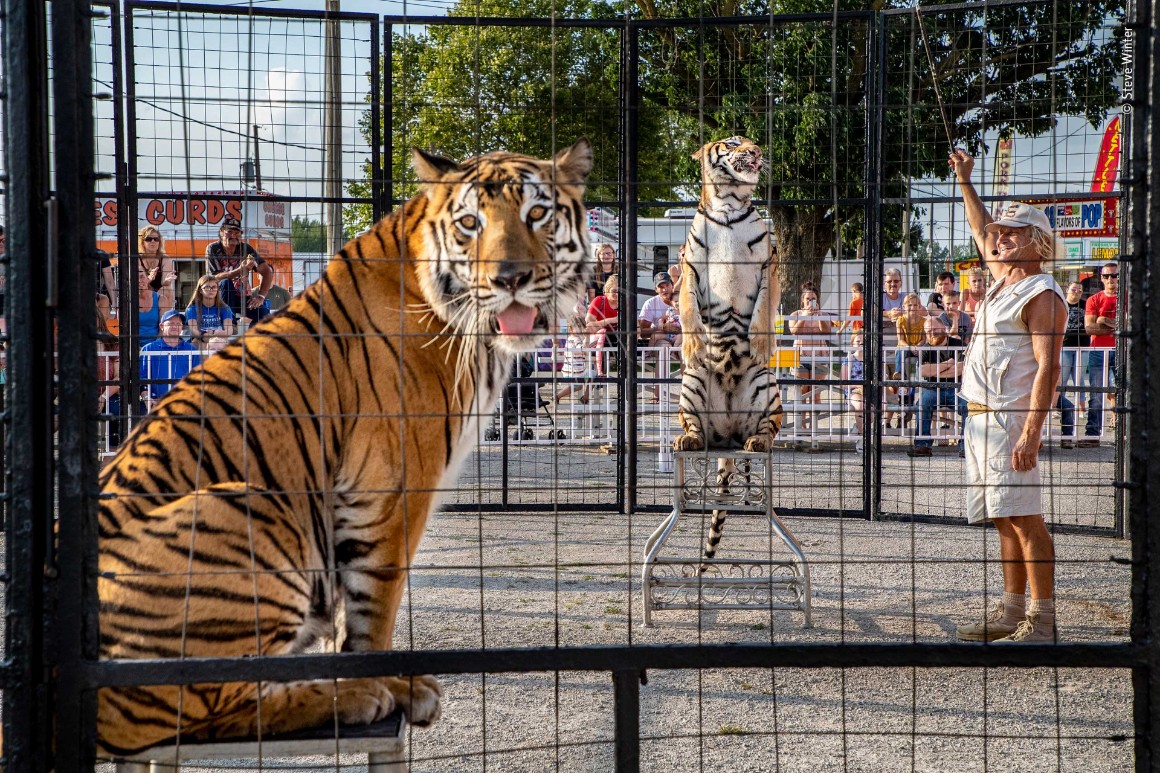
Doing It Old-style was Highly Commended in the 2020 Wildlife Photojournalist Story Award © Steve Winter
These captive tigers were made to walk high wires, leap in unison and jump through fire hoops at an old-fashioned circus at Ohio's Crawford County Fair.
During Beta testing articles may only be saved for seven days.
Create a list of articles to read later. You will be able to access your list from any article in Discover.
You don't have any saved articles.
Wildlife Photographer of the Year: Is the USA on the cusp of banning tiger tourism?
From inside the scandalous world of Netflix's Tiger King, to the front-line fight to save Thailand's tiger temple inhabitants, wildlife photographer Steve Winter has worked with big cats in captivity around the world.
Steve's portfolio, The Tiger Next Door, was highly commended in the fifty-sixth Wildlife Photographer of the Year competition. His images document the harrowing lives of tigers in captivity in the United States and illustrates the dire need for regulations to control this activity.
Having worked as a National Geographic contributing photographer for many years, Steve's first experience of documenting cats in captivity came when he and his partner Sharon Guynup exposed the animal rights abuses that occurred at the Tiger Temple in Thailand. Their words, seven minute video and photos provoked a groundswell of support amongst the Thai and international community and eventually led to the closure of the temple and the rescue of the tigers by the Thai government.
The success of their venture led Steve and Sharon to focus a little closer to home and to work on exposing the wild animal parks and big cat shows that operate in the United States.
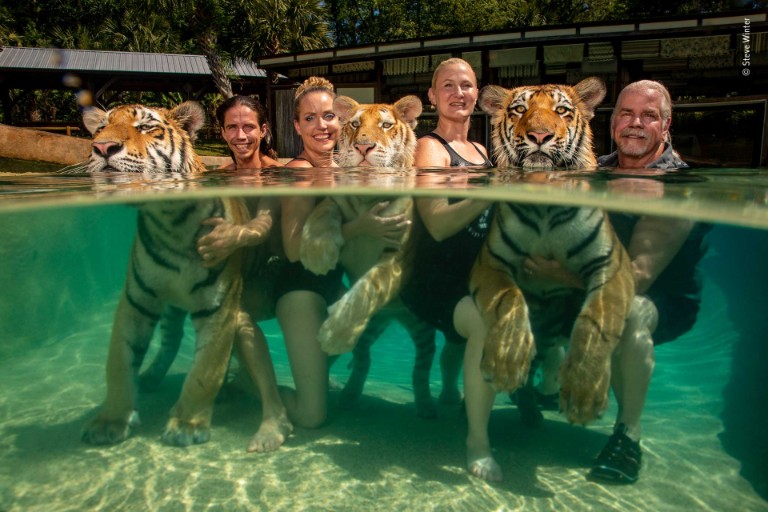
Doc Antel and his staff pose with three adult tigers in a pool. Doc has funded lobbying against legislation like the proposed Big Cat Public Safety Act.
Made famous by the Netflix series, Tiger King, tiger tourism is an incredibly lucrative industry in the United States which profits from the exploitation of captive big cats.
For a price, visitors to the numerous wild animal parks and touring fairs across the states can pet tiger cubs, have their photos taken with these animals, and watch them perform tricks and shows.
In order to support this profitable industry, tigers are kept in captivity for their entire lives, traded like commodities and forced to perform to crowds of tourists. Unnatural and enforced breeding sees cubs torn away from their mothers at birth and adult tigers murdered to make way for breeding age females.
The trade and exploitation of these animals is driven by demand - people are willing to pay for these experiences - and without regulation, owners are more than happy to profit from it.
Under the guise of conservation
The sad reality is that many people who visit these places don't understand the full extent of what goes into their big cat experience, in fact many people believe that these parks are working towards tiger conservation. For Steve, this is one of the key challenges to ending big cat tourism in the US.
'I think one of the biggest problems is that they try to get people to think that conservation is a part of this,' he says, 'Even when I went into the Thai Tiger Temple the first time there was this big sign as you walked in which read 'Conservation of tigers'.

Staff at South Carolina's Myrtle Beach Safari manoeuvre two tigers into position for a photoshoot. They have garnered a large social media following and are known for selectively breeds tigers for the colour of their fur – a practice known to cause congenital defects.
'A lot of the US parks have non-profit status because they're supposedly giving some of their funds to the conservation of wild tigers,' Steve says. However further investigation shows that the money that is donated annually is just a fraction of their daily income.
'Say they made $50,000 on one day - which we saw - if he gave $5,000 dollars in a whole year to tiger conservation, that's 10% of his take in one day and that's his conservation.'
In reality, these parks are paying a small price to maintain their non-profit status which keeps their visitors happy.
'The education is so important, because some people who visit think, "it's so expensive to get in here but at least we're saving tigers," No you're not! You're doing the exact opposite!' Steve says.
'They say they're involved in conservation so people think that these tigers will go back to the wild but no, no captive bred tiger has ever successfully been released into the wild, and surely not one that was born in Oklahoma.'
The sad reality of cub petting
One of the most distressing elements of tiger tourism in the US is the practice of cub petting. While it may sound innocent enough, simply paying to spend time with a baby tiger, the experience actually reinforces an intricate system of animal abuses.
Because cub petting is so profitable, many park owners breed their big cats at an accelerated rate. So where a wild adult tiger might have one litter in two years these captive cats are being forced to have two or three litters a year.

This family likely paid hundreds of dollars for the opportunity to feed a tiger cub. This cub's owner was previously banned from exhibiting animals after a person was killed by tigers in his care.
Steve says, 'It's set up like a business, these tigers, instead of being the most majestic creature on the planet, became objects, like cuddly little stuffed animals, because they're all bred for cub petting.'
Once the cubs are born, they are generally taken away from their mother immediately so there is no time for maternal bonding. Once the cubs are over 8 weeks of age, as determined by the US Department of Agriculture , they are allowed to be petted and handled by the public until they reach 16 weeks of age when they become too big.
'What happens to these cubs when they're too big to pet?' Steve asks.
'If you think about the timeline,' he goes on, 'If a cub can only be petted between eight weeks old and 16 weeks old and you're open 12 months a year, how many sets of cubs do you need to satisfy that amount of tourism?'

A six-month-old cross between a tiger and a lion, Gir was rescued by Tiger Haven, Tennessee, upon becoming too big for petting.
Sadly, for many of the profit hungry breeders and owners of wild animal parks, once a cub goes beyond 16 weeks of age, they are no longer worth keeping. This disposability fuels a black-market trade in live big cats for roadside zoos and pseudo-sanctuaries as well as for their body parts.
This shocking truth was brought home during the trial of Joe Exotic, self-proclaimed Tiger King, when it became clear that he had killed five adult tigers to make room for breeding females.
Steve was granted permission by the undercover US Fish and Wildlife agents to photograph the skulls which became a hugely important part of the trial that put Joe in prison for 22 years.

US Fish and Wildlife agents stand behind the skulls of five adult tigers killed by Joe Exotic.
'Tiger King was a huge plus for this issue.' Steve says. 'Not in the beginning, people were so excited about the tiger cubs that they were flooding to Joe Exotic's former zoo and Doc Antel's zoo, there were long lines. But things changed as more and more information came out.'
'When it's out in front of the public it can really make a difference and create change which is what we want - stories that actually have a positive impact.'
'We won't have any credibility on the international stage until the problem here is rectified. We need some kind of federal law that oversees all of the tigers in captivity in the US and would disallow public contact with cubs to stop the horrific practice of cub petting.'
A forever home
So, what is the solution? Alongside regulation of ownership and human interaction, Steve believes that a big part of the solution is the real sanctuaries which exist to care for big cats after they leave places like Joe Exotic's wild animal park.
One of Steve's images from Wildlife Photographer of the Year shows three tigers relaxing in a stock tank. 'They came from Joe Exotic', Steve says, 'When he went on the run he wanted to get rid of all of his big cats and so he called the Wild Animal Sanctuary north of Denver, Colorado where they have about 10,000 acres.'
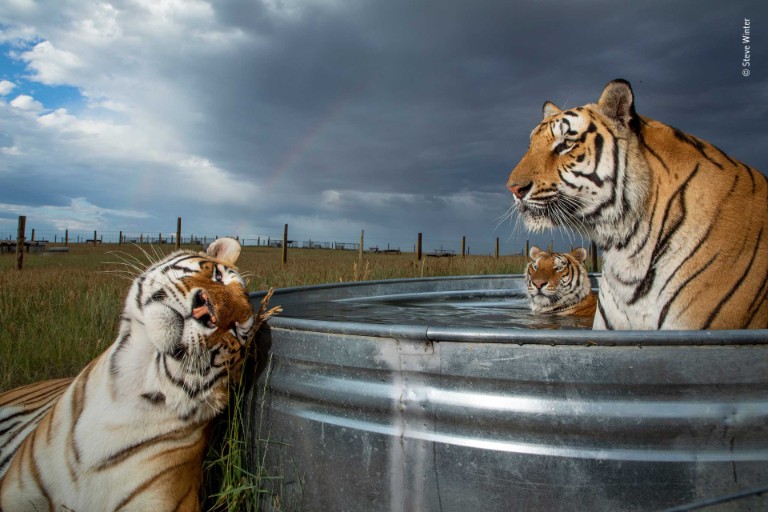
Clay, Daniel and Enzo cool off at the Wild Animal Sanctuary in Colorado – one of a number of rescue centres.
'They took 39 of Joe's tigers and lions to their forever home where they have no public contact at all.'
The sanctuaries, which don't allow any hands-on contact with the public, offer vet care, proper nutrition, and a place for tigers and lions, and increasingly bear cubs, to live out their days in peace.
'As Pat Craig who started the Wild Animal Sanctuary 40 or 50 years ago said,' Steve recalls, 'We want to get put out of business.'
Finally, it seems as though things are going that way, and Steve's photographs have been a big part of that.
'National Geographic sent every member of congress the December issue which had this story in it,' Steve tells me, 'We heard from numerous government agencies including the department of justice, and the others that the story made a big difference.'
'Now the Big Cat Public Safety Act which would restrict any hands-on cub petting, cub breeding, private ownership, many different things, has passed the house, and it's in the new senate, it's one of the only bi-partisan bills in the US congress because people love and care about big cats.'
'So, in the end this story did something to bring forward what people didn't know, that there's more tigers in the United States than in the wild - and we need to do something to fix this.'
'We need to give them back the wild and understand that they need more space. We need to protect nature and get back to the idea that the planet is a living being and it gives us all life.'
- Wildlife photography

Visit the new exhibition
Wildlife Photographer of the Year tells the incredible stories of life on our planet through powerful photography and expert insight.
Book your tickets
Discover more.

Wildlife Photographer of the Year: separating entertainment from exploitation
Photojournalist Kirsten Luce reveals the distressing lives of the animals held captive around the world for tourist entertainment.

Wildlife Photographer of the Year: a tiger's territory
Discover what makes a winner with this year's Wildlife Photographer of the Year.
The world's wildlife is under threat
Any donation to the Museum, no matter the size, could help our scientists in their work to strengthen habitats and protect species for decades to come.
Donate today and help create a future where both people and planet thrive.
Don't miss a thing
Receive email updates about our news, science, exhibitions, events, products, services and fundraising activities. We may occasionally include third-party content from our corporate partners and other museums. We will not share your personal details with these third parties. You must be over the age of 13. Privacy notice .
Follow us on social media
Thank you for visiting nature.com. You are using a browser version with limited support for CSS. To obtain the best experience, we recommend you use a more up to date browser (or turn off compatibility mode in Internet Explorer). In the meantime, to ensure continued support, we are displaying the site without styles and JavaScript.
- View all journals
- Explore content
- About the journal
- Sign up for alerts
- NEWS FEATURE
- 16 September 2022
Tigers are a natural attraction for tourists
- Arathi Menon
You can also search for this author in PubMed Google Scholar
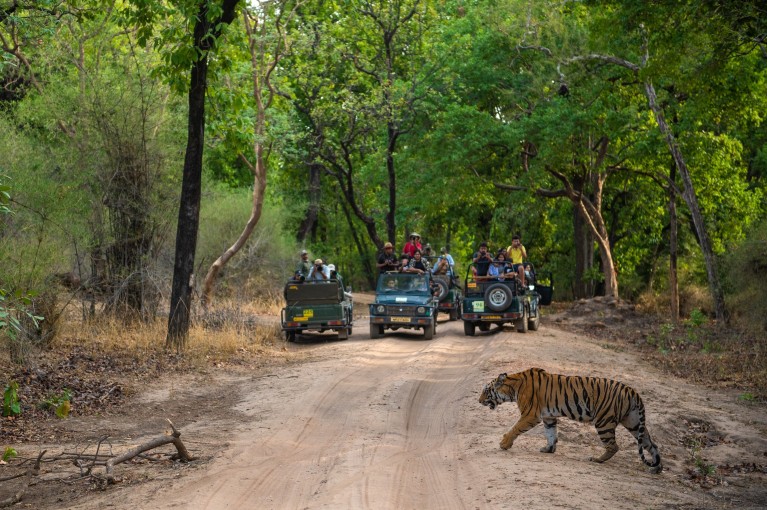
Credit: Aravind Ramamurthy
A new study by the Centre for Wildlife Studies supports the idea that for tourists in India’s nature reserves, tigers are the biggest drawcard.
“Since nature tourism is gaining popularity, we conducted a survey to understand tourists’ preferences – this could help managers of protected areas to strategize and generate revenue better,” according to the lead author of the study Dincy Mariyam.
To determine what attracted people, Mariyam and her team conducted the study at three tiger reserves—Bandipur, Kanha and Sundarbans. Though the researchers say that these protected areas were chosen for their high tourist numbers, one limitation of the study is that all three locations are designated tiger reserves, where tourists come with the primary intention of sighting a tiger.
The team found that the charismatic big cat was the most popular reason for them to visit, followed by beauty of reserve landscapes. Mariyam says that factors, including prior engagement in conservation issues, age, and gender could also have an effect on reasons for interest in low-profile categories such as herpetofauna and flora. For example, female tourists showed more interest in plants and trees, and younger tourists, especially those with experience in conservation activities, were more likely to value lesser-known fauna.
“The tiger is the most charismatic carnivore and has attributes like courage, stealth and confidence which a lot of people want to see in themselves. Spotting one in the wild is thrilling,” says Anish Andheria, president and CEO of the Wildlife Conservation Trust.
The authors considered the question of whether tourists who do not see a tiger would be deterred from future visits to a reserve. Andheria says nature observers are more informed and are interested in other species, not always tigers. “In Kanha, for example, tourists show a lot of interest in the endangered Barasingha (swamp deer),” he says.
India is a megadiverse country and has seen a 171% growth in PA visitation between 2005 and 2015, with 4.6 million visits, the study says. Previous studies have shown that nature-based tourism in India is largely domestic, with Indian tourists accounting for 96% of all visitors.
David Raju, a nature guide who has worked in many major PAs, like Kanha, Pench, Satpura and Tadoba national parks, says that he has observed varied interests in tourists. “These studies need to be done in PAs other than tiger reserves as well for accuracy,” he says. In his current role at Wayanad, Raju says two popular guides who focus on frogs and reptiles are booked for months in advance by tourists and photographers. “What we see in most tiger reserves is that the guides do not make an effort to take the experience beyond tiger sightings. It is an easy route with high satisfaction levels in places like Kanha and Pench where the tigers are habituated to vehicles and come closer.”
Tiger reserves have played a major role in protecting forest biodiversity. Andheria, a steering committee member of the National Tiger Conservation Authority (NTCA), says that after the launch of Project Tiger in 1973, the country rode on tigers’ popularity to create 53 tiger reserves with all types of landscapes and biodiversity. “If you want to protect frog species, no authority will show interest. But tiger holds sway, and when you create a tiger reserve, the frog is also protected.”
Andheria says the best habitat for elephants in the country is the tiger reserves. “Many rivers originate from or are fed by tiger reserves thus maintaining the hydrology of the region. So Project Tiger was an initiative that seemed to focus on tigers, but took conservation beyond them,” he says.
Mariyam says that the study also sought to discover whether there was an interest in lesser-known species like herpetofauna. “Most tourists are not willing to brave hostile conditions like leeches and ticks to get to their habitats. Tigers are easily spotted in spaces they are habituated to and everyone, from the young to the old, or unfit, can sit on a jeep and go to its habitat to spot one,” Anish says.
Raju says that a trained guide can generate and sustain visitor interest in a well-rounded PA experience. He says organizations such as Taj Safari, Pugdundee, and NGOs, including Nature Conservation Foundation (NCF) are now invested in training guides. “The NTCA is already working on creating quality interpretation centres in every tiger reserve in the country,” says Andheria.
doi: https://doi.org/10.1038/d44151-022-00096-4
Reprints and permissions
Southeast University Future Technology Institute Recruitment Notice
Professor openings in mechanical engineering, control science and engineering, and integrating emerging interdisciplinary majors
Nanjing, Jiangsu (CN)
Southeast University
Staff Scientist
A Staff Scientist position is available in the laboratory of Drs. Elliot and Glassberg to study translational aspects of lung injury, repair and fibro
Maywood, Illinois
Loyola University Chicago - Department of Medicine
W3-Professorship (with tenure) in Inorganic Chemistry
The Institute of Inorganic Chemistry in the Faculty of Mathematics and Natural Sciences at the University of Bonn invites applications for a W3-Pro...
53113, Zentrum (DE)
Rheinische Friedrich-Wilhelms-Universität
Principal Investigator Positions at the Chinese Institutes for Medical Research, Beijing
Studies of mechanisms of human diseases, drug discovery, biomedical engineering, public health and relevant interdisciplinary fields.
Beijing, China
The Chinese Institutes for Medical Research (CIMR), Beijing
Research Associate - Neural Development Disorders
Houston, Texas (US)
Baylor College of Medicine (BCM)
Sign up for the Nature Briefing newsletter — what matters in science, free to your inbox daily.
Quick links
- Explore articles by subject
- Guide to authors
- Editorial policies

Modal title
- Forgot your password?
Please enter your email address below. We will send you a link to reset your password, along with instructions.
As we continue to navigate life through the outbreak of the Coronavirus (COVID-19), we wish to keep Sanctuary's supporters and readers connected to recent news and articles. Sanctuary is therefore pleased to offer its April, May and June 2020 issues free of charge, online, for all those who register at this link.
Please check your email for your username and password, and login to our website to access our issues for free!

Photo: Tanay Panpalia
Tourism's Potential For Conservation
First published in sanctuary asia , vol. 37 no. 12, december 2017.
By Joanna Van Gruisen
A few years ago, I attended a book launch in the capital where three of Indias best-known tiger experts spoke about the tiger and how tourism could and did benefit its conservation. However, when discussion was opened to the floor for comments and questions, it was as though none of them had spoken. Journalists, tiger lovers and the authors friends, almost all seemed united in their antipathy towards wildlife tourism. It was an echo of the events of 2012 when the Supreme Court closed tiger reserves for tourism for a period and much was written in the press about the negative impacts of tourism.

The results of a new study cast a more positive light and show that facts actually paint a rather different picture. The research, led by eminent tiger scientist Dr. Raghu Chundawat, was presented in a preliminary report published by TOFTigers and Baavan, entitled The Value of Wildlife Tourism for Conservation and Communities. Four tiger reserves of central India - Bandhavgarh, Kanha, Panna and Pench - were examined and the results not only dispel many of the prevailing wildlife tourism myths, but are encouraging in providing a possible way forward to extend conservation beyond the PAs and to provide sustainable livelihoods for remotely- situated rural communities.
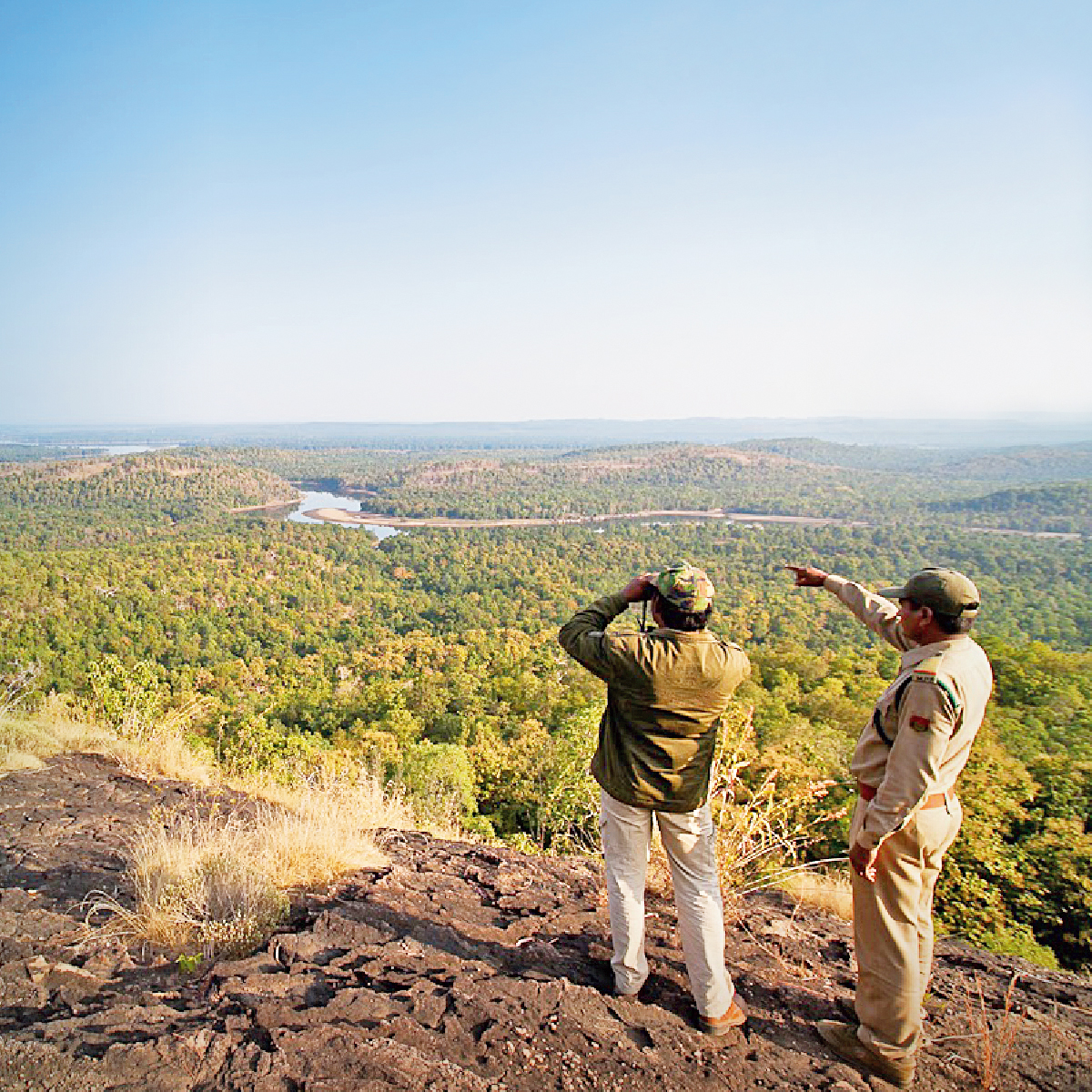
Community Benefits
The figures are surprising: the park entrance fees alone are higher than the state governments contribution toward the maintenance of the four reserves in the study. And, at least theoretically, this is money paid directly for community development and conservation. Since 1997, all tourism related fees in Madhya Pradesh are deposited in a Development Fund created for each Protected Area. Thus, the fees from tourism provide nearly Rs. 20 crores annually that could and should be spent on development for the local community and/or the PA. Recent figures may indicate a better picture but in 2013 very little of this was in fact fed back into the community. Apparently at best a mere 20 per cent of this went for community development or was provided to the eco-development committees (Kanha); elsewhere it varied from zero (Pench, Panna and Satpura) to 12 per cent (Bandhavgarh), according to ‘A Note on Tourism in Tiger Reserves of Madhya Pradesh in www.academia.edu by Dr. Suhas Kumar (PCCF M.P. retired) in 2013. Dr. Kumar does not record where the rest of the substantial amount goes. In this also lies a strong reason why many resorts are not keen on a conservation fee; they prefer to spend it on private eco-development work rather than pay into a government fund from which so little emerges for the community.
It was heartening to find that most resorts indeed run their own community development programmes and/or contribute to ongoing programmes; these cover “eco-development, environmental education... health, small to medium-sized enterprise development, alternative livelihood options, improvement of basic infrastructure such as electricity supply, drinking water, better road and connectivity and telecommunication and skills development. Most importantly, the sector supports and encourages nature conservation." This latter was most apparent in a comparison of attitudes of people in villages with tourism infrastructure and those without. Some of the non-tourist-affected villages were very hostile to the survey team when they arrived by jeep in their village since they assumed that they must be connected to the Forest Department. A comparison also showed that small business enterprises in villages where tourism was present generated nearly eight times more revenue than in those villages without (Rs. 79 lakh : Rs. 10 lakh).
More Indirect Benefits
What is often overlooked is the indirect financial benefit that the tourism industry generates in these remote areas. They spawn a myriad employment options from handicrafts and artists to plumbers, electricians and accountants. Based on the shared details of a few lodges, it seems that the injection towards this could run to as much as Rs.15 crores around the four parks surveyed.
Tourism is also a labour-intensive industry; it is one of the worlds top job creators. This is a crucial aspect as wildlife tourism is usually in fairly remote areas where employment opportunities are sparse. The Madhya Pradesh study found that as much as 80 per cent of the hotel staff are locals and if combined with the fees paid to local vehicle owners, guides and more, as much as Rs. 38 crores ($5.8 million) ends up being injected into the local economy. Taking into account the indirect employment generated, plus park fees, possibly 56 per cent of the hotels turnover actually feeds into the local area (over Rs. 92 crores - around US$ 14 million).
So the numbers indicate that tourism can and does bring substantial benefit to remote rural communities. And this is despite the fact that tourism has grown in such a haphazard unorganised manner, with little or no policy focus or control. In the survey areas, at least, this is happening without too much major long-term damage. Satellite images show negligible change in the forest cover from 2003-04 when the upsurge in hotels around the PAs began. When resort locations are plotted on the satellite images, it can be seen that almost all are clustered around already inhabited spots and hence create minimal extra disturbance to tiger movement.
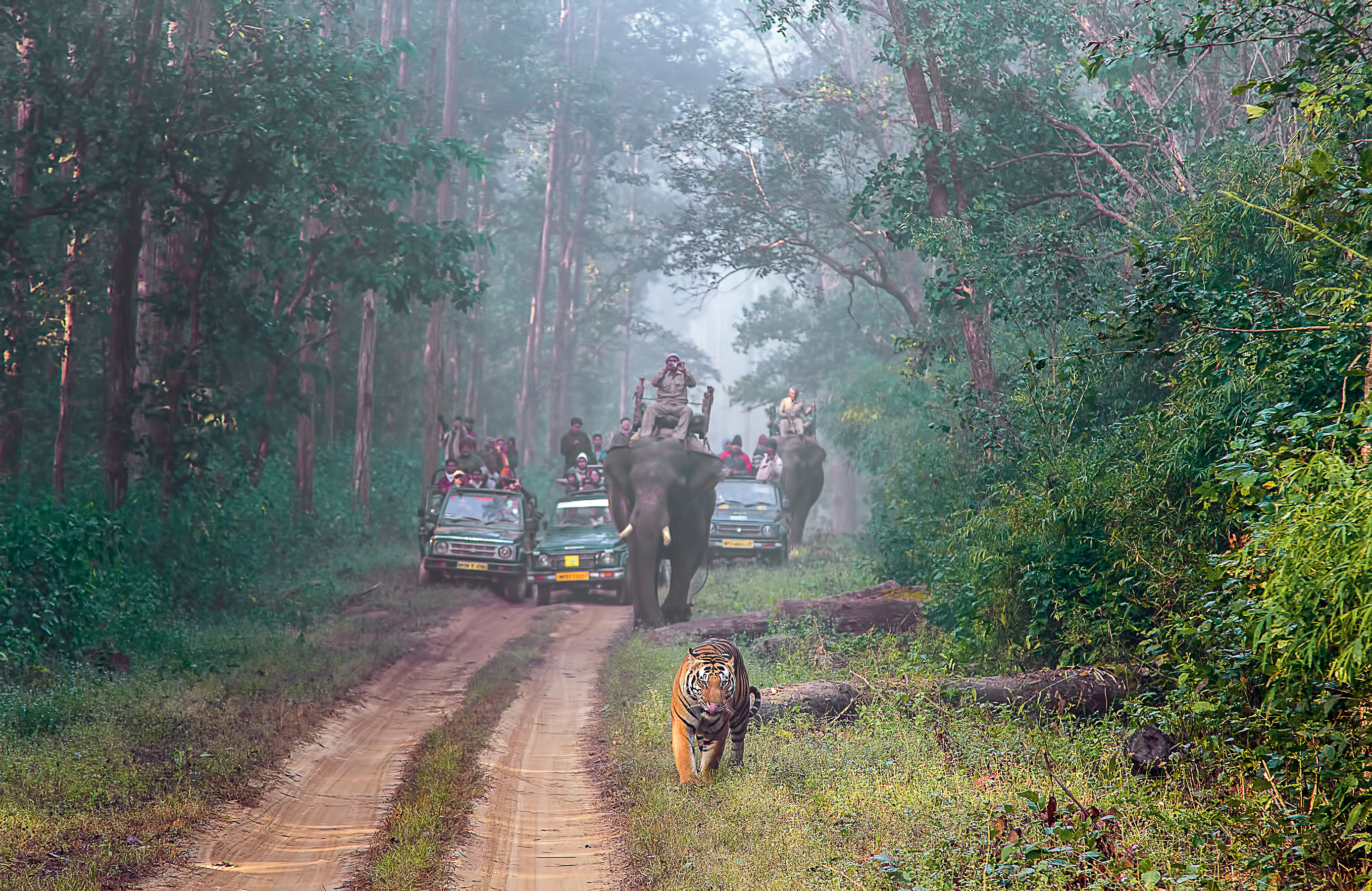
Tourism as a Tool
Many of the reserves, given their restricted entrance capacity, have reached tourist saturation point. Besides, the reserves that truly attract visitors are few in number. If tourism can be extended, this would spread the benefit - both for conservation and for the remote rural communities. The exciting aspect of this study is that it shows that it can be done and could be self-sustaining through tourism.
Raghu Chundawats tiger ecology study in Panna identified a scale mis-match for tigers and this is not unique in our PA system. Many tiger reserves are too small to protect a viable population of the big cat over the long term - the extinctions in Sariska and Panna are examples of this. More and larger exclusionary conservation areas are no longer feasible but we can build on what we have, and can extend our areas of conservation, with different paradigms. The success of the PA system can be complemented with parallel models.
Figures from the latest study show that eco-tourism could provide one way to do this. It could be the means for forests beyond the PA boundaries to be brought into the conservation fold, boosting the viability of small tiger reserves by providing additional protected tiger breeding areas, while also providing stepping stones of safety in corridors from one PA to another. By spreading the area of wildlife tourism, not only would more communities benefit, but also the pressure on existing reserves could be reduced. Furthermore, these non-PA areas would offer visitors more diverse wildlife experiences and cater to the different interests and individual preferences of travellers in ways that the present jeep-safari-only model cannot.
When well-managed, tourism, unlike most industries, can create a thriving economy that is not dependent on the one-time consumption of natural resources: one where the local community can become active partners both in tourism and in nature conservation. The next step is to persuade the government of this possibility! For the model to be effective, a sympathetic government policy is required that promotes and encourages sustainable wildlife tourism over a larger landscape.
After three decades of involvement in wildlife conservation, we entered the tourism field as a self-sustaining way to continue such work in the Panna area. This is a rural area where much of the populations livelihood comes from agriculture and/or unskilled labour. In a small way I have seen the changes a few well-managed lodges can bring such areas when run on eco-tourism principles. If this were possible to do in strategic ‘stepping stone locations covering larger, tiger-territory-sized areas, it could also directly contribute to broadening the tiger conservation landscape.
Enhanced sustainable rural livelihoods and wildlife conservation too - what could be better than that?
Originally from the U.K., Joanna Van Gruisen has lived in the Indian subcontinent for over three decades. She is a writer, photographer and conservationist.
- "Is Realism Helpful?"
- A Glimpse Into The Amphibian World
- A Thousand Voices From the Field

Tiger Tourism: Balancing Ecotourism and Wildlife Protection
1. the rise of tiger tourism, 2. the importance of tiger conservation, 3. ecotourism and its impact on tiger populations, 4. challenges and solutions, 5. best practices for tour operators and travelers, 6. community involvement in tiger conservation, 7. the role of governments in tiger conservation and ecotourism, 8. successful tiger conservation and tourism projects, 9. a sustainable future for tiger tourism.
In recent years, the popularity of tiger tourism has increased significantly, leading to a rise in the number of visitors to national parks and wildlife reserves where tigers can be spotted. While this has helped raise awareness about the importance of tiger conservation, it has also raised concerns about the impact of tourism on the environment and the wildlife. Some argue that tiger tourism is essential to the survival of the species, as it generates revenue that can be used to fund conservation efforts. Others, however, argue that it can have a negative impact on the tigers, their habitat, and the local communities.
To better understand this complex issue, here are some in-depth insights:
1. The positive impact of tiger tourism:
Many conservationists argue that tiger tourism can have a positive impact on the species and their habitat. By generating revenue, tiger tourism can fund conservation efforts, such as anti-poaching measures, habitat restoration, and community-based conservation programs. This, in turn, can help protect the tigers and their ecosystem, as well as support the livelihoods of local communities.
For example, in India's Bandhavgarh National Park, tiger tourism has helped increase the tiger population from 46 in 2006 to 105 in 2019. The revenue generated from tourism has been used to fund anti-poaching patrols, habitat restoration, and community-based conservation programs, which have helped reduce the threats to the tigers and their habitat.
2. The negative impact of tiger tourism:
On the other hand, some argue that tiger tourism can have a negative impact on the environment and the wildlife. The increasing number of visitors can lead to habitat degradation, disturbance to the animals, and increased pollution. Furthermore, some tourists may not follow the rules and regulations , which can lead to further damage to the ecosystem.
For instance, in Thailand's Tiger Temple, tigers were allegedly subjected to cruel treatment and were kept in poor conditions. The temple was eventually closed down, and the tigers were rescued and relocated to a wildlife sanctuary.
3. Balancing ecotourism and wildlife protection:
To address these concerns, it is essential to find a balance between ecotourism and wildlife protection. This can be achieved by implementing strict regulations and guidelines for tourism activities, such as limiting the number of visitors, enforcing strict codes of conduct, and promoting responsible tourism practices. Additionally, involving local communities in conservation efforts and providing them with alternative livelihoods can help reduce the pressure on the ecosystem and support the conservation of tigers and their habitat.
Tiger tourism is a complex issue that requires careful consideration of its impact on the environment, the wildlife, and the local communities. While it can have positive benefits for conservation efforts, it is important to ensure that it is done in a responsible and sustainable manner.
The Rise of Tiger Tourism - Tiger Tourism: Balancing Ecotourism and Wildlife Protection
The tiger, an apex predator, is a vital component of the ecological balance of the habitat it inhabits. Tigers play a crucial role in maintaining the food chain, and their conservation is essential to protect the biodiversity of the ecosystem. However, the global population of tigers has decreased drastically over the years due to habitat loss, poaching, and human-wildlife conflict . Therefore, the importance of tiger conservation cannot be overstated.
Here are some key points that highlight why tiger conservation is crucial:
1. Ecological balance: Tigers are at the top of the food chain, and their presence in the ecosystem ensures that the population of herbivores like deer and wild boars is kept in check, thereby maintaining the ecological balance of the habitat.
2. Biodiversity: Tigers are an umbrella species, which means their protection helps preserve the entire ecosystem of the habitat. Conserving tigers ensures the survival of other species that share the same habitat.
3. Cultural significance: Tigers are not only ecologically important but also culturally significant. In many countries, tigers are revered as deities and are an integral part of the local culture and tradition.
4. Economic benefits: Tiger conservation can provide significant economic benefits to local communities . Ecotourism, when done responsibly, can generate income and employment opportunities for local communities while conserving tigers and their habitat.
5. Global impact: The conservation of tigers has a global impact as it helps mitigate climate change. Tiger habitats, such as forests and grasslands, store carbon and play a vital role in regulating the earth's climate.
The importance of tiger conservation cannot be overstated. Protecting tigers and their habitat not only benefits the ecosystem and biodiversity but also has significant economic and cultural significance. It is crucial to balance ecotourism and wildlife protection to conserve tigers while ensuring the well-being of local communities and their livelihoods.
The Importance of Tiger Conservation - Tiger Tourism: Balancing Ecotourism and Wildlife Protection
The practice of ecotourism has become increasingly popular in recent years, with tourists flocking to natural habitats to experience the beauty of nature and wildlife. However, with an increase in ecotourism comes an increase in foot traffic , which can have a significant impact on the environment and the animals that inhabit it. The issue becomes even more complicated when it comes to ecotourism and tiger populations. While ecotourism can provide much-needed revenue for conservation efforts and support local communities , it can also disrupt the delicate balance of tiger habitats and lead to negative consequences for these majestic animals.
Here are some insights on the impact of ecotourism on tiger populations:
1. Ecotourism can lead to habitat destruction: The construction of hotels, roads, and other infrastructure to support ecotourism can lead to the destruction of natural habitats, which can have a negative impact on tiger populations. Tigers require large areas of undisturbed forest to thrive, and the destruction of their habitat can lead to a decline in their numbers.
2. Ecotourism can disrupt tiger behavior: The presence of tourists can disrupt the natural behavior of tigers, which can impact their mating and hunting patterns. For example, tigers may become habituated to humans and lose their fear of them, which can lead to dangerous encounters in the future.
3. Ecotourism can lead to poaching: While ecotourism can provide much-needed revenue for conservation efforts, it can also attract poachers who are looking to profit from the sale of tiger parts on the black market. This can have a devastating impact on tiger populations, which are already under threat from habitat loss and other factors.
4. Ecotourism can support conservation efforts: Despite the potential negative impacts of ecotourism, it can also be a powerful tool for conservation. Revenue generated from ecotourism can be used to support conservation efforts and provide economic opportunities for local communities. For example, in India, ecotourism has helped to increase tiger populations by providing financial incentives for conservation efforts.
5. Ecotourism needs to be properly managed: To minimize the negative impacts of ecotourism on tiger populations, it is essential that it is properly managed. This can include limiting the number of tourists allowed in a particular area, ensuring that infrastructure is built in a sustainable manner, and enforcing strict regulations to prevent poaching and other illegal activities.
While ecotourism can have both positive and negative impacts on tiger populations, it is clear that it can be an effective tool for conservation when properly managed. By balancing the needs of tourists, local communities, and wildlife, we can ensure that ecotourism has a positive impact on tiger populations and the environment as a whole.
Ecotourism and Its Impact on Tiger Populations - Tiger Tourism: Balancing Ecotourism and Wildlife Protection
Ecotourism has become a popular way to explore new places while also being mindful of the environment and wildlife. While it can bring in money and raise awareness for conservation efforts, it can also have negative impacts on the very wildlife it aims to protect. As with any topic, there are differing opinions and perspectives on how to balance ecotourism and wildlife protection. Some argue that ecotourism can help fund conservation efforts, while others argue that it can lead to exploitation of wildlife and their habitats. However, with proper planning and management, it is possible to create a system where ecotourism and wildlife protection can coexist.
Here are some challenges and solutions to consider when balancing ecotourism and wildlife protection:
1. Overcrowding: One of the most significant challenges of ecotourism is overcrowding, which can disturb and even harm the wildlife. To address this issue, park managers can implement measures such as limiting the number of visitors per day, setting up designated viewing areas, and creating off-limits areas for animals.
2. Encouraging Responsible Tourism: Encouraging responsible tourism is essential to minimize the negative impacts of ecotourism. This can be done by educating visitors on how to behave around wildlife, promoting ethical practices such as not littering and not feeding the animals, and offering alternative activities to reduce pressure on the wildlife, such as hiking and bird watching.
3. Community Involvement: Involving local communities in ecotourism can ensure that the benefits are shared while also supporting conservation efforts. For example, ecotourism can provide job opportunities for locals, and the revenue generated can be used to fund conservation efforts or support community development projects.
4. Balancing Conservation and Economic Interests: One of the biggest challenges in balancing ecotourism and wildlife protection is finding a balance between conservation and economic interests. While it is important to generate revenue from ecotourism to support conservation efforts, it is equally important to ensure that the wildlife is not exploited for economic gain. One solution is to establish clear guidelines and regulations on ecotourism activities, such as limiting the number of safaris per day and mandating the use of licensed guides.
5. Monitoring and Evaluation: The success of ecotourism in balancing conservation and economic interests depends on effective monitoring and evaluation. This can be done by setting up monitoring systems to track visitor numbers, wildlife behavior, and ecological impacts. This information can then be used to make informed decisions on how to manage ecotourism activities and ensure the protection of the wildlife.
Ecotourism has the potential to benefit both wildlife and local communities, but it must be managed carefully to ensure that it does not harm the very things it aims to protect. By addressing the challenges and implementing solutions such as responsible tourism, community involvement, and effective monitoring and evaluation, it is possible to create a system where ecotourism and wildlife protection can coexist.
Challenges and Solutions - Tiger Tourism: Balancing Ecotourism and Wildlife Protection
One of the most important aspects of responsible tiger tourism is ensuring that tour operators and travelers are following best practices that prioritize the well-being and protection of tigers and their natural habitat . This can be achieved through a combination of education, regulation, and responsible behavior on the part of all stakeholders involved. From the perspective of tour operators, it is crucial to work with local communities and conservation organizations to develop sustainable tourism practices that not only support the local economy but also help to protect the environment and wildlife. This can include things like limiting the number of visitors to sensitive areas, providing educational materials to visitors, and investing in conservation efforts.
On the other hand, travelers also have a responsibility to ensure that their actions are not harming the very wildlife they have come to see. This means avoiding behaviors that can be harmful, such as getting too close to tigers or disturbing their natural habitat. Additionally, travelers should make an effort to choose tour operators that prioritize responsible and sustainable tourism practices. By doing so, they can help to support conservation efforts and ensure that future generations will be able to enjoy the beauty of tigers and their natural habitat.
To further emphasize the importance of responsible tiger tourism, here are some best practices that can be adopted by both tour operators and travelers:
1. Limit the number of visitors: Overcrowding can be harmful to tigers and their habitat, so it is important to limit the number of visitors to sensitive areas. This can help to reduce the impact of tourism on the environment while also ensuring that visitors have a more enjoyable experience.
2. Provide educational materials: Providing educational materials to visitors can help to increase awareness about the importance of conservation and responsible tourism practices. This can include things like brochures, signage, and guided tours that focus on the natural history and conservation of tigers.
3. Invest in conservation efforts: Tour operators can make a significant impact by investing in conservation efforts that help to protect tigers and their habitat. This can include things like supporting local conservation organizations, contributing to research efforts, and implementing sustainable tourism practices.
4. Choose responsible tour operators: Travelers can make a difference by choosing tour operators that prioritize responsible and sustainable tourism practices. This can include researching tour operators before booking a trip, asking questions about their practices, and supporting operators that have a proven track record of supporting conservation efforts.
By adopting these best practices, tour operators and travelers can work together to ensure that tiger tourism is both sustainable and responsible. This can help to protect tigers and their natural habitat while also providing visitors with a once-in-a-lifetime experience.
Best Practices for Tour Operators and Travelers - Tiger Tourism: Balancing Ecotourism and Wildlife Protection
As humans, it is our responsibility to protect and conserve the wildlife around us. Tigers, for example, are one of the most majestic and beautiful creatures that roam our planet. However, their existence is threatened due to habitat loss, poaching, and other human activities. To ensure the survival of tigers, it is essential that we involve the local communities in the conservation efforts.
1. Education and Awareness: Educating the local communities about the importance of tiger conservation can go a long way in protecting these big cats. By raising awareness, we can encourage the locals to report any poaching or wildlife crimes they witness. Moreover, education can also help to reduce human-tiger conflicts. For instance, the Sundarbans, home to the largest population of tigers, has seen a significant decrease in tiger attacks on humans due to awareness campaigns.
2. Alternative Livelihoods: Many communities depend on forest resources for their livelihoods, which can often lead to conflict with the tigers. Providing alternative livelihoods such as ecotourism, handicrafts, and sustainable agriculture can help to reduce this conflict. For example, the village of Tadoba in India has seen a significant reduction in tiger poaching after the introduction of ecotourism.
3. Community-Based Conservation Programs: Involving the local communities in conservation programs can help to create a sense of ownership and responsibility towards protecting the wildlife. For instance, the Satpura Tiger Reserve in India has implemented a community-based conservation program where the locals are trained as guides, drivers, and trackers for the tourists. This has not only provided employment opportunities but also helped to reduce poaching and other wildlife crimes.
4. Government Support: The government plays a crucial role in tiger conservation, and it is essential that they involve the local communities in the decision-making process . Providing the communities with a voice in conservation planning can help to address their concerns and ensure that the conservation efforts are sustainable in the long run .
Involving the local communities in tiger conservation is crucial for the survival of these magnificent creatures. By providing education, alternative livelihoods, community-based conservation programs, and government support, we can ensure that tigers continue to thrive in their natural habitat.
Community Involvement in Tiger Conservation - Tiger Tourism: Balancing Ecotourism and Wildlife Protection
The role of governments in tiger conservation and ecotourism is crucial to ensure the protection of tigers in the wild while also promoting sustainable tourism. Governments play a pivotal role in creating and implementing policies that regulate the tourism industry and protect wildlife habitats. However, this role is often complicated by the competing interests of conservation and economic development. Some argue that ecotourism can provide a significant source of income for local communities and incentivize them to preserve wildlife habitats, while others argue that it can also lead to the exploitation of natural resources and wildlife.
To address these issues, governments have implemented various strategies to balance ecotourism and wildlife protection. Here are some examples:
1. Establishing protected areas: Governments can create protected areas such as national parks and wildlife reserves to conserve tiger habitats and restrict human activities in these areas. For example, India's Project Tiger has created 50 tiger reserves across the country, covering an area of 72,749 square kilometers.
2. Developing ecotourism guidelines: Governments can develop ecotourism guidelines that promote sustainable tourism practices and minimize the negative impact of tourism on wildlife habitats. For example, in Nepal, the Sustainable Tourism Network has developed guidelines for trekking and ecotourism that emphasize responsible tourism practices.
3. Providing incentives for local communities: Governments can provide financial incentives for local communities to engage in conservation efforts and promote ecotourism. For example, in Malaysia, the government has established a community-based ecotourism program in the Belum-Temengor Forest Complex that provides income opportunities for local communities and supports conservation efforts.
4. Strengthening law enforcement: Governments can strengthen law enforcement efforts to combat poaching and illegal wildlife trade . For example, in Thailand, the government has established the National Ivory and Tiger Task Force to combat wildlife trafficking and has increased penalties for poaching and illegal wildlife trade.
In summary, the role of governments in tiger conservation and ecotourism is crucial to ensure the protection of tigers in the wild while also promoting sustainable tourism. Governments can play an active role by establishing protected areas, developing ecotourism guidelines, providing incentives for local communities, and strengthening law enforcement efforts. By balancing ecotourism and wildlife protection, governments can create a sustainable future for both tigers and local communities.
The Role of Governments in Tiger Conservation and Ecotourism - Tiger Tourism: Balancing Ecotourism and Wildlife Protection
Tiger conservation and tourism projects can be a tricky balancing act. On one hand, tourism can provide much-needed funding for conservation efforts, and it can also raise awareness about the importance of protecting these majestic animals. On the other hand, too much tourism can be damaging to the environment and disrupt the natural behavior of the tigers. However, there are successful tiger conservation and tourism projects that have found a way to strike a balance between these two goals.
Here are some examples of successful tiger conservation and tourism projects:
1. Kanha National Park in India: This park has successfully implemented a program called "Village Eco Development" that involves local communities in conservation efforts. This has helped to reduce human-tiger conflicts and has also created economic opportunities for the local people. The park has also implemented strict regulations on the number of tourists allowed in the park at any given time.
2. Pench Tiger Reserve in India: This reserve has implemented a program called "Collarwali" that involves tracking and monitoring the behavior of tigers in the reserve. This has helped to reduce human-tiger conflicts by providing early warning systems to nearby villages. The reserve has also implemented a program called "Tribal Entrepreneurship Development" that provides economic opportunities to local communities through ecotourism.
3. Chitwan National Park in Nepal: This park has successfully implemented a program called "Community Based Anti-Poaching Units" that involves local communities in anti-poaching efforts. This has helped to reduce poaching in the park and has also created economic opportunities for the local people through ecotourism.
Overall, successful tiger conservation and tourism projects involve a combination of factors, including community involvement, strict regulations on tourism, and innovative conservation strategies. By finding a way to balance the needs of the tigers with the needs of the local communities and tourists, these projects are helping to ensure the survival of these magnificent animals for generations to come.
Successful Tiger Conservation and Tourism Projects - Tiger Tourism: Balancing Ecotourism and Wildlife Protection
As the discussion on tiger tourism continues, it is important to consider the sustainability of this industry. While it can provide economic benefits and raise awareness for conservation efforts, it can also have negative impacts on the ecosystem and the animals themselves. It is necessary to balance the need for tourism with the protection of wildlife.
Here are some key considerations for achieving a sustainable future for tiger tourism:
1. Implementing responsible tourism practices: Tour operators should follow ethical guidelines that prioritize the welfare of the animals and minimize disturbances to their natural habitats. This includes limiting the number of visitors, avoiding off-road driving, and educating tourists on how to behave around wildlife.
2. supporting local communities : Tiger tourism can provide economic opportunities for local communities, but it is important to ensure that they are not negatively impacted by tourism. supporting local businesses and providing training and employment opportunities can help to ensure that the benefits of tourism are shared fairly.
3. Investing in conservation efforts: The revenue generated by tiger tourism can be used to fund conservation efforts, such as anti-poaching initiatives and habitat restoration projects. This can help to ensure the long-term survival of tigers and their ecosystems.
4. Prioritizing research and monitoring: It is important to continue researching the impacts of tiger tourism on wildlife and ecosystems, and to monitor the effectiveness of conservation efforts. This can help to identify areas for improvement and ensure that tourism is having a positive impact.
Tiger tourism can be a valuable tool for conservation and economic development, but it must be managed responsibly and sustainably. By prioritizing the welfare of wildlife, supporting local communities, investing in conservation efforts, and continuing to research and monitor the impacts of tourism, we can ensure a brighter future for tigers and their ecosystems.
A Sustainable Future for Tiger Tourism - Tiger Tourism: Balancing Ecotourism and Wildlife Protection
Read Other Blogs
1. Understanding Libor Rates and Their Significance in Forward Swap Pricing Libor rates play a...
Understanding the Role of Authorized Participants in ETFs In the world of exchange-traded funds...
1. Defining Data Integrity: At its core, data integrity refers to the...
In the realm of social entrepreneurship, mental health social enterprises (MHSEs) emerge as a...
The surge in educational technology investments has become a pivotal aspect of the modern...
In recent years, a transformative shift has been observed in the way students are transported to...
Cause marketing is a type of marketing strategy that involves a collaboration between a for-profit...
Systematic risk, also known as market risk, is the risk that affects the entire market or a large...
In an era where digital platforms dominate the marketing landscape, the potency of face-to-face...
Advertisement
Tigers, tourists and wildlife: visitor demographics and experience in three Indian Tiger Reserves
- Original Paper
- Published: 21 April 2017
- Volume 26 , pages 2187–2204, ( 2017 )
Cite this article

- Salvador Lyngdoh 1 ,
- Vinod B. Mathur 2 &
- Bitapi C. Sinha 3
1282 Accesses
15 Citations
1 Altmetric
Explore all metrics
Ecotourism or sustainable tourism is an effective conservation tool. Recently increasing trends in visitations to protected areas (PAs) in India particularly, tiger reserves (TRs) have been documented. A questionnaire survey was carried out to objectively investigate visitor experience in three high profile tiger reserves (n = 684). Information on the role of nature interpreters, media and infrastructure was collected to assess how they influence tourist activity, aspiration and satisfaction in a PA. Domestic tourist formed majority of the visitor numbers in all three PAs (82.7%). Tourists who visit these PAs chose to have close encounters with large mammals especially tigers. Primary attraction for visitors were wild mammals > tigers > peacefulness > photography > bird watching. Visitors mainly travelled in groups with a family (43–58%). Majority of visitors to PAs were from minor cities situated 200–600 km from a PA. Visitors informed that their primary source of information regarding a PA was word of mouth (hearsay, 35.78%) and newspaper (24%). These sources of information varied significantly across eight other categories and parks. Designing each visit as an interpretive experience and meaningful conservation activity for largely for the domestic visitors as well as gradually increasing international visitors can be encouraged in such PAs.
This is a preview of subscription content, log in via an institution to check access.
Access this article
Price includes VAT (Russian Federation)
Instant access to the full article PDF.
Rent this article via DeepDyve
Institutional subscriptions
Similar content being viewed by others

Wildlife Tourism, a Multidisciplinary Field of Inquiries and Insights: Final Considerations

Zoo and Aquarium Visitors’ Wildlife Values and Ethics Orientations

Visual Dimensions of Conservation Landscapes: An Exploration of Patagonian Fjordic Landscapes from the Perspective of Prospective Chilean Tourists
Ashley C, Boyd C, Goodwin H (2000) Pro-poor tourism: putting poverty at the heart of the tourism agenda. Nat Resour Perpectives 51:1–6
Google Scholar
Badola R, Hussain SA, Mishra BK, Konthoujam B, Thapliyal S, Dhakate PM (2010) An assessment of ecosystem services of Corbett Tiger Reserve, India. Environmentalist 30:320–329
Article Google Scholar
Ballantyne R, Packer J, Hughes K, Dierking L (2007) Conservation learning in wildlife tourism settings: lessons from research in zoos and aquariums. Environ Educ Res 13:367–383
Ballantyne R, Packer J, Hughes K (2009) Tourists’ support for conservation messages and sustainable management practices in wildlife tourism experiences. Tour Manag 30:658–664
Banerjee A (2012) Is wildlife tourism benefiting Indian protected areas? A survey. Curr Issues Tour 15:211–227
Beschta RL, Ripple WJ (2009) Large predators and trophic cascades in terrestrial ecosystems of the western United States. Biol Conserv 142:2401–2414
Cellabos-Lascurin H (1996) Ecotourism, tourism and protected area. IUCN, Gland
Book Google Scholar
Cole V, Sinclair AJ (2002) Measuring the ecological footprint of a Himalayan tourist center. Mountain Res Dev 22:132–141
Dunn OJ (1964) Multiple comparisons using rank sums. Technometrics 6:241–252
Eagles PFJ (1992) The travel motivations of Canadian ecotourists. J Travel Res 31:3–7
Fahmy T, Aubry P (2015) XLStat 15.0. Society Addinsoft
Geva A, Goldman A (1991) Satisfaction measurement in guided tours. Ann Tour Res 18:177–185
Goodwin H (1996) In pursuit of ecotourism. Biodivers Conserv 5:277–291
Hannam K (2004) Tourism and forest management in India: the role of the state in limiting tourism development. Tour Geogr 6:331–351
Hannam K (2005) Tourism management issues in India’s national parks: an analysis of the Rajiv Gandhi (Nagarahole) national park. Curr Issues Tour 8:165–180
Jhala YV, Qureshi Q, Gopal R, Sinha PR (eds) (2011) Status of tigers, co-predators and prey in India, 2010. Government of India National Tiger Conservation Authority, 217
Jhala YV, Qureshi Q, Gopal R (2014) The status of tigers in India. National Tiger Conservation Authority, New Delhi & The Wildlife Institute of India, Dehradun
Karanth KK, DeFries R (2011) Nature-based tourism in Indian protected areas: new challenges for park management. Conserv Lett 4:137–149
Karanth KK, Defries R, Srivathsa A, Sankaraman V (2012) Wildlife tourists in India’s emerging economy: potential for a conservation constituency? ORYX 46:382–390
Kass GV (1980) An exploratory technique for investigating large quantities of categorical data. Appl Stat 29:119–127
Korkmaz S, Goksuluk D, Zararsiz G (2016) MVN: an R package for assessing multivariate normality
Lewis DM, Alpert P (1997) Trophy hunting and wildlife conservation in Zambia. Conserv Biol 11:59–68
Lockwood M, Worboys G, Kothari A (2012) Managing protected areas: a global guide. Routledge, Abingdon
Lyngdoh S, Gopi GV, Selvan KM, Habib B (2014a) Effect of interactions among ethnic communities, livestock and wild dogs ( Cuon alpinus ) in Arunachal Pradesh, India. Eur J Wildl Res 60:771–780
Lyngdoh S, Shrotriya S, Goyal SP, Clements H, Hayward MW, Habib B (2014b) Prey preferences of the Snow Leopard ( Panthera uncia ): regional diet specificity holds global significance for conservation. PLoS ONE 9:1–11
Maechler M (2015) Package ‘diptest’
Mathur V, Gopal R (2015) Tiger meter: management effectiveness of tiger reserves in India, p 20
Mingyu Y, Hens L, Xiaokun O, Wulf R De (2009) Impacts of recreational trampling on sub-alpine vegetation and soils in Northwest Yunnan, China. Acta Ecol Sin 29:171–175
Narain S, Panwar HS, Gadgil M, Thapar V, Singh S (2005) Joining the dots. In: Joining the dots: report of the Tiger Task Force, pp 217
Newsome D, Dowling RK, Moore SA (2005) Wildlife tourismIV. Channel View Publications, Bristol
Nyaupane GP, Poudel S (2011) Linkages among biodiversity, livelihood, and tourism. Ann Tour Res 38:1344–1366
Okello MM, Manka SG, D’Amour DE (2008) The relative importance of large mammal species for tourism in Amboseli National Park, Kenya. Tour Manag 29:751–760
Pennisi LA, Holland SM, Stein TV (2004) Achieving bat conservation through tourism. J Ecotour 3:195–207
Sekhar NU (2003) Local people’s attitudes towards conservation and wildlife tourism around Sariska Tiger Reserve, India. J Environ Manag 69:339–347
Sinha BC, Qureshi Q, Uniyal VK, Sen S (2012) Economics of wildlife tourism—contribution to livelihoods of communities around Kanha tiger reserve, India. J Ecotour 11:207–218
Tisdell C, Wilson C (2005) Perceived impacts of ecotourism on environmental learning and conservation: turtle watching as a case study. Environ Dev Sustain 7:291–302
Verma M, Negandhi D, Khanna C, Edgaonkar A, David A, Kadekodi G, Singh R, Costanza R (2015) Economic valuation of tiger reserves in India: a value+ approach. Indian Institute of Forest Management, Bhopal, p 284
Walpole MJ, Leader-Williams N (2002) Tourism and flagship species in conservation. Biodivers Conserv 11:543–547
Weaver D (2002) Asian ecotourism: patterns and themes. Tour Geogr 4:153–172
Winterbach HEK, Winterbach CW, Somers MJ, Hayward MW (2013) Key factors and related principles in the conservation of large African carnivores. Mamm Rev 43:89–110
Yuksel A (2001) Managing customer satisfaction and retention: a case of tourist destinations, Turkey. J Vacat Mark 7:153–168
Download references
Acknowledgements
We thank the P.R Sinha and P.K Mathur of Wildlife Institute of India for their support. We thank Qamar Qureshi for his useful comments. We acknowledge S.P Goyal and Roshni Arora for their helpful suggestions in improving manuscript. Many thanks to Panna Lal for maps. We sincerely thank the Park managers and staff of Madhya Pradesh, Maharashtra and Uttarakhand Forest Department, Ministry of Environment and Climate change for their support in conducting the research work. We thank the reviewers for their helpful comments.
Author information
Authors and affiliations.
Department of Animal Ecology and Conservation Biology, Wildlife Institute of India, Dehradun, India
Salvador Lyngdoh
Wildlife Institute of India, Dehradun, India
Vinod B. Mathur
Department of Protected Area Network, Wildlife Management and Conservation Education, Wildlife Institute of India, Dehradun, India
Bitapi C. Sinha
You can also search for this author in PubMed Google Scholar
Corresponding author
Correspondence to Salvador Lyngdoh .
Ethics declarations
Conflict of interest.
Authors declare no conflict of interests.
Ethics approval
This study complies with the code of conduct for human subjects prescribed by NCESSRH (National Centre for Ethics in Social Science Research in Health), India.
Additional information
Communicated by Stuart Pimm.
Electronic supplementary material
Below is the link to the electronic supplementary material.
Supplementary material 1 (DOCX 38 kb)
Rights and permissions.
Reprints and permissions
About this article
Lyngdoh, S., Mathur, V.B. & Sinha, B.C. Tigers, tourists and wildlife: visitor demographics and experience in three Indian Tiger Reserves. Biodivers Conserv 26 , 2187–2204 (2017). https://doi.org/10.1007/s10531-017-1352-6
Download citation
Received : 09 December 2015
Revised : 12 April 2017
Accepted : 18 April 2017
Published : 21 April 2017
Issue Date : August 2017
DOI : https://doi.org/10.1007/s10531-017-1352-6
Share this article
Anyone you share the following link with will be able to read this content:
Sorry, a shareable link is not currently available for this article.
Provided by the Springer Nature SharedIt content-sharing initiative
- Conservation education
- Eco-tourism
- Flagship species
- Interpretation
- Find a journal
- Publish with us
- Track your research
- Tiger Safari Tours
- Tiger & Culture Tours
- Special Interest Tours
- Luxury Safari Tours
- Photographic Safari Tours
- Birding Tours
- Fixed Departure Tours 2024 & 2025
- Safari Extension Tours
- Bespoke Tours
- National Parks
- Birding Areas
- Testimonials & Reviews
- Media Coverage
- Tiger Safari in India in 2024
- Bandhavgarh National Park
- Corbett National Park
- Kanha National Park
- Ranthambore National Park
- Panna National Park
- Wildlife Photography Tours
- Conservationists in India
- Wildlife Protection Act of India Guide
- Project Tiger
- Project Elephant
- Project Rhino
- Project Snow Leopard
- Guest Gallery
- Our Journey
- Our CSR Initiative
Tiger Tourism in India and All You Need to Know
- by Sharad Vats

What is tiger tourism?
Tiger Tourism in India: All You Need to Know. It is important to understand the history of tiger conservation before we begin talking about tiger tourism in India. In the beginning of 20 th century, India had over 40000 tigers. However, little did we know that just 6 decades later the numbers would plummet to under 2000. How did this decimation happen? A lot of indiscriminate tiger shikar (hunting) to begin with during the Raj times, followed by focus on development in free India.
Had it not been for the Project Tiger (1973) by our then Prime Minister this planet earth would have been bereft of tigers today. We were on the brink of reaching a non-viable tiger population to sustain in the wild. Project Tiger brought in awareness of the perilous condition the tigers were in due to poaching, and habitat loss.
It seemed we had resolved the problems, and now it will be easy for tigers to thrive. However, little did we know that the doubling of the human population in the last five decades would increase the tiger conservation challenges manifolds. The necessity for hydro projects, dams, highways, expressways, and fossil fuel became necessities for the economy to grow and ecology to shrink.
This fragmented the tiger habitat to an irreversible point. The forest corridors died out barring a couple. Now, the challenges in front of the tiger were anew. The figures from the tiger census in 2006 confirmed the same when it declared that India had just 1411 tigers in the wild. This was even lower than 1800 tigers in 1972 when the Project Tiger had started. The roar had died out in two popular national parks completely.

However, one unorganized sector was working silently and steadily, wildlife tourism. The foundation of this took place in the early 21 st century. The government’s efforts in conservation combined with some dedicated individuals in non-profit organizations and wildlife tourism together completed the jigsaw puzzle of conservation. The results of this were seen in the subsequent censuses, and in 2018 the jungles of India were resonating with the roars of at least 2967 tigers.
How does tiger tourism in India help tiger conservation efforts?
Without money, conservation is only a conversation. The expert plans remain on paper without the necessary resources. It is a known fact that tourism is the biggest employer in the world. One tourist gives employment to 11 people. In India, tourism alone contributes 10% to our GDP. Thus, tiger tourism in India is a proven tool that can instantly benefit the local flora, fauna and the community. The Government, many non-profit organizations, and some large-hearted tiger lovers contribute generously towards conservation, but the money that reaches the local community immediately is the tourism money.
When a tourist visits a national park, he stays in a hotel, resort, or a home stay, which employs a lot of local community. He does tiger safaris guided by local tribes, drivers, and he pays for safari permits. There are vendors, and transporters involved in the movement of a tourist in an area. Therefore, there is the immense generation of employment and economy.

A silent and far-reaching benefit of tiger tourism in India is the kindling of awareness about the tiger, the problems, and the conservation efforts. Apart from paying money to see the tiger, these tourists are initiated into nature, which they have forgotten in the busy lives they lead. This increases their visits to the tiger reserves thus snowballing the money that flows into the areas close to the national parks. Many tourists become regulars to some national parks because of good tiger sightings during the tiger safaris they do.
Many such tourists also become the voice of the tiger. I have personally known people who started as tourists, became passionate about tigers, and have now dedicated their lives towards tiger conservation.
Importance of wildlife tourism in India
Man is a social animal, born to roam and run. A popular quote from an ancient Hindu scripture, Rigveda say, “ There is no happiness for him who does not travel! Thus, we have heard. Living in the society of men, the best man becomes a sinner… therefore, wander!… The fortune of him who is sitting, sits; it rises when he rises; it sleeps when he sleeps; it moves when he moves. Therefore, wander!”
Thus the humans will travel. They will travel to places depending on their interest. Thus, tourism is classified into historical, cultural, ethnic, adventure, spiritual, medical, and nature tourism. Wildlife is a significant part of nature tourism, others being beaches, desserts, rivers, mountains etc.
India is one of the richest bio-diverse region of the world. We are home to over 200 critically endangered species. The wildlife tourists worldwide visit India to see the Tigers, Leopards, Snow Leopards, Asiatic Lions, Asian Elephants, One-Horned Rhinos, Black Leopard, amongst 400 other species of mammals, 1350 species of birds, reptiles, butterflies, and much more. Therefore, there is so much of interest within the ambit of wildlife for a regular wildlife tourist, researchers, biologists, and filmmakers that it seems that one cannot see complete range of bio-diversity of India in one’s lifetime.

However, the tiger is the mainstay of wildlife tourism in India. Of the 39 species of cats, tiger is the largest, heaviest, and most powerful predator that roams the wilderness of India. Being majestic to look at and several other qualities tiger has become the most photographed mammal on this blue planet. To know of some unique qualities of a tiger, you may like to read “The Tiger CEO” . It covers aspects about a tiger not covered in any other book on tigers yet.
India is home to 75% of the wild tiger population . Therefore, India becomes an automatic choice to see this majestic beast in the wild. So, India has the magnet that will draw the crowds to its national parks and thus the revenue.
As mentioned, earlier that wildlife tourism is significantly important for India. Not only from economic aspects, or conservation efforts but also in the education of the masses. Today the world faces an imminent danger in Climate Change. Forests play a major role in capturing CO2 from the atmosphere and converting it into biomass through photosynthesis. Forests mitigate severe weather changes as well, like, flash floods, extreme heat, extreme rainfall, etc. Therefore, the importance of forests is understood when one gets exposure of the same through wildlife tourism in India.
The experience of a safari in the dense forests awakens a part of one’s soul that otherwise remains inactive. The awareness that we share this beautiful planet with other species and that they have equal right to stay here is a step towards protecting the environment. Each species is important in the ecosystem with a designated role. If the big cats disappear due to poaching, loss and fragmentation of habitat the population of the prey animals will grow substantially.

This in turn will result in the overgrazing of grasslands, undergrowth, and even the crops in the neighboring villages. Thus, it is imperative to protect the food chain and the forests play a major role in the same. The significance of protecting the forests for humankind is immense and beyond measure.
Over last two decades, wildlife tourism has increased at a pace of 15% per year. However, how much of it is responsible tourism is yet to be ascertained. If this magnitude of tourism is not regulated, nor responsible then it has all potential to cause lot of harm as well.
Tiger Tourism in National Parks of India
India has 104 national parks, 52 tiger reserves, and 550 wildlife sanctuaries. Lot of tiger reserves are national parks, but not all national parks are tiger reserves. Tiger Tourism in India is possible only where one has some infrastructure like lodges, guides, and safari vehicles. Not all national parks have this; hence, tourism in national parks is not present in all the parks.
Within these national parks, the list of popular national parks is not large. One can safely count the same on the fingertips. Some parks enjoy celebrity status, to name a few; Jim Corbett, Kanha, Bandhavgarh, Tadoba, Ranthambore, Pench, Nagarhole, Bandipur, Kaziranga, Gir, and Sunderbans. These parks have been historically good with wildlife sightings, good infrastructures like resorts, lodges, guides, naturalists, and good safari drivers.
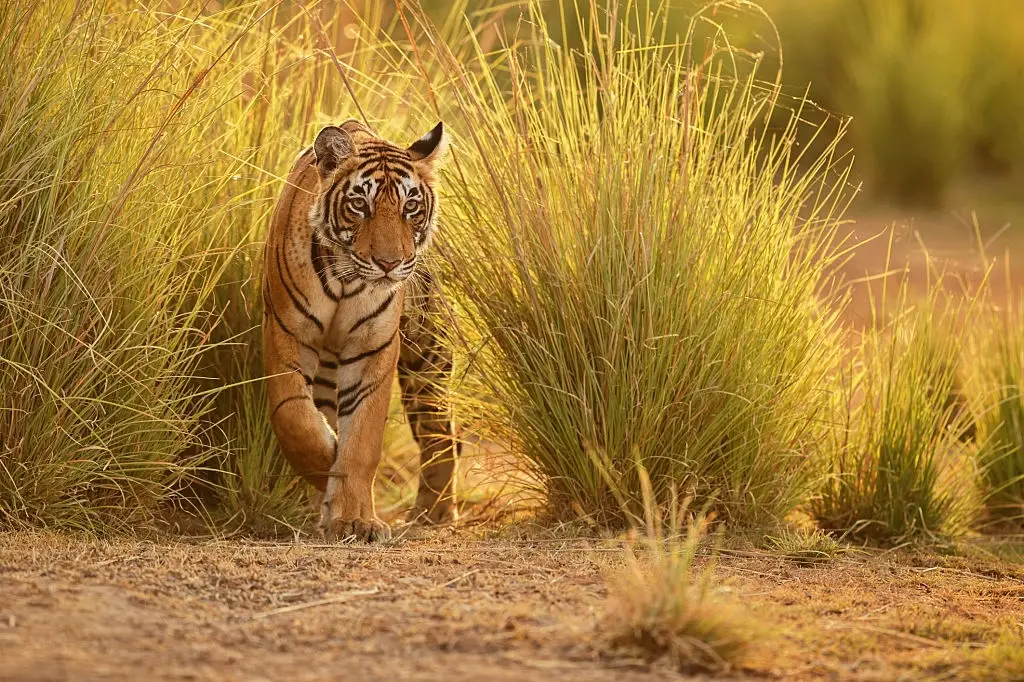
Accessibility to some big town, airport, or part of some tourist circuit also make the parks busy and popular. For e.g. Ranthambhore National Park is located in the heart of the popular golden triangle circuit of New Delhi, Agra and Jaipur, hence it is easily made a part of the itinerary.
Then there are national parks, which are equally good in bio-diversity and experience but not yet on that level of popularity from either accessibility or infrastructure point of view, like Satpura, Panna, Dudhwa, Sariska, Manas, Melghat, Sanjay Dubri, and Rajaji.
The popular national parks have plenty of tourist lodges, resorts, homestays, and hotels. They have accommodations for practically all budgets, from economy to luxury.
When is the best time to visit and do the tiger safaris in India ?
There are many theories and logic of the best time to see tigers. I firmly believe it all depends on your objective. You might like to see my video on best time to see tigers . A lot of people recommend the dry months, which generally is the norm, some prefer the winter months for many reasons, and some like the monsoon times. Therefore, it all depends on your objective on what you want to see, and in what background. Do watch my video on the above link to get an idea.
Then it is important to know which national parks are seen best in which months. Some parks and some zones within those are accessible only in certain times of the year. Therefore, you must know the same and then plan your tiger safaris in India. For any further information please feel free to write to us on [email protected]
Best Wishes
Sharad Kumar Vats
1 thought on “Tiger Tourism in India and All You Need to Know”
Afternoon Sir, Madam,
My wife and I are planning to bring our family ages 4, 8 & 11 from the UK to India in the first two weeks of April. We are keen to come on safari and see some tigers. Please could you suggest some holidaying options.
Kind regards – Ben Mottershead

Leave a Reply Cancel reply
Your email address will not be published. Required fields are marked *
Save my name, email, and website in this browser for the next time I comment.
507, Emaar The Palm Square, Sector 66 Gurugram - 122102, Haryana
[email protected] [email protected]
Sharad Vats : +91-9811200094
Top Tiger Safari Tours
- Corbett, Kanha & Bandhavgarh Tour
- Big Cats of India Tiger Safari Tour
- Luxury Tiger Safari in India Tour
- Kanha & Bandhavgarh Tiger Safari Tour
- Tiger Safari & Golden Triangle Tour
- Tiger, Taj & Temple Tour
- Elephant and Rhino Tour
- Snow Leopard Trip to Spiti Valley
- Tiger, Taj Mahal and Birding Tour
Tiger Safari Destinations
- Dudhwa National Park
- Pench National Park
- Satpura National Park
- Tadoba National Park
Explore Tiger Safari India
- About Nature Safari India
- Testimonials
- Tiger Safari in India
- Tiger Safari Travel Guide 2024
- Luxury Tiger Safari Tours in India
- Tiger Safari India Blog
- Nature Safari India Blog
- Privacy Policy
- Cancellation & Refund
- Other Important Information

Copyright © 2024 Nature Safari India
Partners and approvals

Privacy Overview
Please enable javascript in your browser to visit this site..
2022 is the Year of the Tiger: Here are 15 places to see them ethically in the wild
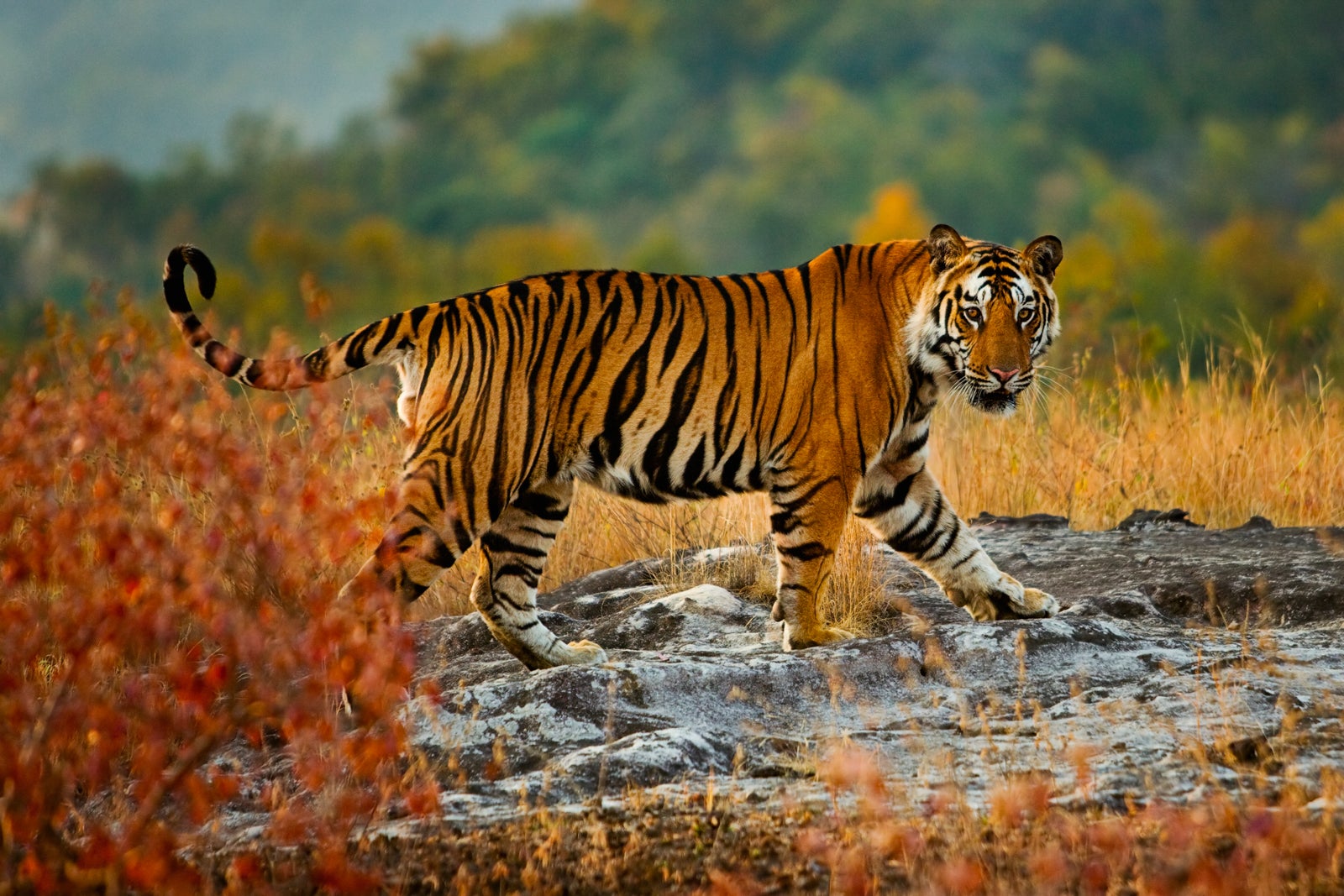
With the Tiger King, Joe Exotic, currently serving a 22-year sentence for murder for hire and animal abuse, and fewer than 3,900 tigers left in the wild worldwide, tiger tourism is at a crossroads. Those who dream of seeing these gracious and elegant cats in their natural habitat are more motivated than ever, while the world's consciousness has been raised about what constitutes humane treatment of one of the most revered species on Earth.
There's no time like the present to see them -- especially since the Year of the Tiger in the Chinese lunar calendar begins on Feb. 1, 2022.
Of all the big cat species, tigers have perhaps been the most drastically affected by a host of issues, from hunting and poaching to climate change and loss of habitat, with the result being that three of the original nine tiger subspecies are already extinct.
Of the six subspecies remaining, two -- the Sumatran and South China -- are now listed as critically endangered. In fact, no South China tiger has been seen in the wild in more than two decades and fewer than 100 remain in zoos.
Want more travel news and advice? Sign up for TPG's daily newsletter .
While it's tempting to want to visit tigers in private wildlife preserves like the now-closed facility featured in the "Tiger King" documentary, it's important to understand that by doing so you're supporting a poorly regulated industry where animals are frequently subject to abuse.
When considering a visit to any zoo, check that it has been accredited by the Association of Zoos and Aquariums , which requires that zoos meet strict qualifications for best practices regarding quality of habitat, cleanliness and veterinary care, and also participate in worldwide conservation initiatives.
"Outside of safaris in national parks located in South Asia and Russia, there is simply no truly ethical way to see a tiger. While tigers in major metropolitan zoos are well cared for, and often arrive as rescue animals, the same can't be said of most so-called rescue habitats or exotic animal parks, much less tiger encounter experiences in Asia," says Jeff Greenwald, executive director of Ethical Traveler, a nonprofit organization which seeks to use the economic benefits of tourism to protect human rights and the environment.
Noting examples such as the Thai Buddhist petting temple, which lost more than half of its 147 tigers to a virus, Greenwald says it's important to support only the zoos and other highly respected and rated institutions recognized for providing high-quality care. "If you are compelled to see a live tiger and can't afford a big trip to India, Nepal or Russia, see one in a legitimate zoo – like the Bronx or San Diego Zoo," says Greenwald. "Otherwise, ask yourself: Am I willing to have a tiger captured, drugged or caged so that I can take a picture of it?"
There are bright spots, though, in the midst of this darker reality, with the numbers of Bengal and Siberian tigers both increasing over the past decade. Along with those rising numbers have come numerous positive developments in tiger tourism, including better regulation and infrastructure improvements in several of the world's best tiger habitats. The result: Visitors have a better chance of seeing — and photographing — a tiger, without causing harm in the process.
Here, then, are 15 of the best — and most ethical — places to see tigers in the wild.
1. Bandhavgarh National Park, Madhya Pradesh, India
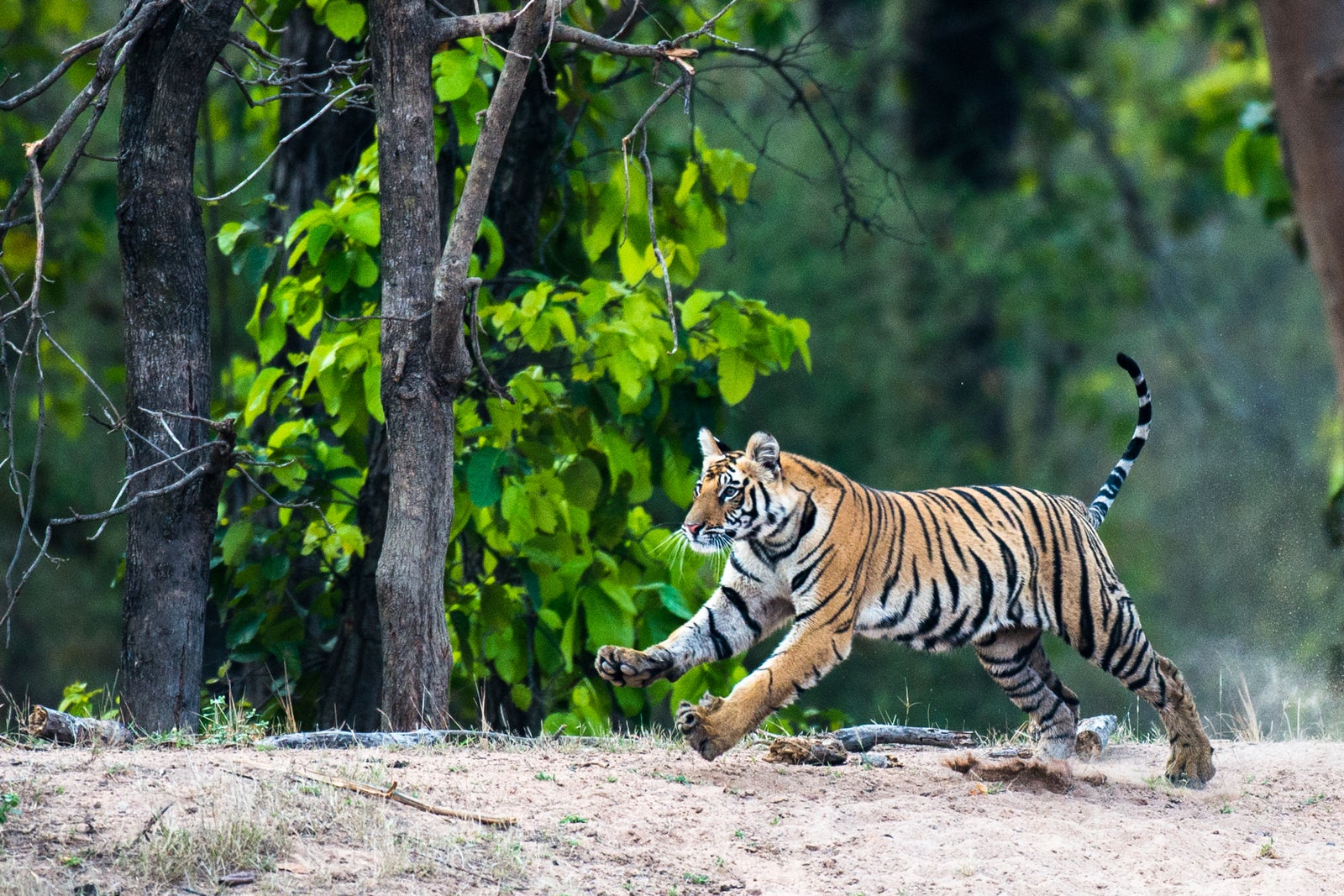
Known as India's "Tiger State," Madhya Pradesh is home to more than 70% of the world's wild tigers, making the state a magnet for those intent on a tiger sighting. More than 2,226 Bengal tigers inhabit this region, considerably upping your chances of seeing a tiger, especially if you hit more than one park.
Of Madhya Pradesh's 50 tiger reserves, Bandhavgarh National Park is one of the best for tiger safaris.
2. Satpura National Park and Tiger Reserve, Madhya Pradesh, India
Connected to other Indian wildlife parks by wildlife corridors, Satpura National Park is part of the largest tiger habitat in the world. Unlike most tiger reserves, Satpura offers numerous safari options beyond jeep tours, including touring the park by boat and on foot. In addition, deer, gaur and other wildlife graze the park's broad meadows and crocodiles sun themselves on the banks of slow-moving rivers.
3. Kanha and Pench national parks, Madhya Pradesh, India
If the dense and vine-draped forests of Kanha National Park and Pench National Park look straight out of "The Jungle Book ," they actually are — author Rudyard Kipling is said to have set his 1894 book in the area, including mention of the nearby city of Seoni. Interestingly, Kipling himself never actually visited the area, though he grew up in Mumbai (then known as Bombay) and spent some years working as a journalist in other parts of India, so he knew the country well. In addition to the jungle habitats, Kanha features expansive meadows where it's easier to see tigers when they step into the open. For the deepest experience of tigers in Kanha and other central Indian parks, see them through the eyes of a local tour guide experienced in wildlife management, such as a trip organized by Wilderness Travel .
4. Kaziranga National Park, Assam, India
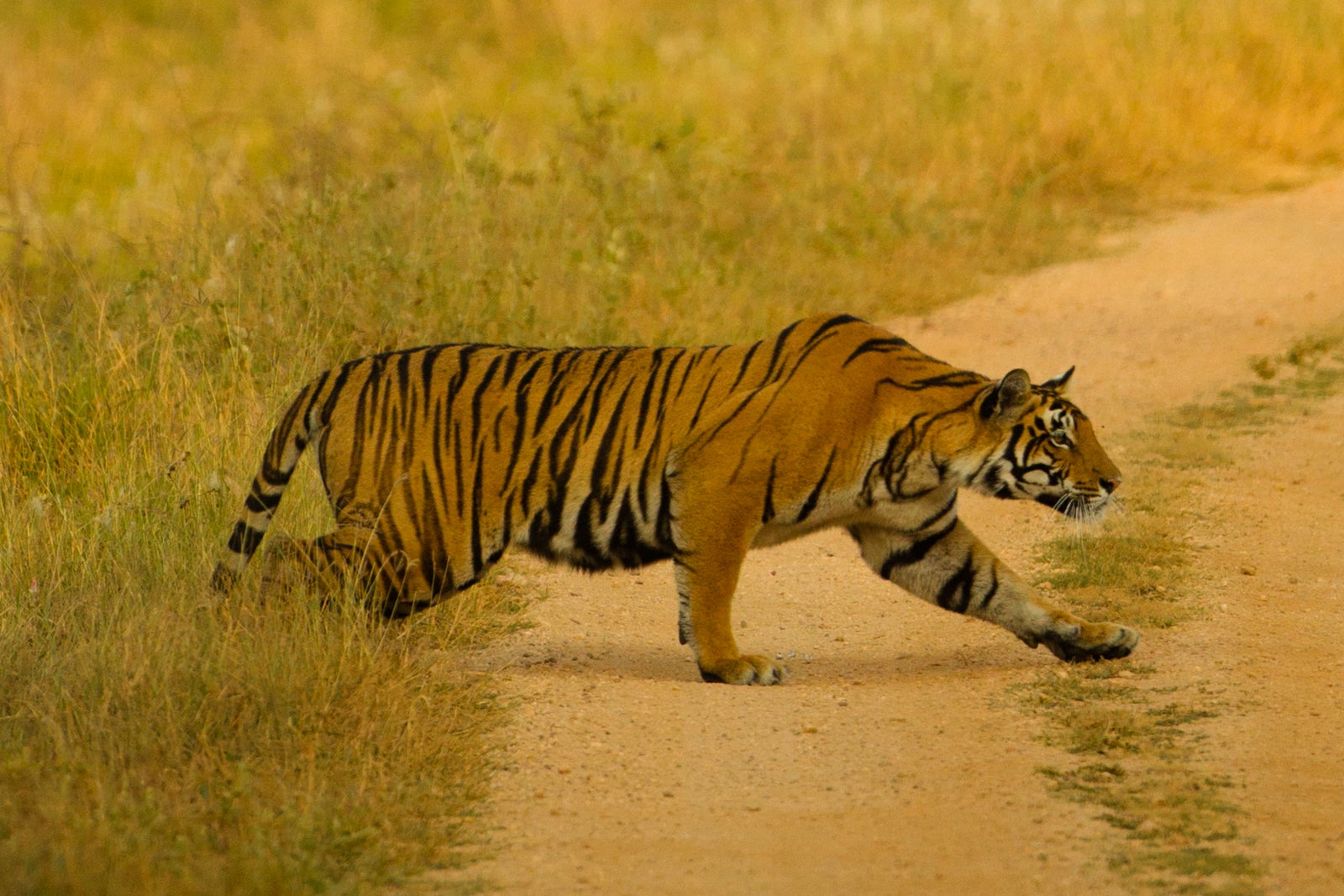
A trip to Kaziranga National Park in India isn't just about the tigers, since these lush meadows are just as well known for their population of one-horned rhinoceros, which make up close to two-thirds of the world's population. Still, there are 111 Bengal tigers here in a fairly dense area, making it a favorite for tiger-spotting. Elephants and leopards up the fun factor as well.
5. Bandipur National Park, Karnataka, India
Spanning the lush valleys of the Kabini and Moyar rivers, Bandipur National Park shelters some 109 tigers at last count. Boasting one of the highest densities of tigers per acre, Bandipur also offers wildlife photographers a wealth of other options, from Indian elephants and sloth bears to more than 200 species of birds.
6. Melghat Tiger Reserve, Maharashtra, India
Situated in the Satpura mountains near the hill town of Chikhaldara, 890-square-mile Melghat Tiger Reserve is one of India's largest tiger parks. More than 60 tigers roam the banks of the Tapti River and its tributaries. Visitors often combine a safari in Melghat with a visit to Chikhaldara and the 13th-century Mughal fortress of Gawilgarh.
7. Ranthambore National Park, Rajasthan, India
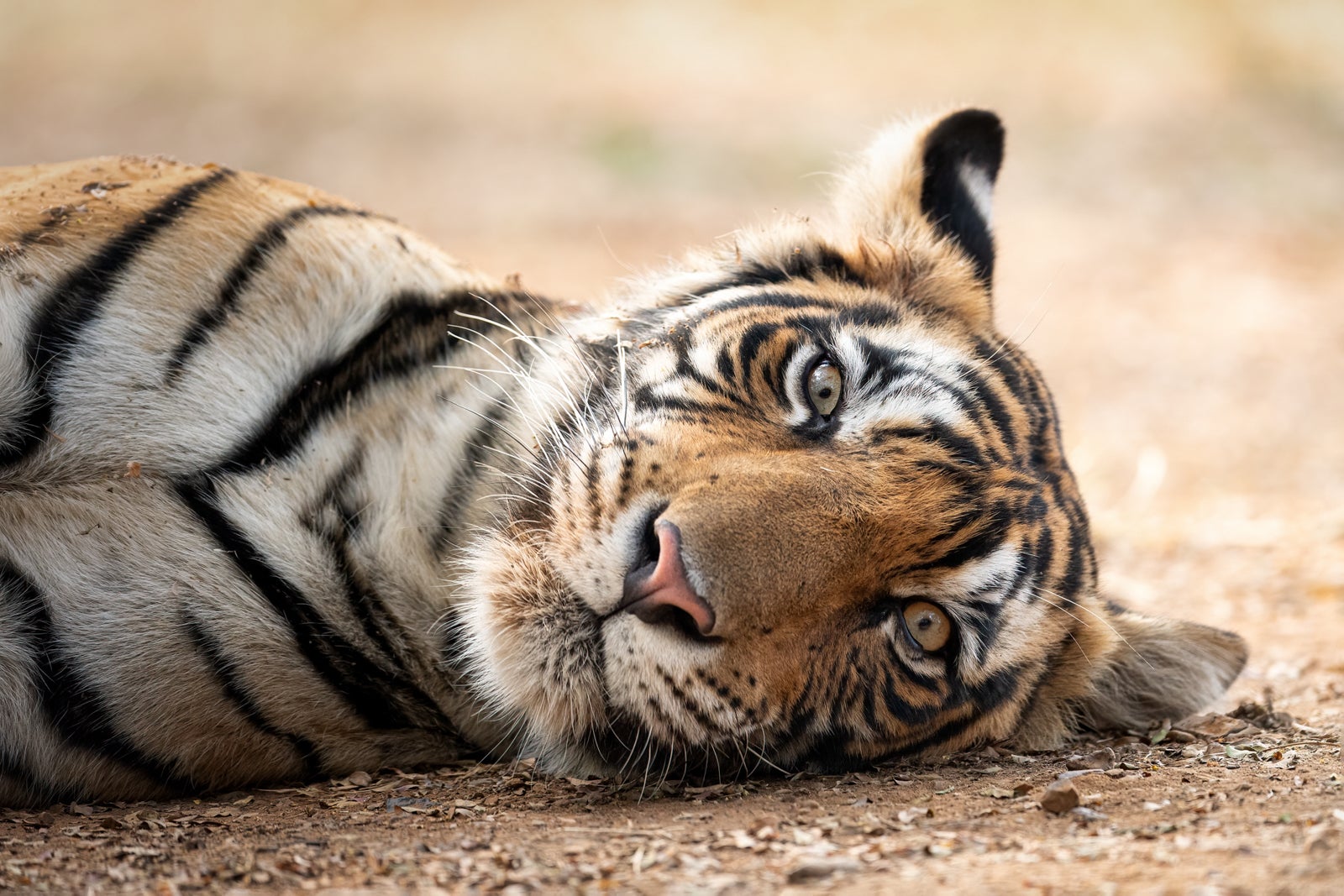
Once the royal hunting grounds of the maharajahs of Jaipur, Ranthambore National Park lures visitors with its romantic history along with its wildlife. While the park was relatively small when first established in 1955, it's been expanded over the years to 1,334 square miles, making it India's largest tiger park. Ranthambore is one of India's more popular tiger parks both due to its location in attraction-rich Rajasthan and for its high chances of tiger-spotting. Don't miss the ruins of Ranthambore Fort, built between the 10th and 16th centuries, high on a rocky butte and affording astonishing views.
8. Jim Corbett National Park, Uttarakhand, India
Called Hailey National Park when it was established in 1936 and renamed for a noted big game hunter and tiger conservationist, Jim Corbett National Park is India's oldest national park. It was here in 1973 that Corbett founded Project Tiger, now the National Tiger Conservation Authority, which played a powerful role in allowing so many of India's tigers to survive today. More than 230 tigers live in this national park which, unlike most others, has facilities for overnight stays, increasing your chances of a tiger sighting.
9. Jigme Singye Wangchuck National Park, Bhutan
When the Bhutanese government launched its first tiger count in 2015, the country's tiger population stood at 103, a number the government has proposed to double over the next decade. While Bengal tigers roam across much of the densely forested mountainous country, Jigme Singye Wangchuck National Park is one of the best places to see them, along with red pandas, golden langurs and rare clouded leopards.
10. Royal Manas National Park, Bhutan
Home to fewer than 30 critically endangered Bengal tigers, Royal Manas National Park was recognized by the World Wildlife Fund in 2020 for more than doubling its tiger population from just 12 tigers in 2008. Connected at its southern edge with India's Manas Tiger Reserve and at its northern edge with Jigme Singye Wangchuck National Park, Royal Manas greatly expands the territory over which the tigers can wander.
11. Sunderban National Park, Bangladesh
More than 200 Bengal tigers live in this swampy wetlands preserve in southwestern Bangladesh on the border with India. Canoe safaris are the transport of choice in Sunderban National Park, since its jungle-shrouded rivers are easier to navigate by boat than by vehicle, and the tigers are particularly entertaining to watch thanks to their penchant for swimming.
12. Bardia National Park, Nepal
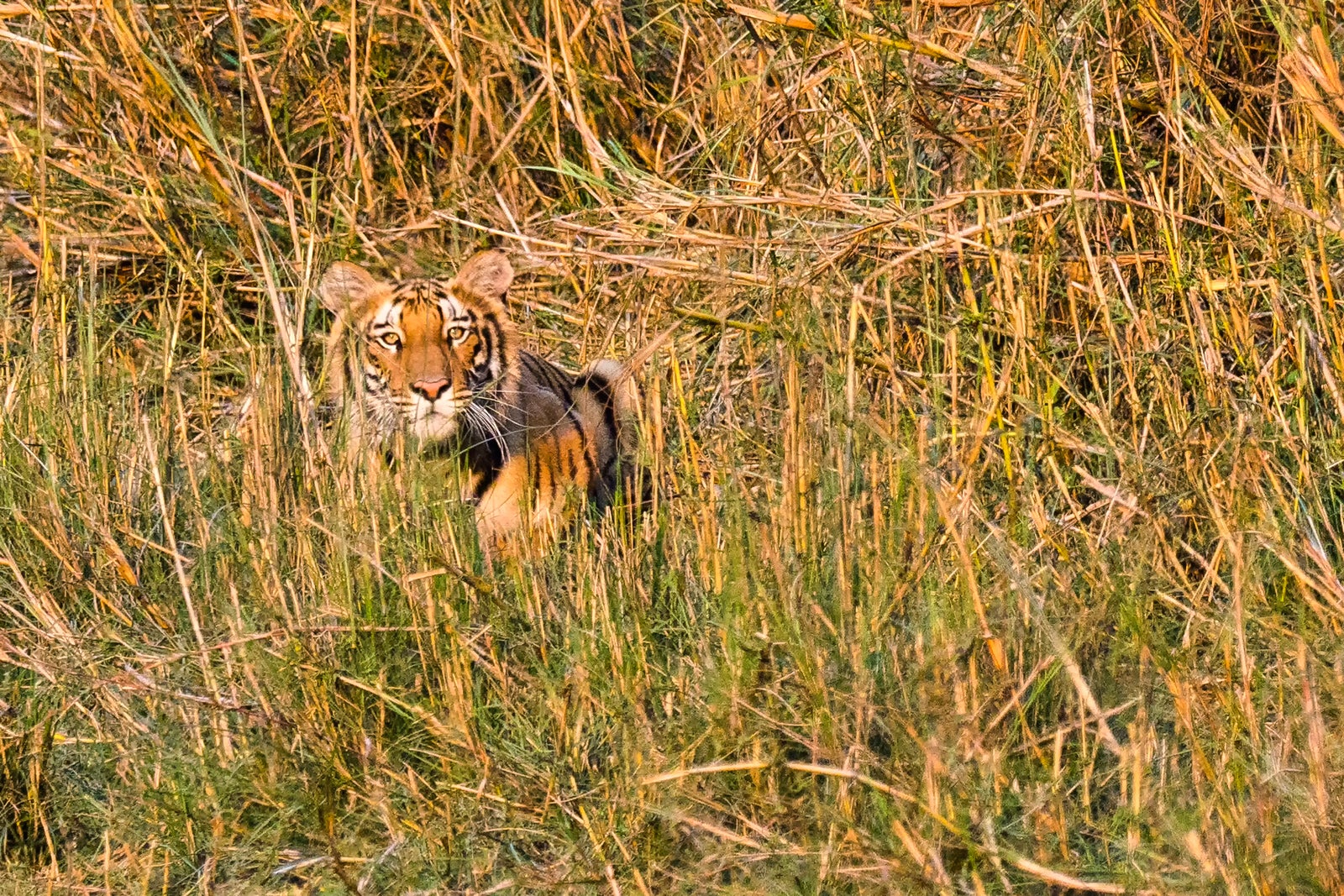
Nepal can boast one of the best tiger success stories, with the population almost doubling over the past decade. At least 235 tigers live in the country's five national parks, with Bardia National Park having the most with a population of approximately 80. In Bardia, you have a choice between a walking safari and a jeep safari. Opt for a full-day rather than half-day trip to increase your chances of seeing one of the park's resident tigers — but you'll feel just as lucky if you see one of the park's wild elephants or one-horned rhinos.
13. Chitwan National Park, Nepal
More accessible than Bardia thanks to its location near Nepal's southern border with India, Chitwan National Park has seen its conservation efforts pay off with the tiger population increasing to 235. The park's one-horned rhinoceros population is another success story, up to almost 700 from a low of 100 in the late 1960s. Even if you don't spot a tiger, a visit to Chitwan is worthwhile for a chance to watch these prehistoric-looking beasts.
14. Durminskoye Forest Reserve, Russia
This section of the taiga forest in far eastern Siberia, home to the last remaining Siberian tigers as well as rare Amur leopards, is top on the list for big cat aficionados determined to see the rarest of the rare. Remote is an understatement for this wild region, best explored as part of an organized Siberian wildlife tracking tour through a reputable outfitter such as Wild Voyager or Naturetrek .
15. Zov Tigra National Park, Russia
With a name that translates as "call of the tiger," Zov Tigra National Park defines its existence as the last refuge of the endangered Siberian or Amur tiger, the largest of all the big cats. Only 500 of these magnificent cats remain in the world, and seeing them requires joining a responsible tiger expedition best suited to the more adventurous traveler. Even so, expedition organizers warn that travelers have a 1 in 8 chance of seeing one of these elusive cats, which prefer the cover of the region's dense forests.

Bringing tigers back to Cambodia
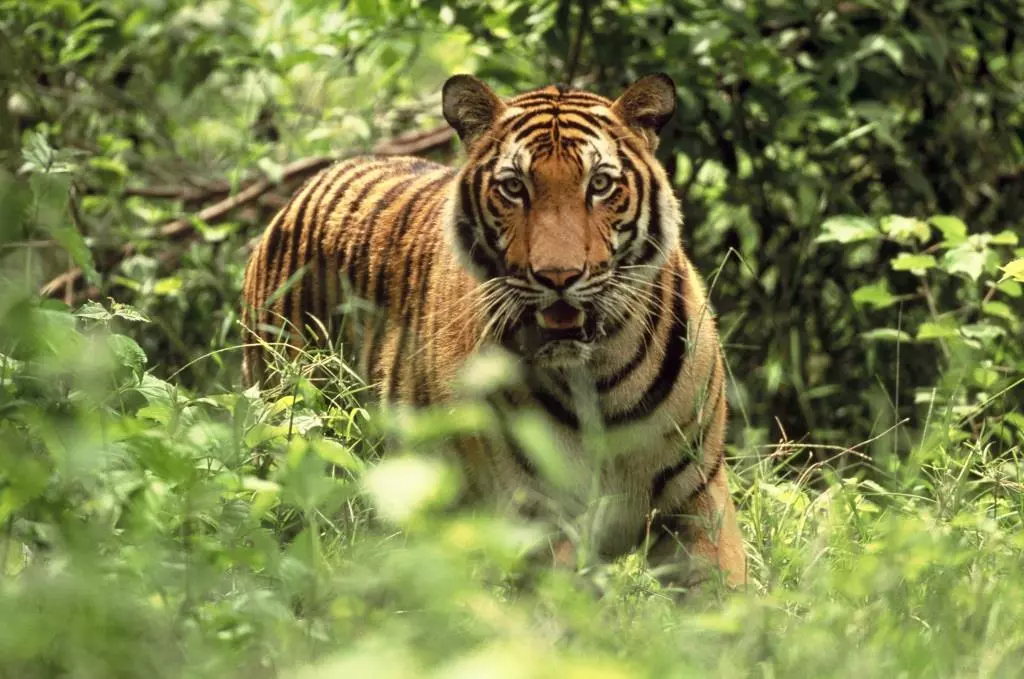
On this day in 2010, tiger range countries came together with a bold ambition: to double the number of tigers by 2022. Now, Cambodia is making good on its plan to reintroduce tigers. Here’s an explainer on tiger reintroduction in the Cardamom Rainforest Landscape.
A Happy World Tiger Day Update: On 28 July 2022, a cross sectoral Consultation Meeting was held between the Mnistry of Environment (MoE), Wildlife Alliance and other key stakeholders on Tiger Reintroduction and Tiger Prey Restoration Program . This is a great step forward for tiger reintroduction plans.
First, a little history about wild tiger populations. Around the world, tiger numbers have been dropping over the past decades.
Once upon a time, tigers once roamed over a huge area, from Turkey to Russia’s eastern coast, but by the end of the 20th century their numbers had plummeted. In fact, between 1993 and 2014, around half of the world’s tigers were lost. Why? Tigers need large territories to hunt and breed effectively. But human modifications like urbanization and agricultural expansion means that tigers now occupy just 7% of their original range. Today, tigers survive in small, isolated pockets of forest, where they are vulnerable to poaching.
Today, tiger numbers are gradually rebounding in South Asia, but rampant poaching and habitat degradation continues to push tigers to the brink of extinction in Southeast Asia. Right now, tigers have been virtually wiped out in Vietnam and Laos PDR and barely cling on in Malaysia and Indonesia.
Meanwhile, in Cambodia, tigers were declared functionally extinct in 2016. The Royal Government of Cambodia and Wildlife Alliance wants to change that. As Wildlife Alliance CEO Suwanna Gauntlett told the Guardian at the time, the tiger has “been hunted to extinction because of weak law enforcement and the government is now reacting.” Together, we formulated a bold plan to bring tigers back to Cambodia. That is the essence of tiger reintroduction.
Details of tiger reintroduction in Cambodia are included in the Cambodia Tiger Action Plan (CTAP) 2011-2022. This was drafted by relevant government agencies and partners, including Wildlife Alliance. The Plan was approved by the Royal Government of Cambodia in March 2016 . The CTAP is a species management plan which reflects Cambodia’s commitment to the TX2 global goal to double tigers by the year 2022. Since then, the Royal Government of Cambodia and Wildlife Alliance has launched a world first: a transnational tiger reintroduction plan .
Wildlife Alliance works with the government and local communities to protect one of the last unfragmented rainforests in Southeast Asia: the Cardamom Rainforest landscape, which is now the priority site in Cambodia for tiger reintroduction.
Together with government partners, Wildlife Alliance has protected the Cardamoms since 2002. Together, we address threats through hands-on protection of some 1.2 million hectares of dense rainforest in the Cardamoms. To do this, we create strategic protection plans, conduct zoning and demarcation, provide critical environmental education and support communities to develop conservation-friendly activities like community-based ecotourism . Read more about how we protect the Cardamoms here .
There are many benefits to reintroducing tigers in Cambodia. The most obvious one is perhaps restoration of balance to the ecosystem.
Restoring balance in the ecosystem
Right now, the Cardamom Rainforest Landscape is missing its top predator: the tiger. Without this big cat to keep prey animal numbers in check, things can get out of whack. That said, this may be to the advantage of the next biggest cat, clouded leopards which still roam the Cardamoms !
Few people understand the importance of tigers better than Indian Prime Minister, Narendra Modi who is himself a great guardian of tigers.
Speaking at the 3rd Asia Ministerial Conference on Tiger Conservation in New Delhi,
Modi stressed that “by protecting the tiger, we protect the entire ecosystem and the ecological services, which are equally crucial for the well-being of human beings.”
WWF, the author of the TX2 goal agrees.“[I]t is important to be clear,” said WWF Cambodia’s country director Seak Teng , “that by saving tigers we are saving much more.”
The great news is that key stakeholders are committed to addressing threats to tigers. Ministry of Environment spokesperson Sao Sopheap emphasised that the government is “[sending a] bigger signal to country, to community, to general public that the government is very serious about conservation.”
Cambodia can contribute to global tiger conservation
Conservationists argue that as one of 13 tiger range countries, Cambodia owes the world every effort to help towards the goal of doubling tiger numbers. Help is at hand with the introduction of enhanced forest protection measures via new ranger stations, plus the expansion of the REDD+ Project which supports and incentivises conservation-friendly activities for rainforest communities in the Cardamoms. This expansion means coverage beyond the current Southern Cardamom National Park, to the northern Phnom Samkos Wildlife Sanctuary. Both of these protected areas are included within the proposed tiger reintroduction release site areas.
Tiger Tourism potential in Cambodia
The opportunity to see tigers in the wild via managed tourism sites will no doubt attract visitors to Cambodia, as in India. This opportunity gives tourists a reason to extend their stay in the Kingdom beyond paying a visit to Angkor Wat, which has been an ambition of the Ministry of Tourism for some time. However, for Cambodia to benefit from tiger ecotourism dollars will take significant investment, as noted by Minister of Tourism, Thong Khon : “sustainable wildlife conservation requires ample financial resources.” Mr Khon went on to state the Ministry’s commitment to working with related stakeholders to make this happen. Fortunately, the Ministry of Environment now has a financial mechanism in place to make this happen: the Southern Cardamom and planned Phnom Samkos REDD+ Projects .
Tigers need a large, continuous range with abundant prey and protection from hunting. The network of protected areas in the Cardamom Rainforest Landscape offer a vast expanse of forest cover, grasslands, and wetlands that are ideal for tiger reintroduction. These protected areas include the Southern Cardamom National Park, Tatai Wildlife Sanctuary and Phnom Samkos Wildlife Sanctuary.
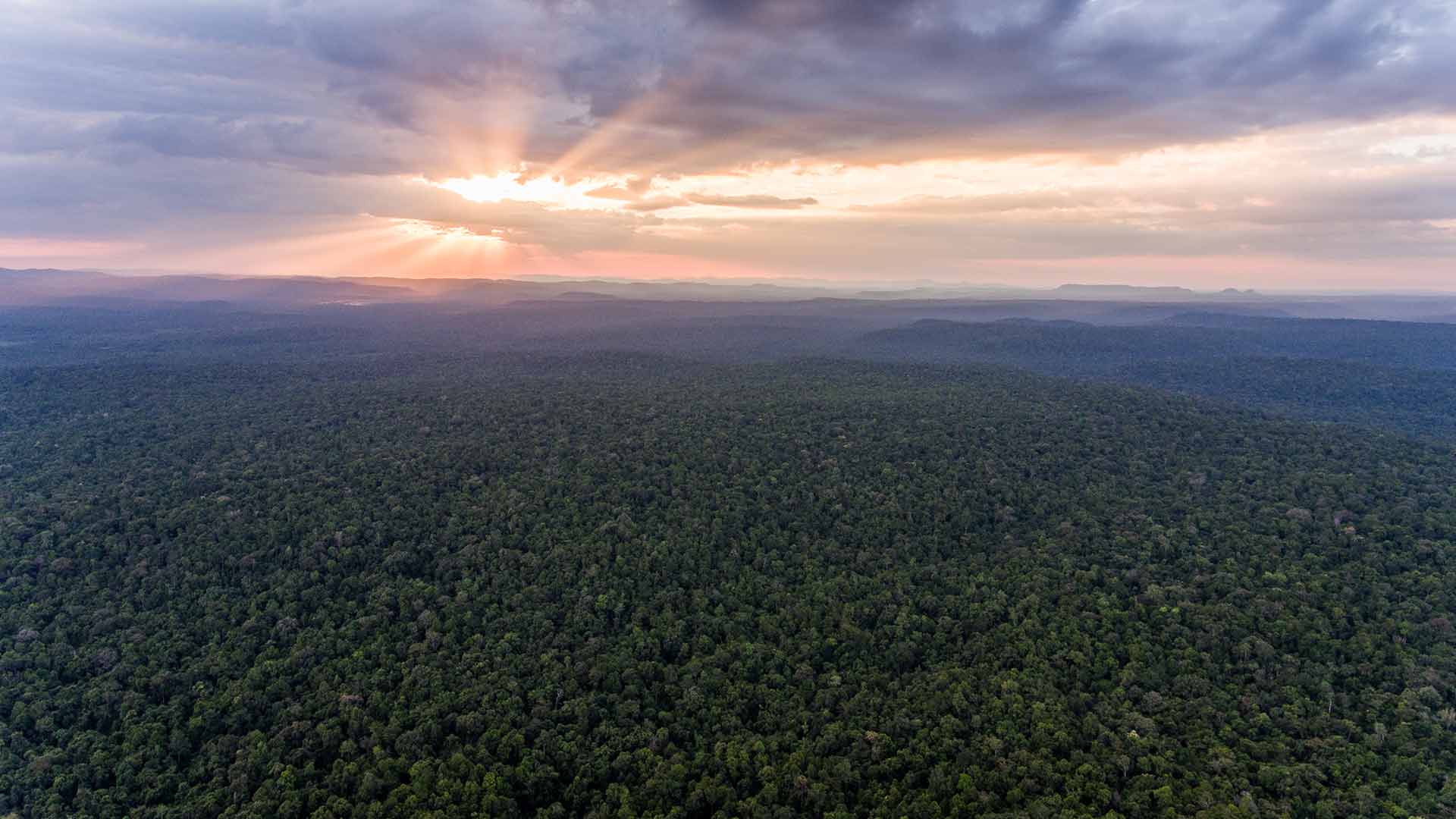
A History of Key Actions for tigers in Cambodia
- 2007: Last records of tiger in Cambodia 2011: Inception of the Cambodia Tiger Action Plan
- 2016: Cambodia Tiger Action Plan approved by the Royal Government of Cambodia
- 2017: Cambodian Prime Minister Hun Sen’s endorses tiger reintroduction in the Cardamom Rainforest Landscape
- 2018: Launch of the Southern Cardamoms REDD+ Project
- 2020 & 2021: 2 new ranger stations opened in Cardamom Rainforest Landscape
- 2021: Third tiger prey base survey
- 2022: Inception of the Phnom Samkos REDD+ Project
The number one priority is to reduce threats to tigers, including those which wiped them out in Cambodia in the first place. This translates into more rangers on the ground to patrol tigers’ future home. This is exactly what Wildlife Alliance has done by opening 2 new ranger stations since 2020, in addition to its other 9 operational stations throughout the Cardamoms. These ranger teams conduct over 5,000 patrols every year and have removed over 300,000 snares to date.
Another important step is increased community engagement, which is happening through support for development of conservation-friendly activities like community-based ecotourism plus financial and technical assistance of essential infrastructure such as water wells . In addition, free and prior informed consent will be sought and there are plans for a Livestock Compensation Fund for affected communities.
In terms of protocol, the proposed tiger reintroduction site in the Cardamoms meets species requirements, including:
- Inviolate Core Zone >2,000-km 2 : created and secured*
- Prey base : 3 tiger prey base surveys conducted, finding good tiger prey density
- Law Enforcement: professionally equipped, trained, and supervised rangers in <4 Patrol Stations strategically situated around the Tiger Core Zone
- Human-Wildlife Conflict prevention: safeguards developed
- Water sources : rivers and streams are present and well distributed throughout the landscape.
- Community engagement : good community support. A FPIC and Livestock Compensation Fund are planned *Within the core zone, there are zero human settlements, with the nearest 25km away.
This is the million dollar question! As above, things are falling into place for tigers to return to Cambodia. The habitat is suitable and protected, tiger prey is sufficient and the government is onboard.
The rest is down to continuing technical and capacity building efforts, alongside community consultation and engagement. In summary, “tigers need three things,” as John Goodrich,
Chief Scientist and Tiger Program Senior Director for global wildcat conservation organisation Panthera , noted five years ago . “They need space with good habitat… They need prey. And they need to be left alone. They need protection from people, they need protection from poaching.”
In 2017, Goodrich’s conclusion was that achieving those three things was “going to be a huge challenge in Cambodia.” We agree. But here at Wildlife Alliance, we are doing the work to make tiger reintroduction happen in the near future.
Share This Story, Choose Your Platform!
About the author: wa admin.
Related Posts

Wildlife Alliance statement: BBC Panorama

Wildlife Alliance Statement
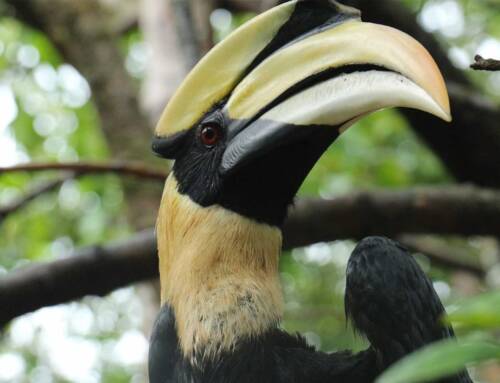
Give More this Giving Season!
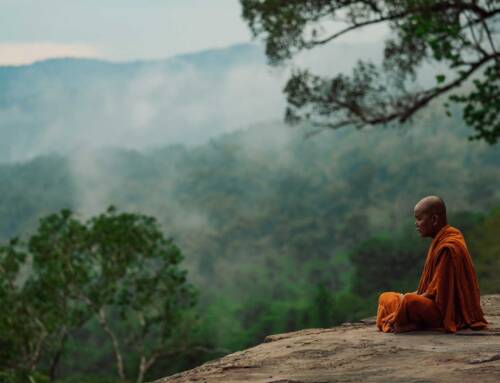
Wildlife Alliance celebrates Cambodia’s Independence Day recognizing preservation of Southern Cardamom Rainforest

Importance of Tourism for Tiger Conservation in India
- Sharad Vats
- February 6, 2023

Tourism can help protect tigers by giving local communities and governments economic benefits that make it more likely for them to protect and keep tiger habitats. Eco-tourism activities, like wildlife safaris and trekking, can give people who live near tiger habitats a direct source of income while putting less pressure on forests and wildlife. In addition, the revenue generated by tourism can be used to fund conservation programs and anti-poaching efforts. However, it is important to ensure that tourism is developed and managed in a sustainable manner to minimize negative impacts on tigers and their habitats.
What is sustainable tiger tourism?
Sustainable tiger tourism is a type of ecotourism that supports the conservation of tigers and their habitats in a responsible and sustainable manner. It is characterized by practices that minimize negative impacts on the environment and wildlife, and prioritize the well-being of local communities and the long-term viability of tiger populations. This includes:
- Implementing best practices for wildlife viewing, such as using responsible and ethical guiding principles, avoiding overcrowding, and not disturbing tigers and other wildlife directly.
- Supporting local conservation efforts, like those that try to stop poaching, fix up habitats, and get people involved in conservation.
- Giving economic benefits to local communities, such as jobs, income, and the building of infrastructure.
- Keeping the environment healthy by using renewable energy sources, getting rid of waste, and saving water.
- Raising awareness about the importance of tiger conservation and promoting responsible wildlife tourism.
Overall, sustainable tiger tourism in India can provide significant benefits to both tigers and local communities while supporting the long-term viability of these magnificent animals.
What are good practices being followed in tiger tourism in India today?
In India, some of the good practices being followed in tiger tourism today include:
Regulated tourism zones: The Indian government has established regulated tourism zones in tiger reserves, where tourism is managed in a controlled manner to minimize disturbance to tigers and their habitats.
Community involvement : Local communities are often involved in tourism management, providing opportunities for income generation and livelihood improvement, while also promoting conservation awareness.
Responsible wildlife viewing : Tourism operators follow responsible rules for wildlife viewing, such as staying away from tigers, driving at the right speed, and keeping a safe distance from animals.
Environmental sustainability : Ecotourism infrastructure is developed in an environmentally sustainable manner, such as using renewable energy sources and minimizing waste generation.
Anti-poaching efforts : Revenue generated from tourism is often used to support anti-poaching efforts and wildlife conservation activities, helping to ensure the long-term survival of tigers and their habitats.
Awareness raising : There are often educational parts to tiger tourism, like guided walks and interpretive talks, that aim to teach people about how important it is to protect tigers and encourage responsible wildlife tourism.
Overall, these good practices are aimed at ensuring that tiger tourism in India is sustainable, beneficial for tigers, and supportive of local communities.

What are the areas for improvement in tiger tourism practices in India?
Despite the good practices being followed in tiger tourism in India , there are still areas for improvement in order to ensure sustainable and responsible tourism that supports tiger conservation:
Monitoring and enforcement: The monitoring and enforcement of tourism regulations and guidelines, particularly in less regulated areas, can be improved to ensure that negative impacts on tigers and their habitats are minimized.
Sustainable tourism development : The development of tourism infrastructure can be improved to ensure that it is environmentally sustainable, socially responsible, and economically viable.
Community engagement: More can be done to involve and give local communities more power in tourism management and decision-making so that they get the most out of tiger tourism activities and are fully involved in them.
Wildlife viewing practices : The education and training of wildlife viewing guides can be improved to ensure that they follow best practices and prioritize the well-being of tigers and their habitats.
Revenue distribution : The way that tourism revenues are shared out, especially to local communities and conservation projects, can be made fairer and help long-term conservation efforts.
By addressing these areas for improvement, tiger tourism in India can be developed in a responsible and sustainable manner that provides economic benefits, supports conservation efforts, and enhances the overall well-being of local communities and tigers.
What is the role of a tourist in a tiger reserve?
The role of a tourist in a tiger reserve is to be a responsible and respectful visitor who supports tiger conservation through their actions. This includes:
Following regulations and guidelines: Tourists should follow all rules and regulations set by the tiger reserve and park authorities. For example, they should stay away from animals and watch them in a responsible way.
Supporting local communities : Tourists can support local communities by patronizing local businesses and purchasing locally-made products.
Minimizing impact : Tourists should minimize their impact on the environment by following Leave No Trace principles, such as properly disposing of waste and conserving resources like water and energy.
Being an informed and responsible traveler : Tourists should educate themselves about tiger conservation and responsible tourism practices, and take an active role in promoting these values.
Supporting conservation efforts : Tourists can help protect the environment by choosing tour operators who are responsible and by giving money to conservation groups and projects.
By doing these things, tourists can help protect tigers and make sure that their habitats will be healthy and able to support them for years to come.
Travel with us on your must-in-a-lifetime tiger safari tour in India to contribute towards our motto “conservation through tourism”.
TripAdvisor
Recent posts.

Decoding the Age of Wild Indian Mammals – Field Observations and Techniques

3 Types of Crocodiles & Where To Find Them In India

National Parks Of India – 2024 Stats, Facts & Conservation

Dispersal of tigers who traveled maximum distances to find their home

Important Guide for First-Time Travelers To India

Becoming a Wildlife Guide in India: Requirements & Opportunities

Tiger Safari In India – Best Parks & Best Time To Visit

The Legend of the Champawat Tiger – Terror, Tragedy, and Triumph
Tiger Safari India Tours & Holidays I-36, 2nd Floor, South City 1, Gurgaon, Haryana 122001, India
[email protected] [email protected]
Deepkul: +91-9144-200-272
Top Tiger Safari Tours
- Just Tigers Tour
- The Land of The Jungle Book
- Ranthambore, Kanha Bandhavgarh
- Tiger Safari in Bandhavgarh
- Tiger Safari in Kanha
- Tiger Safari in Corbett
- Tiger Safari in Ranthambore
- Luxury Central India Safari
- Tiger Elephants Rhino Tour
Tiger Safari Destinations
- Bandhavgarh National Park
- Corbett National Park
- Kanha National Park
- Ranthambore National Park
- Dudhwa National Park
- Panna National Park
- Pench National Park
- Satpura National Park
- Tadoba National Park
Explore Tiger Safari India
- About Tiger Safari
- Testimonials
- Bespoke Tours
- Tiger Safari India Gallery
- Tiger Safari Travel Guide
- All Top Safari Tours
- All Top Safari Destinations

Copyright © 2023 Tiger Safari India (A Unit of Nature Safari India Pvt Ltd)
Partners and approvals

TourismTiger uses cookies to give you the best possible service. If you continue browsing, you agree to our use of cookies. More details can be found in our privacy policy .
A Day in the Life of Tourism Tiger
When it comes to learning more about the people behind Tourism Tiger, we’re much more than just the photos and names you see on our about us page (opens in a new tab) . Going through our blog you can gain insight into our blog team (opens in a new tab) , and when you work with us on a project you’ll get to know our content creators and designers better. Then through TigerCare (opens in a new tab) , you’ll encounter our technical team.
All that being said, we decided to pull back the metaphorical curtain so you can get to know the team better. So if you ever wanted to learn more about the Tourism Tiger team, now’s your chance! We did a brief survey among our colleagues to share some insight into our day-to-day happenings, our thoughts about our jobs, our customers, and what we think about travel in general.

Here’s a breakdown of the respondents so you can keep track, and also because we have a lot of people whose names start with the letter A!
Andie (Andrea L.): Lead Designer
Andrew: Head of TigerCare
Imogen: Web Coordinator
Andrea: Marketing Manager
Elliot: Designer
Alex: Developer
Gareth: Web Team & Project Manager
Alice: TigerCare Specialist

1- What is a typical day like for you working at Tourism Tiger?
Andie: Well, there’s no such thing as a typical day for me at TT! Every day is very different, a new project, a new destination, a new design and implementation, and a new challenge! But a cup of hot chocolate in the morning might be the only typical thing about it. When I’m not building and styling websites, I’m traveling through the world with our clients’ photos, selecting and resizing them to fit in our building system. Working side by side with the Project team, I also lead our design department, and I’m always looking for ways to improve our internal processes, our communication with clients, and their satisfaction with our services and products. Typically I’d also speak with our Dev team to perform Q&A tests to perfect and improve our website features and work hand in hand with our Marketing team producing beautiful and attractive content for our potential clients and the development of our brand. Again, no day is ever the same and that’s what I like the most about TT!
Andrew: Start off by checking open tickets and getting responses in as soon as possible to clients. That will also help me plan what tasks I’ll be doing during the day. Then I’ll also try to check the Dev board as early as possible to see any updates on new features or outstanding bugs. On average, I’d say I can usually expect to be talking to a client in some capacity (review call, intro to TC call, backend training, other) at least once a day as well. To fill in gaps, I’m usually working on research (new features, bugs, data for the industry based on our clients), blogs here and there, and manually checking and updating sites, as well as answering any technical questions that people on the team may have.
Imogen: Every day is different! It depends where we are with projects, I can be building, researching, writing, editing, talking to clients. I can also be researching and writing blogs for the TT site.
Andrea: A typical day for me is any combination of the following: business strategizing, research, organizing our social media channels (including the graphics, the captions, and looking up interesting news articles to share), overseeing our internal blog which includes gathering topics for our blog team to write about, coordinating all aspects of guest post submissions, and writing blogs myself. Then there’s also putting together external emails and our weekly newsletter as well as collaborating with our partners in the industry. I am also constantly working with my colleagues in other departments on all sorts of improvements and initiatives. And of course, lots of emails!
Elliot: Putting on my headphones and listening to music or a podcast while I’m styling a site or creating a logo.
Alex: Mostly it’s a dark screen with colored letters, a kind of athletic brain activity, and as a result some new features pop up or some features start working better. Sometimes ideas come quickly, sometimes really slow, but it’s always great to feel victorious when something tricky is completed.
Gareth: A typical day for me here at TT begins with a good trawl through the emails. I’ll then reflect on the to-do list I made the previous day and ensure everyone in the team is good and has a plan/no questions. I do like taking a few minutes away from the screen to make a tea or a mate too, it’s important to give the eyes and head a little break but overall, just ensuring our focus has been set for the day and everyone’s happy.
Alice: A typical day for me varies depending on clients needs and our website build schedule, but it generally consists of responding to and resolving tickets (this could be anything from a simple content change to figuring out why something isn’t working on the site to analyzing site traffic to improve SEO), review calls, writing metadata, and launching sites.

2- What is the biggest misconception about what you do or your role?
Andie: That I know everything!!! Even though I’ve been with TT for 4 years now, I feel like I only know half of the technical aspects of web design and development. I quite often make mistakes that teach me how to do better next time, but embracing failure and not knowing everything means there’s always room for improvement and new things to learn every day. The idea is to never stop trying!
Andrew: The biggest misconception would maybe be that I’m close to a developer. While I do consider myself a little more in-the-know with technical knowledge, most things related to code on the sites are above my head. I’ll likely do some research or just go to our developers if I get any questions like that from clients or the team. In reality, I’m much more focused on customer service. Obviously, I want the sites to operate well and have great UX, but I consider it more important that we (TigerCare) offer pristine customer service. When it comes to the sites, we are tech support, but the service is so much more than that. We are always happy to offer industry advice on anything related to the site and work with clients to make their sites how they want them.
Imogen: That all web coordinators do is write. We spend a lot of time on client relationships and as website building is a big stage in the project, a lot on that too.
Andrea: Probably underestimating that I have my hands in many things at any given moment: social media, emails, blogs, planning and strategizing, data analysis, working on improvements, and any other unplanned things that my colleagues need my help with. Also, people think that working in social media is all for fun, but it’s entirely different than personal use. I’m not just there for entertainment purposes, I’m doing research, looking for trends, and promoting our brand. Plus it’s B2B social media rather than B2C.
Elliot: Sometimes I’m asked about development stuff which is not my area, as my specialty is in design, but this does help generate ideas and notes to pass along to the developers to then develop new things or make improvements.
Alice: I think some people have the idea or hope that we (TigerCare) are experts in everything: SEO, marketing, design, coding, etc. However a lot of my time is spent researching and being the bridge between the client and the developers, designers, booking software, or hosting platform for example. I don’t know the answer to everything right away, so I appreciate it when clients have a bit of patience as we look for a solution.

Alice particularly likes the woodsy touches featured on Running Reindeer Ranch (opens in a new tab) .
3- What is one of your favorite websites from our portfolio and why?
Andie: Go West Tours (opens in a new tab) has to be one of my favorite websites of all time! Their whole concept is simply unique, fresh, and new. It’s got all the elements to make an excellent and effective website: Great design and layout, excellent quality images, different types of galleries to display their amazing photos, super intuitive navigation, and structure. Finally and most importantly, they show koalas all over their website.
Andrew: Tough one. I would have to say Insight Cities (opens in a new tab) . The custom Rezdy integration was tough to set up, but it turned out really well, and maybe to people who don’t know Rezdy, it’s nothing special, but that widget and cart integration that we made for the site is so special and it just makes the site users’ lives so much easier – which means Bonita (the owner) is happier as well! Apart from that widget, the site is just beautiful overall. Logically, I also love how it operates, the menu is so clean and the search filter is great as well, considering there are so many tours on the site.
Imogen: Loop Tours (opens in a new tab) – I love their hero image – I think their site really reflects the fun, happy message of the company. It’s easy to navigate and the design is beautiful – especially the footer!
Andrea: There truly are so many great and unique sites, but I really appreciate the design of Wemindji Tourism (opens in a new tab) . Personal bonus points since it’s in my home province of Quebec, but I love that the styling incorporates a lot of natural elements like stone and rugged divider lines which really fits the brand. Plus it has a more subtle color palette with the splash of color that really pushes the images forward.
Elliot: Roam Wild Adventures (opens in a new tab) has such a nice color palette and cool features that make it stand out.
Alex: They are all like children, sometimes quite disobedient (from a technical standpoint), but lovely.
Gareth: We have created a wonderful variation of websites for many different types of tours and clients but ONE (as I have many) of my favorite sites is Harlem Jazz Boxx (opens in a new tab) . I think we captured the client’s professional, jazzy vibe while giving the user a look and feel of how their jazz events will be.
Alice: I like Running Reindeer Ranch (opens in a new tab) , it’s a pretty small site but I think some of the details are really cute, like the birch tree divider they have on the homepage. Also it has cute pics of reindeer.

Both Andrea and Alice would both choose to escape and take a tour with Secret Paradise Maldives (opens in a new tab) .
4- If you could take any tour from one of our operators, which one would it be and why?
Andie: This has to be the toughest question ever, especially for me having worked with over 200 different tour operators throughout the years!! But I would say one of my favorite tour operators I’ve worked with has to be Portuguese for a Day Tours (opens in a new tab) . If I could just magically appear in Portugal and take at least one of their tours, I’d be the happiest woman on the planet! Their dedication and passion for showing people around the best places of Lisbon and its surroundings, treating you like a local, like a close friend, and making your experience unforgettable is simply the best!!! I don’t think there would be a better way to be Portuguese for a day than with them.
Andrew: Another tough one. I’d probably have to go with something from Evolved Traveler (opens in a new tab) . From talking with Justin (the owner) I know that he really cares about giving people once-in-a-lifetime experiences. Like real, authentic life-changing stuff. As for which tour, I’m not entirely sure as there are so many amazing itineraries to choose from. I’d probably go for one of the South America or North Africa itineraries though.
Imogen: 15-Day Trans Borneo Bike (opens in a new tab) ride with Paradesa Borneo. I love cycling and have always wanted to visit Borneo. I love how they mix cycling, food, culture, and history – what more could you want!
Andrea: We regularly talk about how we all want to take so many of the tours that our clients offer, so I am split between Secret Paradise Maldives’ Full Day Male City Walking Tour (opens in a new tab) , and Loop Tours’ E-Bike Tour (opens in a new tab) but there are definitely more than that.
Elliot: Sequoia Sightseeing Tours! (opens in a new tab) Love the tall trees and I can’t imagine how many photos I’d take out from the place.
Alex: I would love to take any tour in Santiago.
Gareth: So many choices as we have clients based all around the world but I’m siding towards a Flip Flops and Mountains Tops (opens in a new tab) multi-day adventure in Dominica, OR exploring Vietnam with Maika Tours. (opens in a new tab) So many choices!
Alice: I want to take so many tours! But some that have really caught my eye are the Eat Mexico’s Tacos + Mezcal tour (opens in a new tab) , snorkeling in the Maldives (opens in a new tab) with Secret Paradise, and the bicycling tours with Paradesa Borneo (opens in a new tab) .

Imogen likes Loop Tours’ (opens in a new tab) fun aesthetic and Andrea would love to take a bike tour with them.
5- Where would you like to travel to next and why?
Andie: I would like to travel to Europe and Australia as I’ve never been before. There’s something about Europe’s beauty that I just cannot stop thinking about! Same for Australia, there are so many incredible places I’d love to visit, people I’d love to see, and koalas I’d love to hug!!!!
Andrew: I would like to just travel haha. One of the reasons I moved to South America is because it’s easier to go around and experience all the amazing places down here when you are based here! Unfortunately, I moved here right before the damn pandemic so I haven’t been able to really branch out. Bolivia and Colombia are quite high on my list.
Imogen: I would like to travel to Slovenia! The landscapes are pretty spectacular and there are some great hikes through the mountains. I’ve heard the wild swimming is amazing, as it’s still relatively unspoiled.
Andrea: It’s probably the most cliche answer but I would love to travel home to Montreal and spend some long-overdue time with my parents. Then I would love for us to head south to our cottage in Keene, New York. It’s such a special place and the Adirondacks are just always breathtaking. Beyond that, I’d love to go back to Panama because it’s such a diverse country in terms of climates and activities. I went there when I was younger but I feel like it would be a very different experience now that I speak Spanish.
Elliot: Japan, it’s the first bucket list item I’ve had with my best friend since forever and we haven’t gone. We love the culture, the sceneries, the anime shows, and the stores.
Gareth: India as it seems so unique. I’d love to ski in Kashmir, hit the beaches in Goa, and then explore some of the amazing cities.
Alice: I’d love to travel more around Chile since, due to the pandemic, I haven’t had the chance to see Patagonia or any of the southern part of the country yet.

It’s tough to decide but Maika Tours (opens in a new tab) is on Gareth’s shortlist of tours he’d like to take.
6- What is your favorite part of working at Tourism Tiger?
Andie: My favorite part of working at TT has to be being able to travel around the world and learn so much about new cultures and places I would’ve never dreamed of—all from the comfort of my own laptop! But I also love working with such a wonderful team of knowledgeable people who I learn from every single day. It might not be perfect but we work together to make it the best it can be and I love that I get to be a part of it!
Andrew: This is going to sound cliche coming from the Head of Customer Service, but I really enjoy the clients I get to work with. It’s a great combination of learning about different areas around the world and just getting to communicate with different people all the time. I always love when customers leave ratings along the lines of ‘TigerCare is like a member of the team!’ because when I think of working with some of the clients, it’s really like a nice bout of teamwork. Even situations that are more challenging are a great benefit of working with clients. It’s like pushing me to improve the service and improve the sites, and ultimately myself as a part of it.
Imogen: I really love learning about different parts of the world and activities. I’m currently building a site about whale watching in Alaska and it has opened a whole new world of whales to me! We make sites for all around the world and you learn a lot about different cultures. It’s also a great opportunity to discover new places to add to my travel list – Borneo and Uganda are now both high up!
Andrea: Definitely discovering all the interesting places where our operators are from no matter if it’s an interesting country or city. It’s like you get an insider’s point of view into these destinations, and you gain a bit of extra appreciation. Related, I love that our team is made up of people from all over. We often joke about how many different English accents you can hear when we’re all together.
Elliot: Speaking and solving problems with my team, getting to know different parts of the world with each site, and creating beautiful websites.
Alex: The TT team!
Gareth: I enjoy working in our team. We’ve created a fun, easy-going team and balanced it well with our expert knowledge and professionalism. I also like how no two days are the same, and having the opportunity to learn and write about places that I perhaps have never heard of but now really want to go!
Alice: I love that it’s a collaborative and creative environment and I also really enjoy having clients from all over the world and learning about different places.

Alice is ready to take a bite out of Mexico City with Eat Mexico (opens in a new tab) on one of their delicious tours.
So there you have it! When it comes to the Tourism Tiger team the consensus is that it’s extremely hard to pick a favorite website or tour, because there are so many great ones! And more so, our sites are as diverse as the people behind the scenes. That being said, check out our portfolio (opens in a new tab) to see even more fantastic sites from our customers around the globe that offer all types of tours from city tours, to adventure tours, cultural experiences, outdoor activities, and more. And if you’re considering a new site yourself, be sure to get in touch with us today! (opens in a new tab) Plus now in addition to just names and faces, you know a little bit more about us.
Find this article useful? Enter your details below to receive your FREE copy of 95 Epic Places To List Your Tours and receive regular updates from Tourism Tiger and leading industry experts.
By submitting this form, you agree to Tourism Tiger contacting you via email.
- Name First Last
- Business Type Aerial Playgrounds or Adventures Beach Activities Bike Tours or Rentals Boat Tours Flight Experiences Food Tours Multiday Excursions Nature Tours River Rafting or Canoeing Sightseeing Tours Snow Activities Transport & Transfers Web Design or Software Agency Other
- Country/Region Africa Australia Canada Caribbean China Eastern Europe France Germany Greece Italy Ireland Japan Latin America New Zealand Portugal Scandinavia South East Asia Spain Turkey United Kingdom United States of America Other
- Keep me updated!
Deals of the Week Solo is the new black Up to 50% OFF
Tiger Safari in India
Safari adventures in Ranthambore National Park and other wildlife reserves in the country offer a mix of quintessential India experiences. One day you'll see the iconic Indian Bengal Tiger saunter in its natural habitat, and a few days later you'll rise to witness the sun rise over the Taj Mahal.
54 Tiger tour packages in India with 248 reviews

- Christmas & New Year
Taj Mahal, Tiger and Pink City
The tour allows you to see lot of India in short time and gives you a great start to the country. The itinerary was very varied. Our driver was always happy, cheerful as well as professional. All the hotels were nice with a great variety of breakfast included. For me the trip was fantastic everything was extremely well organised and was the perfect mix of cultural immersion, nature and other activities. Overall very very happy.
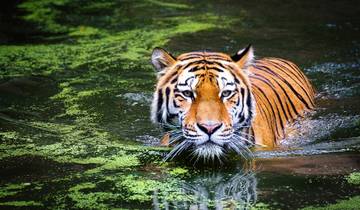
Bandhavgarh Kanha Pench Tour
Our family had a customized tour that included all three national parks for tiger safaris as well as the traditional golden triangle tour. We had 2 different drivers during the tour that picked us up at the airport or drove us to the next location. The drivers were always early, extremely friendly and helpful, and the cars were immaculate. We stayed at six different hotels that were picked out for us. They were all very nice and I would stay at them again. The guides at each location were very knowledgeable and friendly. The company itself stayed in contact with me throughout the trip to make sure I did not need anything. I would highly recommend this company. This tour was much more flexible and convenient than participating in a group tour where everyone has to keep up with a group pace.
- 10% deposit on some dates Some departure dates offer you the chance to book this tour with a lower deposit.

Taj, Tigers & Lakes - Golden Triangle Delhi Agra Jaipur with Ranthambore & Udaipur
Good trip plan , nicely executed . happy and satisfied

Adventures Ranthambore Wildlife Safari Tour with Golden Triangle 7Days
This trip was incredible, from day one our tour guide was amazing .. caring and very knowledgeable.. the actual your was also incredible.. thanks everyone who made possible this unforgettable experience!
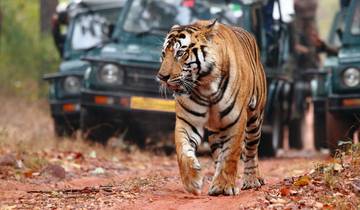
05 Days Golden Triangle Tour with Ranthambore Jungle Safari!!
The 5-day Golden Triangle with Ranthambore tour was an incredible blend of cultural immersion and wildlife adventure. From Delhi's historic charm to Agra's iconic Taj Mahal, and Jaipur's architectural wonders, each day brought new marvels. Ranthambore's safaris added a thrilling dimension, making this journey a perfect snapshot of India's diversity and beauty, And we are so glad that we choose the good travel agent [YOGANSHI TRAVEL].They planned this tour so beautifully,and we thanks to them...!!

Tiger & Tales : Delhi | Kanha | Bandhavgarh | Khajuraho | Orchha
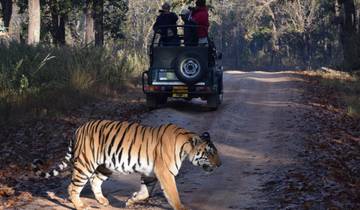
Bandhavgarh Ranthambore Tiger Tour

Royal Rajasthan Tour with Tiger (Ranthambore)
This was my third trip with World Travel Experiences in India (Royal Rajasthan with Tiger) . As always, a beautiful experience. Everything was simply perfect, the guides and the driver were all very friendly and always available to satisfy our needs and requirements (sometimes even changing the trip scheduling upon our requests). A special thanks to our driver Saheeram, who has been both an excellent driver and guide, but also a "friend"
- Book With Flexibility This operator allows you to rebook your dates or tours with them for free, waiving change fees.

From Delhi: North India, Taj Mahal and Ranthambore Wildlife Safari Private Tour
Glad to be a part of the well designed trip. Taj Mahal is a very old heritage building of India. Other monument was also a good to explore.
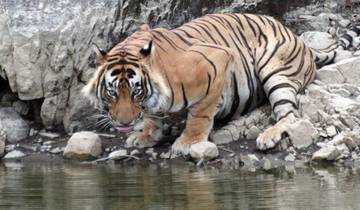
India Tiger Photography Tour
I enjoyed my tour through India organised by Holidays At very much despite the train delays due mostly to fog. The local representatives/ drivers were very helpful and their service was appreciated in particular linked to the waiting resulting of the delays for the pick ups and also for the translation Hindi/English. I also appreciated the selection of hotels which Holidays At made for my stay. My focus was on wildlife viewing which I was able to do even though in December/ January you do not have the highest chances to see Tigers. I saw Royal Bengal Tigers on this tour and other wildlife! All in all it was a great tour and I recommend it.

Essence of Rajasthan & Tiger - 11 Days
We hired Rajasthan Tour by car and driver for our 11 days tour of Rajasthan They offered us a free upgrade to a very comfortable and safe car - Toyota Corolla Altis, along with a very professional driver Mr Akash, who sadly had to interrupt the tour due to unforeseen circumstances. Mr Neeraj provided us immediately with another driver, Mr Mithun, and both did an excellent job. Our driver was always on time and very flexible to accommodate our requests, he also arranged stops for lunch or simply a tea. Mr Neeraj and his team are very reliable and professional.
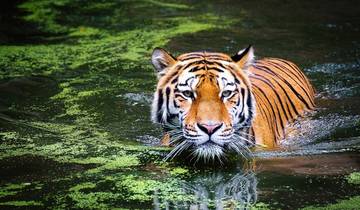
From Delhi: 7-Day Tiger Safari & Golden Triangle Tour
Thanks to the excellent services for Golden Triangle tour. My driver Mr. Raju, was not only a very good driver, but he took me everywhere I wanted to go and always offered suggestions along the way. Everyone should see the Taj Mahal it is beyond beautiful, although a bit crowed my guide knew right where to go to eliminate the crowds. The jeep ride safari in Ranthambore was not only a lot of fun, but it was exciting to see all the animals, especially the Bengal tiger. I travel to see historical sites, and India did not disappoint. The forts, temples and palaces are definitely worth seeing. My suggestion would be if you enjoy historical sites take the golden triangle tour - if you like adventure, visit Ranthambore (although a bit of a drive), and don't spend more than one day in New Delhi - the traffic and air quality is terrible

From Delhi: Golden Triangle Private Tour with Ranthambore
I had a great ranthambore tour with golden triangle tour. I had take couple of safari rides and saw the tiger once. Safari w Ride was adventurous. I also explored Taj Mahal which was main attraction and I visited Delhi and Jaipur. I enjoyed everywhere and tour guide was very good in each city.
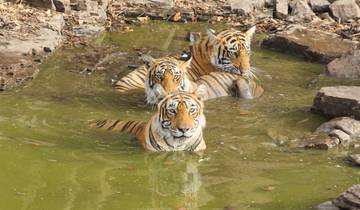
Ranthambore Tiger Experience 5D/4N (from Delhi)
Once at the hotel near Rathenbourne the trip was well planned and carried out. The young man who met us at the station, Arbaz, was courteous and on time. The hotel was lovely and the staff could not have been more helpful, even changing the menu for dinner to suit our western tastes. Arbaz was contactable throughout our stay and was always on time. He gave very good service and is a credit to the company. I would have liked a little more information about getting the train at Nizamuddin station, being prepared for such long trains would have been an advantage. Although there was a representative on the station platform he only made himself known to us once we had reached the carriage. On returning to Dehli Arbaz stayed with us on the platform until the train arrived. The other guide had a larger party and stayed with them. On reaching Dehli the taxi driver was waiting for us as arranged. Once in the taxi he was eager to show us the sights of Dehli and despite repeated requests to go to the hotel, he continued to ask about shopping/eating/which monuments we wanted to see and the journey from station to hotel took one hour and fifteen minutes and the traffic was clear. The hotel used for the end of the tour needs some consideration for the future. Although the room was lovely, even though it didn’t have a window, some of the staff were less than courteous. The breakfast offered was not suited to European guests added to which there was no coffee on offer. Most of the equipment was in need of a through clean.
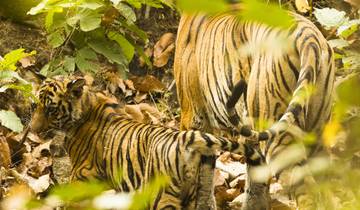
11 Days of India's popular wildlife Safaris with Romantic Taj Mahal Tour(ALL INCLUSIVE)
Looking for a once-in-a-lifetime adventure? Look no further! I recently went on the 11 Days of India's popular wildlife Safaris with Romantic Taj Mahal Tour, and let me tell you, it was an unforgettable experience. From thrilling safaris in some of India's most famous national parks to exploring the iconic Taj Mahal, this tour truly has it all. And the best part? It's all-inclusive, so you don't have to worry about a thing. The 11-day itinerary was perfectly planned, allowing us to see a variety of wildlife while also taking in the beauty and history of the Taj Mahal. The accommodations were top-notch and the guides were knowledgeable and friendly. If you're looking for a unique and exciting trip, I highly recommend this tour. It's truly an adventure of a lifetime!
What people love about Tiger Tours in India
We had a great time in India. The tour manager Mr. Amit was very responsive to all my questions and issues prior to the trip and was waiting for us to greet us at the first hotel. Our driver Mr. Vikram was great too. He was very professional and was always on time waiting for us each day. We absolutely loved our local guide in Jaipur. He was so professional, knowledgeable and quick that we felt we were very well taken care of. Now here’s the reason I can’t give 5 stars to this tour. It was the hotel in Jaipur and the local guide in Delhi. The hotel was not up to the standard of 3 stars at all. The bathroom was disgusting, moldy and gross. They called us around 10pm asking us to order room service both nights we stayed. It was the most horrible service that I have ever experienced at any hotels around the world. Now the local guide in Delhi, he made us decide to say goodbye after 3 hours. We never had a problem tipping people at all until the rickshaw ride (which was included in the tour). It was such a turn off moment for us when the guide asked us to tip them 200 for a 200 ride. He was also on the personal phone calls a lot, which made us feel that he really didn’t want to be there at all for us. We had to call it a day.
Pushpendre our guide was extremely helpful polite and informative He was keen to accommodate our needs and explain any issues we did not understand He was always pointing out things we may find interesting and to stop for photos We were very impressed by his driving skills Overall he enhanced our enjoyment of the trip Maureen and Alexandra
Regions in India
- Northern India (52)
- Rajasthan (29)
- Golden Triangle (6)
- Central India (6)
- Ranthambore National Park (5)
Travel Styles
- India Travel Guide | All You Need to Know
- 10 Best Trekking Companies & Operators in India (with 5,325 Reviews)
- 10 Best Backpacking Groups & Travel Agencies (with 1,857 Reviews)
- India for Female Solo Travellers - Is India Safe?
- Best 2 Week India Itineraries 2024/2025 (with Reviews)
- Just Tigers Tours
- Tigers & Other Wildlife
- Tigers & Culture
Luxury Safaris
- Testimonials & Reviews
- Media Coverage
- Tiger Safari in India – A Traveler’s Guide 2024
- Bandhavgarh National Park – A Traveler’s Guide 2024
- Jim Corbett National Park – A Traveler’s Guide 2024
- Kanha National Park – A Traveler’s Guide 2024
- Kaziranga National Park – A Traveler’s Guide 2024
- Ranthambore National Park – A Traveler’s Guide 2024
- Sariska National Park – A Traveler’s Guide 2024
- Pench National Park – A Traveler’s Guide 2024
- About Tigers
- Guest Gallery
The Most Experiential Tiger Safari India Journeys
Tiger safari india : most trusted wildlife tour operator in india, three decades of organizing bespoke tiger safari tours in india.
- Tiger Safari India is a unit of Nature Safari India. We specialize in conducting tiger safaris in India in the most popular national parks and also the lesser-known parks to develop the local economy of those areas with great care to preserve the local fauna and flora from harm and encroachment.
- We are the most experienced brand in the wildlife tours and travel sector of India with the expertise of arranging tiger tours for close to three decades. We have a time-honed understanding of Indian wildlife and Indian culture.
- We provide transformative travel, i.e. our wildlife safari tours in India will touch your soul and leave you changed. Constantly innovating and curating wildlife spots, interactions with the local populace, and their culture, we provide unforgettable wildlife safari experiences.
- Our motto of “WE SERVE, WE CONSERVE” is inclusive of our biodiversity, our guests, our team, our local community, and all our vendors.
- For your trust in us, we provide you with the best wildlife tour experiences, sparing no expense to ensure you have a great experience traveling with us.
- Recognized by the Ministry of Tourism, Government of India, Member of Indian Association of Tour Operators and Association of Domestic Tour Operators of India.

Best Tiger Safari Tours in India
The best package safari holidays recommended by tourists and nature enthusiasts
We have a number of tiger safari tour packages that span numerous popular tourist & wildlife destinations in India . The list below is highly recommended by tourists and nature enthusiasts, who have all embarked on a tiger safari tour in India through us

Tiger & Culture Tours
Tiger safari in central india with taj mahal tour, tour duration, 13 nights/14 days.

Tiger Safari India Tours
Kanha, bandhavgarh and pench tour, 12 nights/13 days.
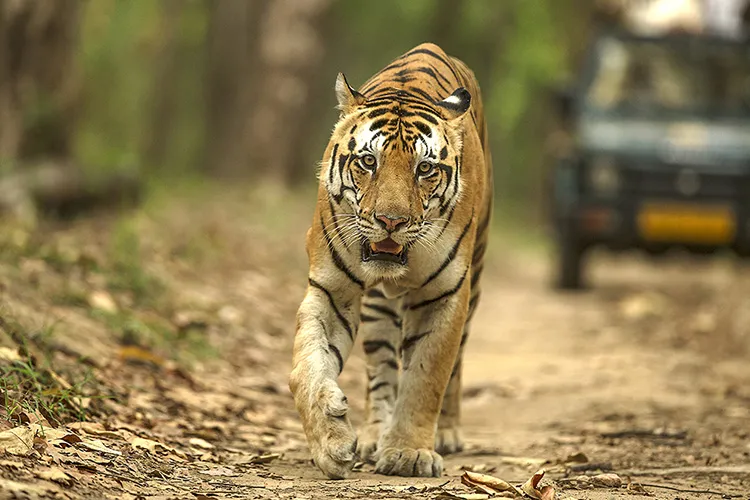
Luxury Tiger Safari with Golden Triangle Tour
14 nights/15 days.
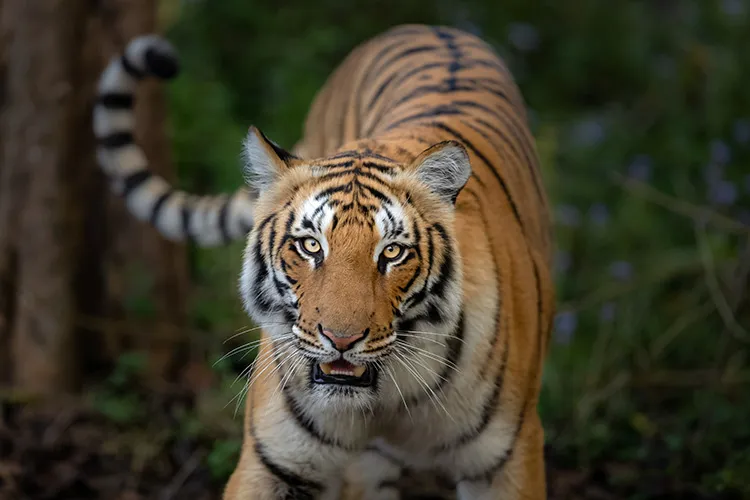
Kanha, Bandhavgarh & Corbett Tour

Tiger Safari, Taj & Temple Tour
19 nights/20 days.
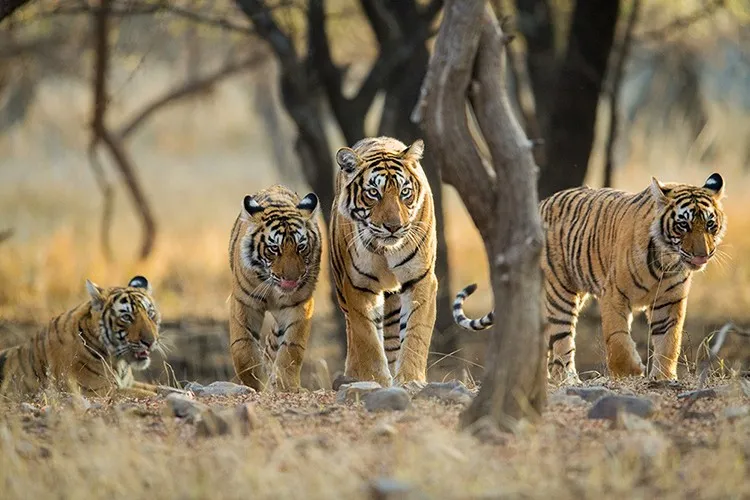
Luxury Tiger Safari and Cultural Tour in Rajasthan
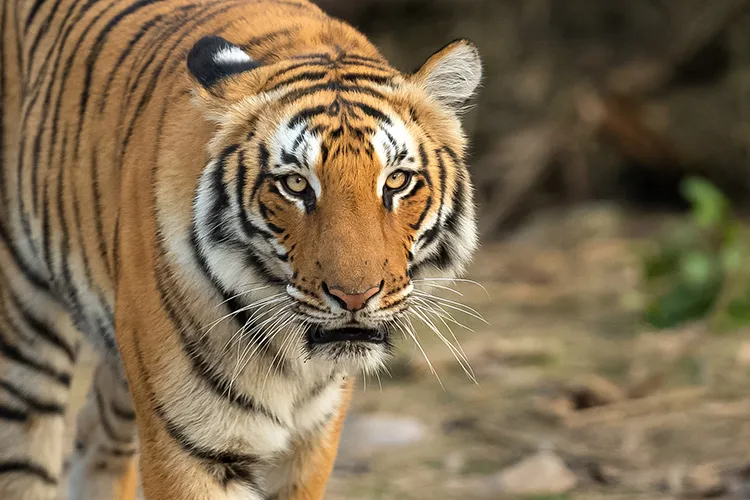
Tiger Safari in Corbett National Park
04 nights/05 days.

Tigers & Other Wildlife
The red panda and tiger safari tour, 10 nights/11 days.

Tiger Safari in Bandhavgarh National Park
05 nights/06 days, bespoke tiger safari india tours, tailored wildlife adventures.
Design your ideal wildlife expedition through India’s diverse landscapes. Select from a spectrum of national parks, tiger reserves, bird sanctuaries, and cultural marvels. Our expert team ensures every detail matches your preferences, from dietary needs, expert guides to transportation and language support. Let us curate the ultimate wildlife experience for you.
What all can be customized?
- Accommodation Preference
- Destinations
- Dietary Preference
- Transportation Options
- Special Interests
- Leisure Time
- Safari Vehicle
- Naturalist/Guide
- Photography Opportunities
- Nature Walks
Feel free to send us your customized requirements via the query form, or you can email us directly at [email protected] .
What you will experience with us.
Experience the best of Indian wildlife that includes the Royal Bengal Tigers , Asiatic Lions, Black Leopard, Indian Leopards, Snow Leopards, Red Panda, Asian Elephants a plethora of reptile and bird species, with experienced naturalists while you stay at the best-selected premium wildlife lodges and hotels.
More Reasons to Choose Tiger Safari India
Tiger Safari India, where the wilderness comes alive and unforgettable adventures await you. With over 30 years of experience and an unwavering passion for tigers & wildlife , we are renowned as one of the most trusted wildlife tour operators in India.
At Tiger Safari India, we specialize in creating extraordinary wildlife experiences, meticulously crafted to immerse you in the mesmerizing beauty of India’s diverse ecosystems. Our team of professional and experienced naturalists are dedicated to ensuring that every moment of your wildlife journey is filled with wonder and discovery .
We take immense pride in our handpicked selection of top-notch wildlife lodges and accommodations, carefully chosen to provide you with the utmost comfort and a seamless blend with nature . From luxurious jungle resorts to eco-friendly wilderness camps, we ensure that your stay is both enchanting and rejuvenating.
Seamless transport is a cornerstone of our service, as we understand that getting you to the heart of the wilderness is the first step to creating a remarkable wildlife experience. Our well-maintained vehicles and expert drivers ensure a safe and comfortable journey, allowing you to soak in the breathtaking landscapes along the way .
Tiger Safari India has earned the admiration and appreciation of thousands of guests from around the world. Our commitment to delivering exceptional wildlife encounters has made us a preferred choice for wildlife enthusiasts, professionals, and photographers seeking thrilling encounters with India’s iconic Bengal Tigers & other wildlife creatures.
We are renowned for our expertise in organizing tiger, leopard, snow leopard, Asiatic lion, red panda, and sloth bear safaris in India . Whether you aspire to witness the majestic tigers of Ranthambore, the elusive snow leopards of Ladakh, or the regal Asiatic lions of Gir, our carefully curated itineraries will take you to the heart of these incredible habitats.
At Tiger Safari India, we believe that every journey should be a once-in-a-lifetime experience. With our deep understanding of wildlife behavior and a commitment to responsible tourism, we ensure that your encounters are respectful, ethical, and unforgettable .
Embark on a transformative wildlife expedition with Tiger Safari India and discover the magic of India’s rich biodiversity. Let us create a tailor-made itinerary that fulfills your wildest dreams and leaves you with cherished memories that will last a lifetime .

Best Tiger Safari Reserves in India
Top destinations to catch the big cat in action...
There are over 600 national parks in India which are home to close to 200 endangered mammal species. The Royal Bengal Tiger is one of the flagship species as not only is it the apex predator of the very forests that thrive here, but it is also the biggest cat among its brothers. National Parks in India varies with varying tropics and landscapes. We have the dry deciduous forest of Ranthambore National Park in the western part of India while the evergreen Sal forest of Kanha National Park thrives in Central India. Corbett National Park is unique as it rests in the foothills of the Great Himalayan Range, making it an awe-stunning frame to capture. India has some of the most biodiverse lands making it a hotspot for wildlife and tiger safaris and nature enthusiasts.
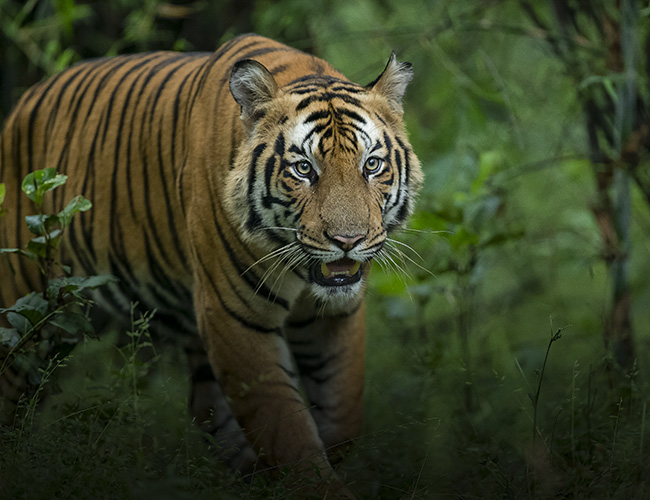
- Bandhavgarh National Park
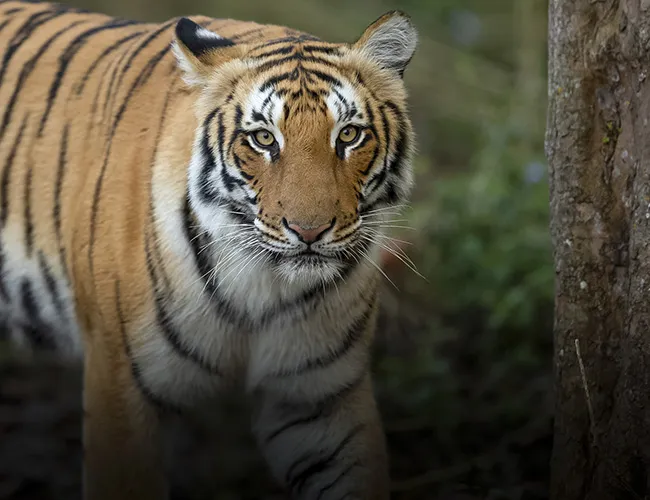
- Corbett National Park

- Kanha National Park

- Ranthambore National Park

- Tadoba National Park
Exclusive Tiger Safaris in India
On trails that resonate his roar...
At Tiger Safari India it is our endeavor to provide you with the best tiger safari holidays in India that have learning, adventure, and unlimited memories. We encourage you to store your experiences in form of videos and still photos which you will fondly go over at a later stage in life with friends, families, and your future generations.
While it is easy to capture people, landscapes, and monuments, capturing wildlife involves certain dynamics. The wildlife documentaries by channels are made with painstaking efforts covering months of filming in unhostile terrain, expensive equipment, special permissions from the authorities, weeks of post-production, and a great deal of resources. The end result is a dream setup. But this is not what you always see when you are on a tiger safari .
The videos below are shot by our team during a safari using a regular video camera, in a regular safari vehicle, no tripods, no extra permissions, and importantly during a 3-night stay in a national park. This is how you see tigers during a wildlife safari .
Guest Testimonials and Experiences
Consistently rated as the best by our guests on TripAdvisor

Our efforts have time and again been recognized by all our guests on TripAdvisor. With reviews that are 100% genuine, you can read them here or head on to our official TripAdvisor page to browse through in detail.
Tiger Safari India FAQs
Frequently asked questions.
Among the many national parks in India’s golden Triangle Zone, Kanha National Park and Ranthambore National Park offer incredibly fulfilling tiger tours. You get to visit many breathtaking locations and can embark on numerous types of tiger safaris. Read our blog on the best tiger reserves in India for tiger safaris .
The Jim Corbett National Park currently houses over 350 tigers of varying species. It is one of the largest and most densely populated tiger reserves in India . The park is frequented by tourists and is a major attraction among wildlife enthusiasts.
To know more about tiger tours in Jim Corbett National Park, contact Tiger Safari India.
Tiger safaris in India actually happen throughout the year, but it is recommended to plan a safari tour between the cooler months of October and March. Each and every National Park in India has dedicated tiger safari zones that remain open to the public in longer durations.
It is important to plan your tiger safaris in India a good five months in advance, as it will give top tiger tour operators, like Tiger Safari India , ample time to prepare the best possible trip for you.
The Kanha National Park, Bandhavgarh National Park, Ranthambore National Park and Jim Corbett National Park are the four most visited and most popular tiger reserves. Each park also brings with it a unique tiger safari experience. Bandhavgarh Tiger Reserve has the maximum tiger population and hence the chances of sighting increases.
Avoid bright colors and instead, pick a wardrobe of nature-inspired shades like greens and browns. Camouflage printed outfits are also a good option. Heavy jackets for winters as the temperature is lower in the jungle.
The Corbett Tiger Reserve is considered the best place to visit for a tiger safari experience as it accounts for the most number of tigers by population (over 252 tigers and counting) as of 2022.
The state of Madhya Pradesh is home to the most number of tigers. On the other hand, Corbett National Park & Tiger Reserve ranks the top with tiger count of 252 as of 2022. Read our blog on the Top 5 Tiger Reserves with the Highest Tiger Population in India .
Enquire Now
Please fill the form below and our team will get back to you within 24 hours with a perfect tiger safari tour package.
Recent Blog Posts

Indian Wildlife Safaris Rule Book – Rules, Tips & FAQs
Ishana Vats
October , 2023

Conservation through Tourism: Wildlife Preservation via Safaris
Deep Narayan

Top 5 Best Tiger Safari Tours in India – Book Wildlife Safaris in India
107, A-3 Pocket, 106, 3, Sector 11, Rohini, New Delhi, Delhi 110085, India
[email protected] [email protected]
Sharad Vats : +91-9811200094
Tiger Safari Tours
- Kanha Bandhavgarh Pench Tour
- Kanha, Bandhavgarh And Corbett Tour
- Big Cats of India Tour
- Tigers, Lions, and Leopards Tour
- Tiger Safari in Ranthambore
- Tiger, Taj and Leopard Safari Tour
- Indian Wildlife and Rajasthan Tour
- Tiger, Taj and Temple Tour
- Just Tigers and Taj Mahal Tour
Tiger Safari Destinations
- Dudhwa National Park
- Panna National Park
- Pench National Park
- Satpura National Park
- Tiger Tour Packages
- TripAdvisor Reviews
- Safari Travel Guides
- Do's and Don'ts
- Testimonials
Copyright © 2023 Tiger Safari India (A Unit of Nature Safari India Pvt Ltd)
Partners and approvals


Follow Playing Through online:
- Follow Playing Through on Twitter
- Follow Playing Through on Instagram
- Follow Playing Through on Facebook
Site search
- Champions Tour
- DP World Tour
- Latest News
Filed under:
Tiger Woods, Rory McIlroy relationship crumbling amid PGA Tour policy board drama
Tiger Woods and Rory McIlroy have grown apart in recent months as the PGA Tour tries to piece together its future.
Share this story
- Share this on Facebook
- Share this on Twitter
- Share this on Reddit
- Share All sharing options
Share All sharing options for: Tiger Woods, Rory McIlroy relationship crumbling amid PGA Tour policy board drama
/cdn.vox-cdn.com/uploads/chorus_image/image/73336872/1479464957.0.jpg)
Ahead of this week’s Wells Fargo Championship , Rory McIlroy spoke at length about the possibility of rejoining the PGA Tour Policy Board , from which he resigned in November.
He has grown “impatient” with the PGA Tour’s current negotiations with the Saudi Public Investment Fund (PIF) and believes that a deal must get done soon. McIlroy also believes golf’s current divide is unsustainable. Hence, the Northern Irishman felt his return would not only be welcomed but also help professional golf as a whole.
Current board members did not feel the same.
“It got pretty complicated and pretty messy, and I think with the way it happened, I think it opened up some old wounds and scar tissue from things that have happened before,” McIlroy said Wednesday.
“There was a subset of people on the board who were maybe uncomfortable with me coming back on for some reason. Yeah, I think that the best course of action is if, you know, there are some people on there who aren’t comfortable with me coming back on, then... I just sort of keep doing what I am doing.”
:no_upscale()/cdn.vox-cdn.com/uploads/chorus_asset/file/25440224/1709962026.jpg)
Patrick Cantlay , whom McIlroy has not had a friendly history with; Jordan Spieth , whom McIlroy disagreed with at the AT&T Pebble Beach Pro-Am over the PIF and at The Players over a drop ; and Tiger Woods, somewhat surprisingly, did not want McIlroy back, according to Joel Beall of Golf Digest .
Cantlay and Spieth’s hesitation to bring McIlroy on board is not surprising. But considering Woods and McIlroy will launch TGL together in 2025, the 15-time major winner’s dissent certainly raises some eyebrows.
In fact, Beall reports that the Woods and McIlroy relationship “has soured” over the past six months. Each player has a differing view of how professional golf should proceed into the future, with McIlroy championing the need for a world golf tour. He laid out this dream scenario in Dubai in January.
Woods, meanwhile, has not publicly laid out his visions for the future of the PGA Tour. Yet, at the Genesis Invitational in February, Woods said that the key stakeholders are assessing numerous options.
“We’re looking into all the different models for pathways back [for LIV Golf players],” Woods said in February.
:no_upscale()/cdn.vox-cdn.com/uploads/chorus_asset/file/25440226/2003722136.jpg)
“What that looks like, what the impact is for the players who have stayed and who have not left, and how we make our product better going forward, there is no answer to that right now. We’re looking at varying degrees of ideas and what that looks like in the short term, we don’t know. We don’t even know in the longer term what that looks like. Trust me, there are daily and weekly emails and talks about this and what this looks like for our tour going forward.”
On the flip side, McIlroy, who has previously said that he “hates” LIV Golf, has reversed course in recent months to resolve the divide. He wants all the same golfers playing alongside one another and would welcome back those who joined LIV Golf.
Perhaps that is where the difference in opinion between Woods and McIlroy lies.
Nevertheless, tensions between PGA Tour brass remain rocky, indicating that negotiations between the tour and the PIF remain far apart. Until the leading players of the PGA Tour can get on the same page, men’s professional golf will remain divided.
Jack Milko is a golf staff writer for SB Nation’s Playing Through. Be sure to check out @_PlayingThrough for more golf coverage. You can follow him on Twitter @jack_milko as well.
Next Up In Golf
- Nelly Korda puts 6th straight win in play amid strong Cognizant Founders Cup round
- LPGA: Rose Zhang dunks on Cognizant Founders Cup field with stellar golf
- Robert MacIntyre feeling “dangerous,” ballin’ at PGA Tour opposite field event
- Tiger Woods sends Angels’ Mike Trout a message as their golf course comes along
- Brandel Chamblee does about face, calls for PGA Tour deal with Saudis, LIV Golf
- Wells Fargo: Collin Morikawa attacks “big boy” course to sit near the top
Loading comments...
Sign up for the newsletter sign up for the playing through daily roundup newsletter, thanks for signing up.
Check your inbox for a welcome email.
Oops. Something went wrong. Please enter a valid email and try again.
- Election 2024
- Entertainment
- Newsletters
- Photography
- Personal Finance
- AP Investigations
- AP Buyline Personal Finance
- AP Buyline Shopping
- Press Releases
- Israel-Hamas War
- Russia-Ukraine War
- Global elections
- Asia Pacific
- Latin America
- Middle East
- Election Results
- Delegate Tracker
- AP & Elections
- Auto Racing
- 2024 Paris Olympic Games
- Movie reviews
- Book reviews
- Personal finance
- Financial Markets
- Business Highlights
- Financial wellness
- Artificial Intelligence
- Social Media
Tiger Woods to be lone player on negotiating committee with Saudis
Tiger Woods waves after his final round at the Masters golf tournament at Augusta National Golf Club Sunday, April 14, 2024, in Augusta, Ga. (AP Photo/David J. Phillip)
Tiger Woods hits from the bunker on the 15th hole during final round at the Masters golf tournament at Augusta National Golf Club Sunday, April 14, 2024, in Augusta, Ga. (AP Photo/George Walker IV)
Rory McIlroy, of Northern Ireland, reacts after making birdie on the 16th hole during the final round of the PGA Zurich Classic golf tournament at TPC Louisiana in Avondale, La., Sunday, April 28, 2024. (AP Photo/Gerald Herbert)
- Copy Link copied

Tiger Woods will be the lone player on a five-member subcommittee that will be involved in negotiations with the Public Investment Fund, part of a busy day of governance as the PGA Tour tries to strike a deal with Saudi backers of LIV Golf.
Woods was appointed to the PGA Tour board in August, making him the sixth player-director and the only one whose board term has no limits.
The tour said Woods will be part of the “transaction subcommittee” on the board of PGA Tour Enterprises that will handle day-to-day negotiations as PIF seeks to become a minority investor.
Also on the subcommittee are PGA Tour Commissioner Jay Monahan, board chairman Joe Gorder, John W. Henry of Fenway Sports Group and Joe Ogilvie, a former tour player appointed as a director liaison in March.
The subcommittee reports back to the full board.
The developments capped a day that began with Rory McIlroy losing the inside track on rejoining the board as Webb Simpson’s replacement when board members resisted his return.
“I think there was a subset of people on the board that were maybe uncomfortable with me coming back on for some reason,” McIlroy said at the Wells Fargo Championship in Charlotte, North Carolina, where a $20 million signature event is being played.
Simpson had offered to resign, but only if McIlroy were to replace him. When a player director resigns, the other players on the board have to unanimously agree on a successor. McIlroy resigned from the board in November , and the players selected Jordan Spieth to replace him.
The seven players — Woods, Spieth, Simpson, Ogilvie, Patrick Cantlay, Adam Scott and Peter Malnati — are on the board of the PGA Tour and PGA Tour Enterprises, the commercial entity that agreed to a deal with Strategic Sports Group as a minority investor.
That deal included a $1.5 billion investment, which could be as much as $3 billion.
McIlroy was willing to return, believing he could help find a solution to the split in golf that has left some of the best players on two tours. McIlroy sees the reunification in some form as the ultimate goal and rubbed players the wrong way when he suggested earlier this year that LIV players return without punishment.
“Today’s news is in no way a commentary on Rory’s important perspective and influence,” Monahan said in a statement. “It’s simple a matter of adherence to our governance process by which a tour player becomes a board member.
“Webb remaining in his position as a member of the policy board and PGA Tour Enterprises board through the end of his term provides the continuity needed at this vital time,” he said. “We are making progress in our negotiations with the PIF.”
McIlroy is certain to stay involved in an unofficial capacity based on his experience of two years on the board and his voice in the game. He was the only European tour member on the PGA Tour board, and McIlroy has cultivated relationships across continents during his career.
He had said on a British soccer podcast at the start of this year that he met with the PIF governor, Yasir Al-Rumayyan, at the DP World Tour Championship in Dubai in late 2022 and that he returned home and encouraged the tour board to meet with him.
The framework agreement among the PGA Tour, European tour and PIF was announced June 6, with a deadline to finalize it by the end of 2023. Negotiations continue with little progress.
Woods was among the player directors who went to the Bahamas on March 18 — Monahan and Henry also attended — to meet with Al-Rumayyan.
Woods said at the Masters about that meeting, “I don’t know if we’re closer, but certainly we’re headed in the right direction. That was a very positive meeting, and I think both sides came away from the meeting feeling positive.”
Gorder is the chairman and CEO of Valero, the title sponsor of the Texas Open. He has been appointed the inaugural chairman of the PGA Tour Enterprises board.
AP golf: https://apnews.com/hub/golf

- SI SWIMSUIT
- SI SPORTSBOOK
Tiger Woods Will Help Negotiate With LIV Golf's Backer In Continued Try for Deal
Bob harig | may 8, 2024.

On a busy day that saw Rory McIlroy say he believed current player directors on the PGA Tour Policy Board were uncomfortable with him returning to that role , Tiger Woods emerged as the lone player on a group that will negotiate directly with the Public Investment Fund of Saudi Arabia.
Woods will be part of a five-member “transaction subcommittee,” according to the PGA Tour.
The Associated Press was the first to report the development Wednesday.
Woods, who joined the board last August in the aftermath of the surprise “framework agreement” that PGA Tour commissioner negotiated in secret with the PIF, is one of six player directors but the only one who does not have a set term.
Also on the subcommittee are Monahan, board chairman Joe Gorder, John W. Henry of Fenway Sports Group and Joe Ogilvie, a former tour player appointed as a director liaison in March. The subcommittee reports back to the full board, according to the AP.
Earlier, McIlroy disclosed that he was willing to rejoin the board that he left in November after being asked by Webb Simpson—who wanted to step down and have McIlroy take his place.
But unanimous board approval is required and McIlroy said there was resistance from some to his returning. Simpson subsequently said he will serve the remainder of his term.
“Today’s news is in no way a commentary on Rory’s important influence,” Monahan said in a statement given to Sports Illustrated via the PGA Tour. “It’s simply a matter of adherence to our governance process by which a Tour player becomes a board member.
“Webb remaining in his position as a member of the Policy Board and PGA Tour Enterprises Board through the end of his term provides the continuity needed at this vital time. We are making progress in our negations with the PIF and are working as a collective—the Player Directors, our Boards and Tour management—to remain open-minded to all avenues that advance the Tour in the best interest of our players, our partners and, most importantly, our fans.”
The original intent was to have a deal with the PIF—which backs the LIV Golf League—by Dec. 31. But that deadline passed and the PGA Tour subsequently made a deal with the Strategic Sports Group, a private-equity company of high-end sports and business owners, with an initial investment of $1.5 billion. The Tour has since announced equity shares that will vest over time to the players.
“I think there was a subset of people on the board that were maybe uncomfortable with me coming back on for some reason,” McIlroy said at the Wells Fargo Championship, which begins Thursday.
Woods has said previously he wants to preserve the PGA Tour in its present state. But he met with PIF governor Yasir Al-Rumayyan along with other player directors in March and commented briefly on it at the Masters , saying “we’re headed in the right direction.”
McIlroy has expressed frustration over the slowness of the negotiations.

Bob Harig is a golf writer for SI.com and the author of the book "DRIVE: The Lasting Legacy of Tiger Woods," which publishes in March and can be ordered here.
Follow si_golf
We've detected unusual activity from your computer network
To continue, please click the box below to let us know you're not a robot.
Why did this happen?
Please make sure your browser supports JavaScript and cookies and that you are not blocking them from loading. For more information you can review our Terms of Service and Cookie Policy .
For inquiries related to this message please contact our support team and provide the reference ID below.

IMAGES
VIDEO
COMMENTS
Common tiger tourism activities . There are two main tiger tourism activities: petting tigers and tiger selfies. Both of these are extremely damaging to tiger conservation. Petting tigers. In most cases, the tigers used for petting experiences are cubs that have been speed bred and removed from their mothers too soon.
Tiger tourism refers to the practice of visiting national parks and wildlife sanctuaries that are home to wild tigers, with the primary goal of observing and experiencing the majestic animal in its natural habitat. The main purpose of tiger tourism is to promote conservation efforts and raise awareness about the endangered status of tigers.
For $10, tourists can pose with this tiger at Phuket Zoo, in Thailand. Examples of souvenir photos are displayed here on a poster board. The tiger is held by a short chain and can't stand up.
Increasing awareness of the animal's plight is one component of conservation efforts, and tiger tourism is part of this. It started slowly, but has grown greatly. Tiger reserves receive tens to ...
Made famous by the Netflix series, Tiger King, tiger tourism is an incredibly lucrative industry in the United States which profits from the exploitation of captive big cats. For a price, visitors to the numerous wild animal parks and touring fairs across the states can pet tiger cubs, have their photos taken with these animals, and watch them ...
In a shocking discovery, Thai wildlife authorities have recently uncovered dozens of dead tiger cubs and hundreds of other tiger parts at the infamous Thailand Tiger Temple. The temple, a popular tourist attraction, has been closed to the public since Monday, May 30, when the Thai Department of National Parks, Wildlife and Plant Conservation ...
Credit: Aravind Ramamurthy. A new study by the Centre for Wildlife Studies supports the idea that for tourists in India's nature reserves, tigers are the biggest drawcard. "Since nature ...
Journalists, tiger lovers and the authors friends, almost all seemed united in their antipathy towards wildlife tourism. It was an echo of the events of 2012 when the Supreme Court closed tiger reserves for tourism for a period and much was written in the press about the negative impacts of tourism. This has always made me wonder.
Tiger tourism is a complex issue that requires careful consideration of its impact on the environment, the wildlife, and the local communities. While it can have positive benefits for conservation efforts, it is important to ensure that it is done in a responsible and sustainable manner.
Ecotourism or sustainable tourism is an effective conservation tool. Recently increasing trends in visitations to protected areas (PAs) in India particularly, tiger reserves (TRs) have been documented. A questionnaire survey was carried out to objectively investigate visitor experience in three high profile tiger reserves (n = 684). Information on the role of nature interpreters, media and ...
We Design Tourism Websites That Sell Tours. Tourism Tiger designs travel & tourism websites that are effective from day one, and our ongoing updates ensure they stay effective. As dedicated tourism specialists, our focus has allowed us to develop the best possible website features for tour and activity businesses, creating tour & travel ...
As tiger numbers are relatively high within CNP, our study was aimed at assessing the impact of WLT on tiger conservation. A total of 151 locals, tourists, tourism operators, park officials and ...
Tiger Tourism in National Parks of India. India has 104 national parks, 52 tiger reserves, and 550 wildlife sanctuaries. Lot of tiger reserves are national parks, but not all national parks are tiger reserves. Tiger Tourism in India is possible only where one has some infrastructure like lodges, guides, and safari vehicles.
reserves, the increase in tiger tourism has actually resulted. in 'waves of tiger-sig hting f renzy… where tig ers are chased. and surrounded by je eps a nd elephan ts fo r pho to-ops, with.
The result: Visitors have a better chance of seeing — and photographing — a tiger, without causing harm in the process. Here, then, are 15 of the best — and most ethical — places to see tigers in the wild. 1. Bandhavgarh National Park, Madhya Pradesh, India. A Bengal tiger in Bandhavgarh National Park.
Tiger Tourism potential in Cambodia . The opportunity to see tigers in the wild via managed tourism sites will no doubt attract visitors to Cambodia, as in India. This opportunity gives tourists a reason to extend their stay in the Kingdom beyond paying a visit to Angkor Wat, which has been an ambition of the Ministry of Tourism for some time. ...
Tiger-centric tourism in many tiger reserves has prevailed over the enjoyment of watching other wild animals and birds. This fixation results in the crowding of tourist vehicles along those roads where the chances of tiger sightings are high. Tourists always insist on getting special viewings of this magnificent species.
The study comes out with an economic valuation of Tiger tourism in RTR. The research also studies how the tiger economy is contributing to the environment and economy of nearby regions. It is an ...
Sustainable tiger tourism is a type of ecotourism that supports the conservation of tigers and their habitats in a responsible and sustainable manner. It is characterized by practices that minimize negative impacts on the environment and wildlife, and prioritize the well-being of local communities and the long-term viability of tiger ...
And so, Tourism Tiger was born. My wife Rebeca and I hit the ground running in January 2015 with a mission to build great websites for tour and activity operators that are effective from day 1 and STAY effective in the years that follow. Rebeca's design skills and my expertise in tourism marketing and SEO proved the perfect combination to get ...
A Day in the Life of Tourism Tiger. When it comes to learning more about the people behind Tourism Tiger, we're much more than just the photos and names you see on our about us page. Going through our blog you can gain insight into our blog team, and when you work with us on a project you'll get to know our content creators and designers ...
From Delhi: 7-Day Tiger Safari & Golden Triangle Tour. It was an outstanding multi day tour which includes a visit to Taj Mahal and a bit of adventure in Ranthambore with tiger safari ride. Everyone was very nice , our driver Prakash , tour guide in each city specially in Agra. Lovely people and a mesmerizing tour.
Tiger Safari India, where the wilderness comes alive and unforgettable adventures await you. With over 30 years of experience and an unwavering passion for tigers & wildlife, we are renowned as one of the most trusted wildlife tour operators in India. At Tiger Safari India, we specialize in creating extraordinary wildlife experiences ...
Tiger Woods and Rory McIlroy have grown apart in recent months as the PGA Tour tries to piece together its future. By Jack Milko Updated May 9, 2024, 12:56pm EDT / new
Rory McIlroy, Tiger Woods, Adam Scott join PGA Tour subcommittee that will negotiate with Saudi Arabia's Public Investment Fund. Under-the-radar Myrtle Beach Classic debuts on PGA Tour with Beau Hossler, Robert MacIntyre tied for lead. Most Popular. Hello friends: Jim Nantz built a new backyard hole that is an homage to Augusta National's 13th ...
Tiger Woods will tee up at the US Open for the 23rd time after accepting a special exemption to play the 124th edition of the major on Thursday. ... a two-year exemption on the PGA Tour and a spot ...
The framework agreement among the PGA Tour, European tour and PIF was announced June 6, with a deadline to finalize it by the end of 2023. Negotiations continue with little progress. Woods was among the player directors who went to the Bahamas on March 18 — Monahan and Henry also attended — to meet with Al-Rumayyan.
Tiger Woods Calls PGA Tour/LIV Golf Bahamas Meeting 'Positive' But Deal Remains Distant. 2024 PGA Championship Field Includes Tiger Woods, All of World's Top 100 Players.
Tiger Woods is the sole player on the PGA Tour's negotiating team Credit: Getty Images/Warren Little The DP World Tour is still waiting to be granted an exclusive place at the negotiating table ...
The PGA Tour said Joe Gorder was elected chairman of PGA TOUR Enterprises, its commercial venture that secured up to $3 billion of funding in January from a group of US investors.